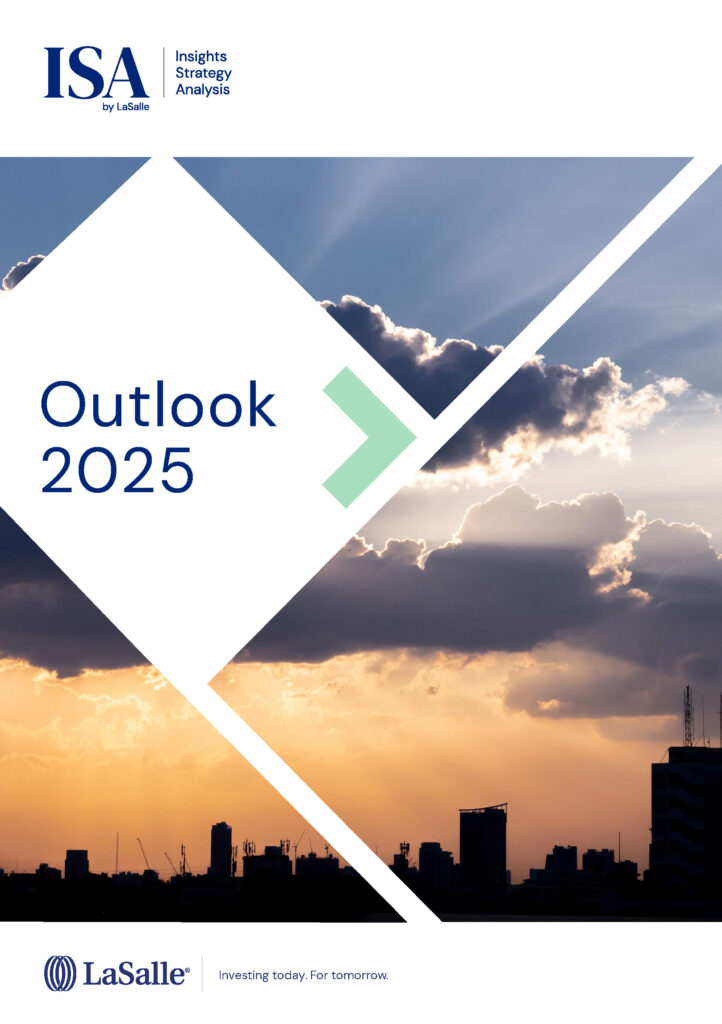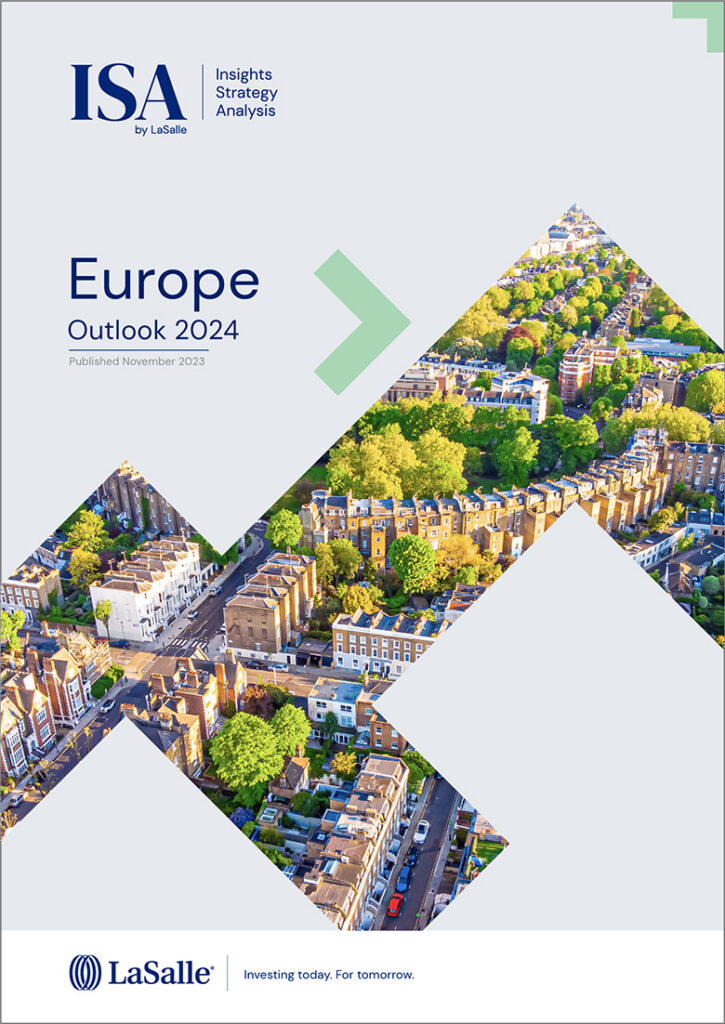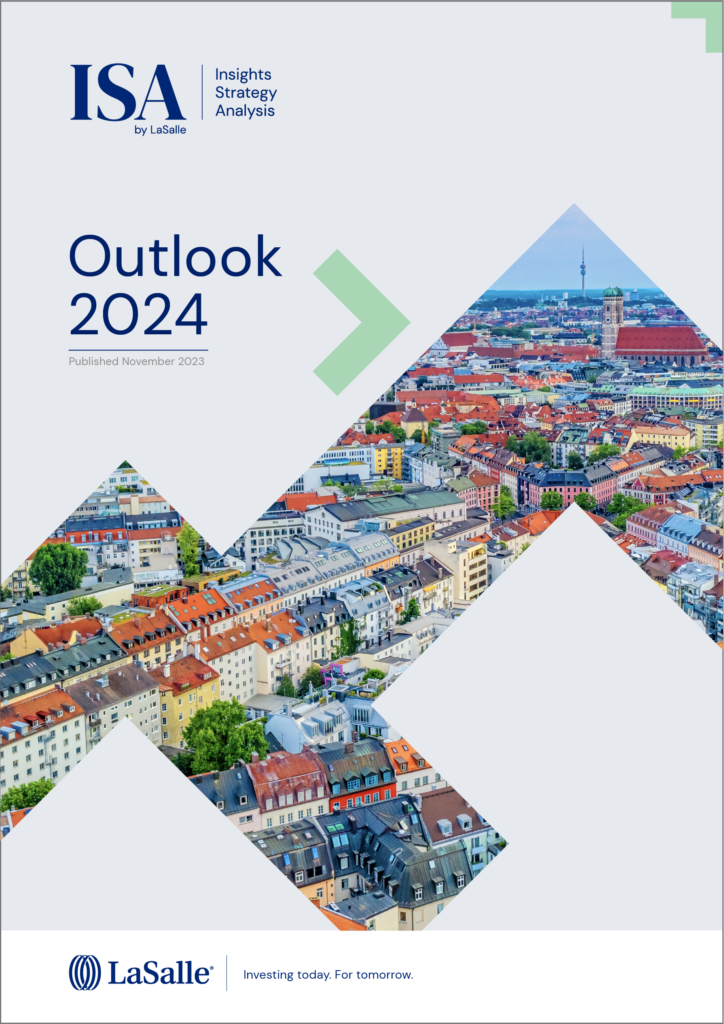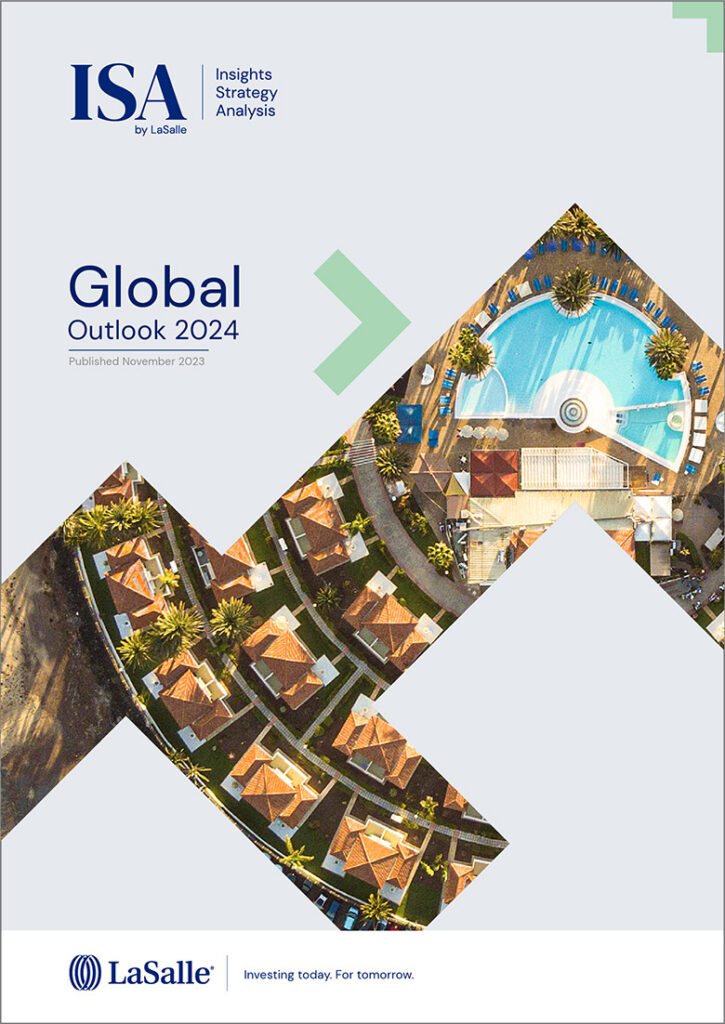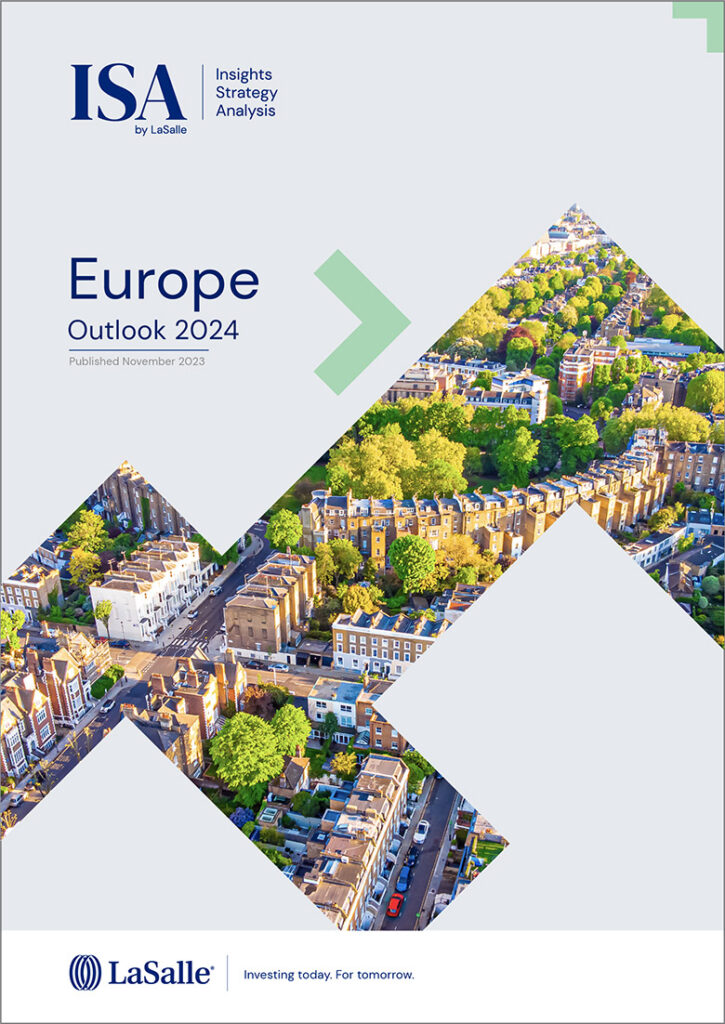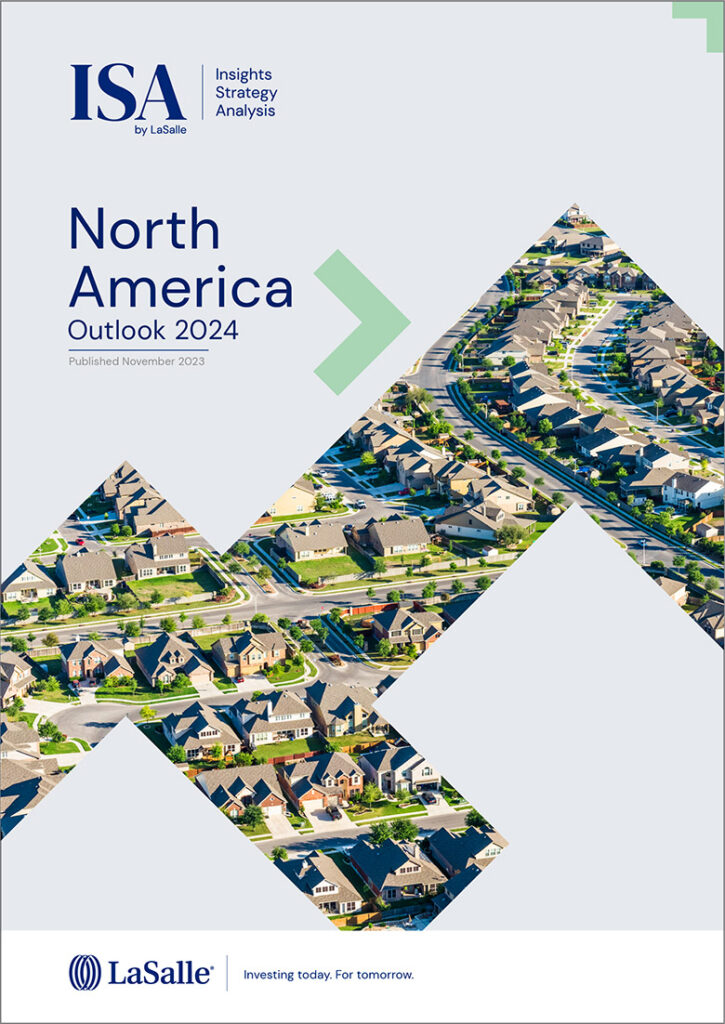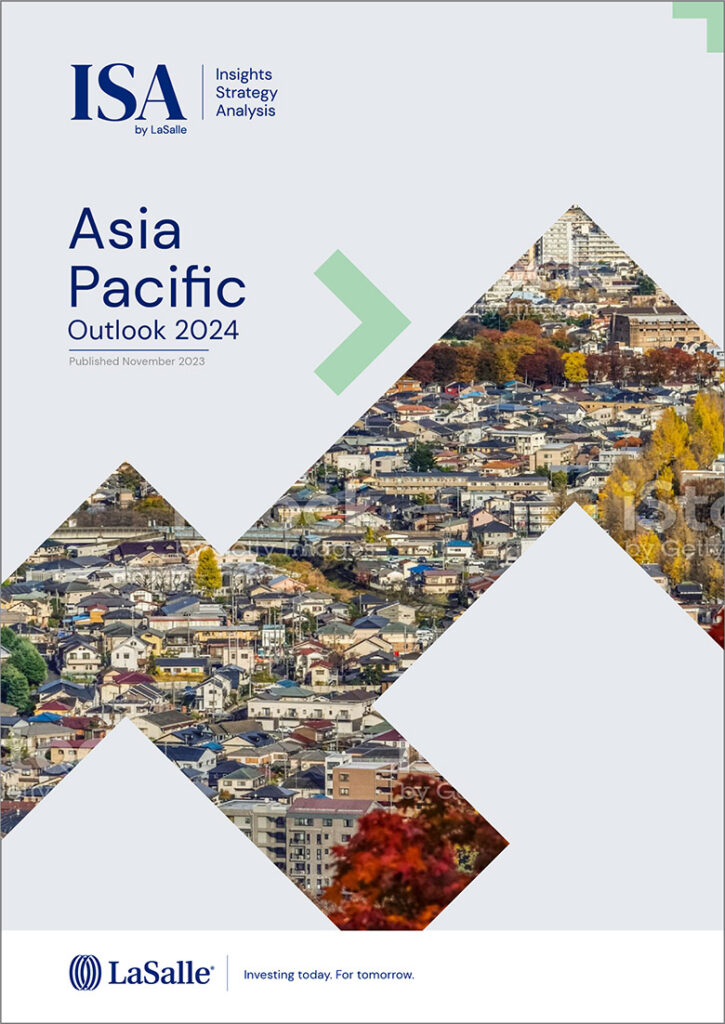
Breaking economic patterns: Europe’s real estate landscape
Today’s European market view is of a picture scarcely imaginable a few years ago.
2025 in Europe has a macroeconomic backdrop scarcely imaginable a few years ago: German stimulus spending, Greece in budget surplus and historically reliable real estate correlations – such as that between GDP and prime rents – behaving differently. And that’s on top of still to-be-determined new tariffs faced by Europe’s exporters. As we’ve shared in our recent ISA Briefings, it is helpful to “work backwards” to investment strategy based on what is actionable amidst all the noise.
Initial bond and currency market reactions, several highlighted in our latest Europe Market View, imply a relative shift towards Europe as a safe haven. These changes are having ripple effects for European real estate. Easing eurozone borrowing costs have made debt more accretive to go-forward returns, supporting a cautious recovery in investment activity. A stabilization in real estate yields, and the return of yield compression in some segments, are signs of the beginning of a new real estate cycle. The MSCI Europe Property Index capital values have increased for two consecutive quarters following eight quarters of decline.
Europe all property inflation-adjusted rent growth has now been positive for six quarters. The wider office market is undergoing a rebalancing cycle with slowing building starts and rising conversions of obsolete offices to other uses helping to keep markets in balance. Conversions in Europe reached 1.4% of stock in 2024 compared to the long-term average of 0.9% p.a.
We graph these trends in our latest LaSalle Europe Market View chartbook. We also look ahead to sharing our ISA Outlook 2025 Mid-Year Update, as we move into the second half of an eventful year.
Want to read more?
Want to read more?
The what, why and how of Industrial Outdoor Storage (IOS)
Industrial outdoor storage (IOS) real estate is not new, but it has only recently been given a name and a place in institutional investment portfolios. Some in the market define IOS inexactly, or even as they “know it when they see it”. A more precise definition is that it encompasses open-air facilities used by industrial, manufacturing or logistics businesses to store or process equipment, vehicles, materials or products that do not require the protection of warehouse buildings.
IOS is an amalgam of facilities that serve auxiliary but essential functions to the logistics ecosystem. The prominent features of IOS are low site coverage (with FAR1 of less than 20-25% but often zero), zoning designations that allow for heavy industrial uses, and most importantly, value that is driven by underlying land rather than physical structures2. Attributes that are commonly considered in the evaluation of IOS sites include the quality of surfacing (full concrete surfacing to softer gravel surfacing), good vehicle access (light and heavy), and availability of utility and services (water, electricity, fencing/security).
IOS started gaining traction among institutional investors following the industrial sector’s boom in the post-pandemic era. As industrial pricing became more aggressive through the peak of the cycle, the IOS sector’s robust demand growth outlook provided an attractive alternative for investors seeking yield. Interest in IOS remained strong even when the broader capital market entered correction. This has continued in the context of the industrial sector broadly softening as it digests a (now resolving) wave of deliveries, while IOS has proven resilient given that its new supply tends to be much less elastic.
Despite its adjacency to the traditional industrial sector and its proven relevance to users, IOS as a property type has flown under the radar of institutional investors as it is usually transacted in small deals that are local or regional in nature, often involving owner occupiers. There are a few dedicated IOS players whose inceptions date back as early as 2013, but it is only in recent years that the sector came to be viewed as a critical component of the wider supply chain and distribution network.
The body of knowledge on the sector – operational, fundamentals, performance – is limited, but curiosity has been rising from new entrants in the past couple of years that include institutional capital. The IOS sector’s lack of transparency, common in emerging specialty sectors, demands rigorous scrutiny in underwriting. As IOS continues to mature, detailed research and underwriting as well as deep engagement with the local market can help navigate these challenges, enabling investors better assess and mitigate risks.
‘Next-core’3 in the US, emerging in the UK and continental Europe
In the US, the aggregate market value of IOS property is commonly estimated to be $200 billion in GAV, but the source of that stat as well as the inclusions and exclusions behind it are unclear.4 While institutional investment in IOS has accelerated in recent years, the sector’s overall ownership remains fragmented with a still-limited institutional footprint.
Meanwhile, IOS is even more nascent among institutional investors in the UK and Europe, but interest is growing. An increasing number of institutional investors are now setting their sights on IOS opportunities across the region. This includes funds dedicated exclusively to IOS, as well as vehicles that incorporate the sector as part of a wider industrial strategy. We estimate that more than £1 billion has either been allocated for investment or has already been deployed into the UK’s IOS sector in recent years. Owing to structural factors, we see much more limited, but not zero, potential for IOS to emerge in the Asia-Pacific region (see below).
Types of/use cases for IOS
Service-oriented
• Equipment rental & maintenance
• Construction materials & staging
• Waste management & recycling

Transport-oriented
• Port logistics & intermodal transport
• Vehicle storage & parking
• Freight distribution & cross-docking

Storage-oriented
• Construction equipment & bulk material storage
• Vehicle or equipment fleets

Source: LaSalle analysis; images created with the assistance of AI
Truck terminals are the only type of IOS that is now explicitly defined in the NCREIF Property Index (NPI, previously “Expanded NPI”), with $5.3 billion in gross market value, or 1.8% of the US industrial index as of 1Q 2025.5 Tracking of other types of IOS is still a work in progress, although the NCREIF Research committee acknowledges the challenge, and has started the process of putting together guidance on how IOS should be classified and tracked to improve transparency. Investors’ desire to gauge the competitor landscape as well as returns supports this effort to define and track IOS as a distinct category in the NPI.
In Europe, there is still a lack of data availability for IOS, but some agents are extending coverage to the sector and starting to publish market data. For example, new data from late 2024 reported that 48% of enquiries for IOS space in the UK was driven by the need for fleet parking, approximately 60% of which was driven by Heavy Goods Vehicle (HGV) parking.6 This need can also be seen in data from a national survey of lorry parking, which reported a 5% increase in the number of on-site parking facilities between 2017 and 2022, even as the national average night on-site utilization at those facilities grew by nine percentage points over the same period to 83%, indicating strong growth in demand and a high occupancy rate for parking spaces.7
Is IOS “a thing” in Asia Pacific?
The Asia-Pacific IOS sector is evolving and yet to be institutionalized. High land values in many Asian markets make low- or no-coverage land sites uneconomic, at least beyond a temporary use. That said, the factors that drive IOS demand in the US are clearly present in the region, especially the need operational flexibility in handling trailers, containers and delivery vehicles, as well as flexibility to store overflow inventory. The confluence of Japan’s acute truck driver shortage and the implementation of stricter truck driver working hour regulations in 2024 is driving demand for specialized IOS-related assets in the long-term, particularly truck terminals. However, in most markets we view these factors as informing improvements to the design of existing multi-story logistics facilities, rather than driving the emergence of a new, investable specialty property type, at least in the near term.
Using a non-traditional data source to identify IOS inventory in the UK
Geographical distribution of UK open storage land vs. warehouse space

Sites classified by VOA as land used for storage and lorry parking are indicated in black, with traditional industrial and warehouse space displayed as a heatmap in red
Data on IOS fundamentals are very limited in the UK and Europe. At least there is a way to estimate the size and shape of the IOS footprint in England and Wales, where the Valuation Office Agency undertakes detailed categorizations of use cases across property types to set business rates, including categories for open storage and lorry parking.i Proprietary analysis of these data by LaSalle identified some 29,000 locations, with a total area of 16,700 acres and an average size of 0.57 acre.ii The locational pattern (black on the map) is correlated with, but generally more broadly dispersed than, the distribution of traditional logistics space (red on the map). This analysis does not capture the entire UK IOS universe, but still highlights the significant size if the opportunity available within UK IOS, and can support investment decisions requiring a view on supply in markets and submarkets.
i Source: Valuation Office Agency
ii It must be noted that this approach likely misses a sizeable proportion of IOS that is currently classified within the warehouse category by the Valuation Office Agency, especially where the site itself is dominated by an open space but have a structure making up a smaller portion of overall area.
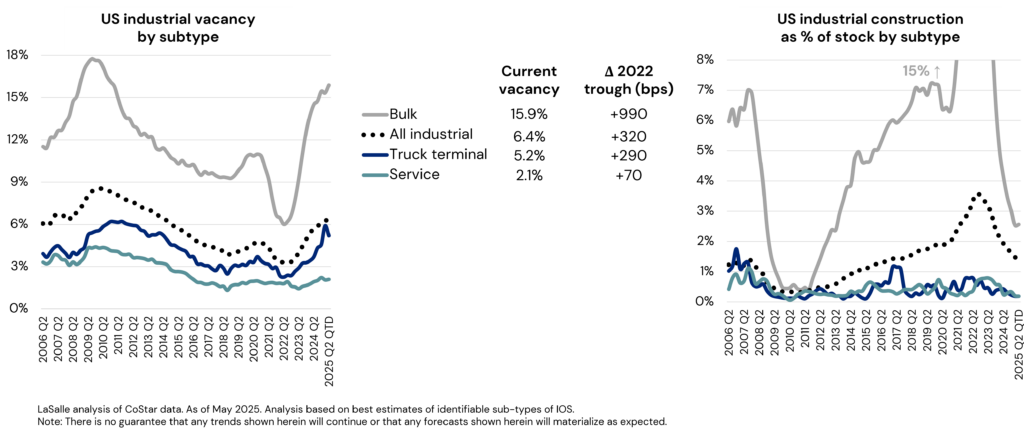
Joint ventures structured between institutional investors and specialized operators have been a common avenue for deploying capital into IOS. The challenges of limited transparency, as well as the transactional and operational inefficiencies of small deals, are factors that motivate partnerships with operators. However, the day-to-day operation of IOS is more like traditional industrial than a more operationally intense sector (such as self-storage). In addition, IOS portfolios of scale are currently rare compared to traditional industrial, but we expect greater consolidation of ownership as the sector matures. The assembly of institutional-scale portfolios, along with development of third-party leasing and management service providers, should support the sector becoming more “mainstream” over time.
IOS fundamentals are tight and resilient
Data on historical industrial fundamentals illustrates consistently lower vacancy and reduced volatility for IOS assets like truck terminals and service facilities, compared to larger industrial buildings (see adjacent charts). The sector benefits from a weaker elasticity of supply, stemming from stringent zoning regulations and community resistance to new IOS facilities. Local municipalities are hesitant to approve them due to the perceived unappealing aesthetics of open-air industrial operations, and an assumption that they have limited potential for generating jobs and taxes. Data challenges remain in holistically assessing fundamentals of IOS sector that take multiple forms; however, the available data suggest a superior track record of fundamentals as well as outlook that is better protected from future development risks.
LOOKING AHEAD >
Several key attributes of IOS suggest it is well positioned to perform strongly:
• Tailwinds of the broader industrial sector: The growth of e-commerce and an emphasis on just-in-time delivery have boosted demand for strategically located industrial service facilities. Whether as a point of transfer, servicing freight vehicles or serving as supplementary outdoor warehousing, various stages of logistics operation require IOS sites. These should be in close proximity to the industrial clusters and population that they serve, and are often infill locations.
• Favorable supply dynamics: New development is limited due to the scarcity and high cost of suitable land — i.e., large sites with the appropriate zoning in proximity to population centers. Stringent zoning regulations and community resistance to new facilities — due to concerns such as noise pollution, increased traffic, and environmental impact —further create barrier to entry. This is a differentiator as compared to traditional industrial, which is currently experiencing softer fundamentals due to a recent supply wave.
• Operational resilience: IOS facilities typically present low operational risks for investors. The simplicity of these assets, usually combined with triple-net lease structures that place maintenance responsibilities on tenants, result in minimal capital expenditures and higher cash returns. The limited availability of alternative facilities contributes to high tenant retention rates, enhancing cash flow stability. The impact of tariff-driven uncertainties on IOS is expected to vary. While port and trade-linked IOS sites are more exposed, those serving local populations should demonstrate more resilience.
• Increasingly liquid and institutional: As recognition of the attractive value proposition of IOS grows, partnerships between institutional capital and professional operators to invest in it are being launched. This is not only likely to improve the management of assets, but should also provide a track record of sector performance. We anticipate a gradual compression of the yield spread between IOS and traditional industrial properties, supported by continued institutional capital flow to the sector and falling perceived risks.
1 FAR refers to floor-area ratio, which measures the relationship between land area and internal building area.
2 Source: JLL Research 2023.
3 Under the LaSalle Going Mainstream framework for maturation of niche sectors. “Next-core” is characterized by professionalization where specialists begin to track performance, transparency is rising, and the income quality is proven.
4 GAV refers to Gross Asset Value. The origin for this widely cited number appears to be the PwC Investor Survey.
5 Source: NCREIF 4Q 2024. NCREIF refers to the National Council of Real Estate Investment Fiduciaries and publishes indices tracking the performance of real estate in the US directly held by institutional investors and by institutional funds. Launched in 1Q 2024, the Expanded NCREIF Property Index (NPI) encompasses a wider array of property sectors and subtype designations than the Classic NPI, aimed at aligning performance measurement with the broader industry’s investable universe.
6 Source: Carter Jonas 2024
7 Source: UK Department for Transport
Important Notice and Disclaimer
This publication does not constitute an offer to sell, or the solicitation of an offer to buy, any securities or any interests in any investment products advised by, or the advisory services of, LaSalle Investment Management (together with its global investment advisory affiliates, “LaSalle”). This publication has been prepared without regard to the specific investment objectives, financial situation or particular needs of recipients and under no circumstances is this publication on its own intended to be, or serve as, investment advice. The discussions set forth in this publication are intended for informational purposes only, do not constitute investment advice and are subject to correction, completion and amendment without notice. Further, nothing herein constitutes legal or tax advice. Prior to making any investment, an investor should consult with its own investment, accounting, legal and tax advisers to independently evaluate the risks, consequences and suitability of that investment. With reference to the graphs included in this publication, note that no assurances are given that trends shown therein will continue or materialize as expected. Nothing herein constitutes a guarantee or prediction of future events or results and accordingly the information is subject to a high degree of uncertainty. LaSalle has taken reasonable care to ensure that the information contained in this publication is accurate and has been obtained from reliable sources. Any opinions, forecasts, projections or other statements that are made in this publication are forward-looking statements. Although LaSalle believes that the expectations reflected in such forward-looking statements are reasonable, they do involve a number of assumptions, risks and uncertainties. Accordingly, LaSalle does not make any express or implied representation or warranty and no responsibility is accepted with respect to the adequacy, accuracy, completeness or reasonableness of the facts, opinions, estimates, forecasts, or other information set out in this publication or any further information, written or oral notice, or other document at any time supplied in connection with this publication. LaSalle does not undertake and is under no obligation to update or keep current the information or content contained in this publication for future events. LaSalle does not accept any liability in negligence or otherwise for any loss or damage suffered by any party resulting from reliance on this publication and nothing contained herein shall be relied upon as a promise or guarantee regarding any future events or performance. By accepting receipt of this publication, the recipient agrees not to distribute, offer or sell this publication or copies of it and agrees not to make use of the publication other than for its own general information purposes
Copyright © LaSalle Investment Management 2025. All rights reserved. No part of this document may be reproduced by any means, whether graphically, electronically, mechanically or otherwise howsoever, including without limitation photocopying and recording on magnetic tape, or included in any information store and/or retrieval system without prior written permission of LaSalle Investment Management.
This article first appeared in the May 2025 edition of PERE
LaSalle’s Dave White sat down with peers from other leading alternative credit providers across Europe to discuss the state of real estate debt across the continent.
Facing up to competition and uncertainty
Geopolitical chaos overshadows the discussion around the outlook for private real estate debt markets in Europe, writes Stuart Watson
This year, the participants in PERE’s European debt roundtable met the same morning that was sure to become famous – or infamous – as US President Donald Trump’s tariff-trumpeting ‘Liberation Day.’
Their discussion covered a range of topics, from the fragmented market across Europe, to the scarcity of capital and deal pipelines, to the extraordinary levels of geopolitical turmoil.
Want to read more?
Craig Oram, Mark Milovic, Jen Wichmann and Alexandra Levy recently sat down in front of the camera to discuss how various teams at LaSalle – in particular Research and Strategy – work in tandem with the US debt investment team to identify prime sectors and locations for investment.
LaSalle’s Research and Strategy team plays a crucial role in our underwriting process. They provide insights on market dynamics, macroeconomic trends, and demographic shifts that can impact property operations and investment performance. By combining their top-down analysis with our decades of lending experience across the US, we can identify attractive opportunities that balance risk with reward. This comprehensive approach enables us to make more informed lending decisions, helping us to mitigate potential risks and work to enhance returns for our investors.
Learn more below.
Want to read more?
Craig Oram, Portfolio Manager and President of LaSalle Debt Investors and Alexandra Levy, Head of Debt Capital Markets, Americas, discuss the reasons why investors are increasing allocations to US real estate debt.
How should institutional investors seek out reliable income in 2025 when the majority of outlooks – including ours – are expecting the volatility of recent years to continue?
One answer for many investors has been increasing allocations to private credit. Elevated interest rates and repriced assets have led to better lending conditions for providers of alternative funding, with higher yields at lower loan-to-value ratios.
Learn more below.
Want to read more?
Singapore (December 12, 2024) – Asia Pacific macroeconomies and real estate markets are showing signs of potential structural changes and unique cyclical patterns, setting the region apart from global trends.
This is the thrust of the Asia Pacific chapter of ISA Outlook 2025 report just released by LaSalle Investment Management (“LaSalle”). Published every year since 1993, LaSalle’s ISA Outlook is designed to help the real estate industry navigate the year ahead.
This year’s key findings include:
- Investors in Asia Pacific real estate must navigate new investments and existing portfolios in a complex environment with signs of structural change and a distinctly different cycle compared to historical norms. These factors could have a combination of positive and negative implications for investors, some of which may only become apparent years later.
- Adding to the complex macro environment is the US election result, which could lead to heightened economic uncertainty and periodic capital market volatility. China is particularly vulnerable and, to a lesser extent, Hong Kong. Beyond China and Hong Kong, it is difficult to predict clear winners or losers from the U.S. election result for now. We believe that select real estate markets or sectors could benefit from some supply chain rebalancing. In addition, investors may consider focusing on Asia Pacific real estate markets/sectors that are anchored by domestic demand and domestic capital.
- In China, which faces the weakest economic growth and consumer confidence in decades, heightened geopolitical tensions between the US and China, as well as the absence of impactful structural reforms or larger-scale stimulus packages, suggest an extended period of economic weakness. This creates a challenging environment for China’s residential and commercial real estate markets over the next few years.
- Japan remains the most liquid market in the region, with inflationary growth prospects. Should the substantial domestic investor base in Japan continue to anchor the real estate capital market, the potential impact of further interest rate hikes can be limited. Nonetheless, it is essential to allow for flexibility and the potential for unexpected outcomes, when evaluating investment opportunities or setting up business plans for existing portfolios in Japan.
- In other developed economies of the region, the varying and sometimes contrasting cyclical patterns among major real estate sectors within each country set the region apart from global trends.
- Commercial real estate liquidity in Asia Pacific has demonstrated resilience compared to other global regions but is still constrained to varying degrees, except for Japan. The gap between buyer and seller expectations is weighing on liquidity and some investors are adopting a wait-and-see approach. Nonetheless, savvy investors understand that sometimes the best returns come from vintages in the wake of cycle turning points or when signs of structural change emerge.
Where favorable macroeconomic conditions present themselves and as global investment appetite returns, the diversity of Asia Pacific markets and sectors within the region will offer discerning investors a variety of opportunities with a wide range of risk-return profiles.
Five strategic themes are highlighted in the Asia Pacific ISA Outlook 2025:
- Multi-family: At a nascent stage, except Japan
The multi-family sector in Asia Pacific is undergoing structural changes, driven primarily by demographic shifts and government policies, with significant potential for institutionalization. This sector offers a range of investment opportunities in a basket of markets except China, although it would take time to fully unlock value in this nascent sector outside of Japan due to unproven liquidity.
- Office: Navigate cycle changes vs. potential for structural shifts
Office market performance across Asia Pacific varies significantly. It is increasingly important to consider the timing of entry and exit as well as risk mitigation plans. South Korean, Japanese and Singaporean offices offer strategically selected investment opportunities for investors with different risk and return appetites.
- Logistics: Not a clear outperforming sector
The logistics sector shows dispersion in performance across markets, submarkets and sub-sectors. With relatively balanced supply-demand dynamics, Australia, Singapore and select Japanese markets offer investment opportunities, despite reducing return expectations.
- Retail: Distinctive consumption patterns
We expect that well-managed retail assets that have adapted their tenant mixes and market positioning in response to changing consumption habits will outperform, adding to operational intensity. A granular, asset-level approach to investment is crucial, given the performance variations across markets and sub-sectors.
- Hotel: Momentum mostly priced in, except Japan
The Japanese hotel market is set to continue its growth trajectory, driven primarily by domestic demand and, to a lesser extent, inbound tourists. However, the performance is expected to vary across markets and segments, influenced by the operational capability to navigate challenges such as labor shortages and rising labor costs.
Looking ahead, investors in Asia Pacific real estate must navigate a complex environment marked by structural changes and atypical market cycles.
Elysia Tse, Asia Pacific Head of Research and Strategy at LaSalle, commented: “There are many unknowns in the current complex economic climate, compounded by impending changes in Trump 2.0, which will likely lead to periodic episodes of capital market volatility. Investment strategies that favor domestic tenant demand and domestic capital, as well as those that focus on operational intensity, such as deal execution and in-house leasing, are important for value creation and preservation. In the event of significant dislocation or capital market volatility, investors could seek attractive entry points or creative, structured solutions to address capital stack issues for some troubled property owners or developers.”
Brian Klinksiek, Global Head of Research and Strategy at LaSalle, added: “As we enter 2025, we’re seeing the dawn of a new real estate cycle. While challenges remain, particularly in resolving legacy capital stack issues, we’re observing improving capital market conditions and emerging opportunities across a wide range of sectors and geographies. Investors who recognize these shifts early and act with flexibility are likely to benefit from attractive risk-adjusted returns. However, it’s crucial to remain vigilant about risks on the horizon and avoid the expectation of a rapid return to ultra-low interest rates.”
Ends
About LaSalle Investment Management | Investing Today. For Tomorrow.
LaSalle Investment Management is one of the world’s leading real estate investment managers. On a global basis, LaSalle manages US$88.8 billion of assets in private and public real estate equity and debt investments as of Q3 2024. LaSalle’s diverse client base includes public and private pension funds, insurance companies, governments, corporations, endowments and private individuals from across the globe. LaSalle sponsors a complete range of investment vehicles, including separate accounts, open- and closed-end funds, public securities and entity-level investments.
For more information, please visit www.lasalle.com, and LinkedIn.
NOTE: This information discussed above is based on the market analysis and expectations of LaSalle and should not be relied upon by the reader as research or investment advice regarding LaSalle funds or any issuer or security in particular. The information presented herein is for illustrative and educational purposes and is not a recommendation, offer or solicitation to buy or sell any securities or to adopt any investment strategy in any jurisdiction where prohibited by law or where contrary to local law or regulation. Any such offer to invest, if made, will only be made to certain qualified investors by means of a private placement memorandum or applicable offering document and in accordance with applicable laws and regulations. Past performance is not indicative of future results, nor should any statements herein be construed as a prediction or guarantee of future results.
Company news


No results found
Chicago (December 4, 2024) – US and Canadian real estate is on the verge of a new cycle in 2025, with interest rates down from peak levels and economic growth concerns fading, but also new risks on the horizon, according to the North America chapter of the ISA Outlook 2025 report published by global real estate investment manager LaSalle Investment Management (“LaSalle”).
The landscape for US and Canadian real estate has shifted since last year’s ISA Outlook 2024, which saw lower transaction volumes due to higher interest rates and challenging macroeconomic conditions. LaSalle sees considerable differences between this upcoming cycle and prior ones across both countries. Specifically, interest rates are expected to remain higher, which will lead to a more moderate pace of value recovery. And while the pace of capital flows to real estate is expected to pick-up in 2025, conditions across real estate sectors and markets will remain uneven.
These differences suggest that investing into the coming real estate cycle will not be a simple story of a “rising tide lifts all boats”; selectivity at the sector, market and sub-market level is likely to add value. LaSalle’s ISA Outlook 2025 follows several main themes that will influence real estate decision-making within the US and Canada, as well as sector by sector analysis of different property types:
- Economic Outlook – Falling Rates but Risks on the Horizon: While the summer and fall of 2024 saw growing optimism among real estate investors, uncertainty around long-term interest rates rose in the fourth quarter of 2024. Long bond rates have moved higher, even as the Fed started cutting interest rates and Canada’s central bank has become more aggressive in lowering its policy rate. The recent volatility is a reminder that the goldilocks environment has not returned. Pandemic-era reverberations continue as we adjust to a new normal that includes at least the fear of higher inflation.
- Capital Markets – Best Market Entry Points Tend to be Early Cycle: Historically, the best entry points for investors tend to come early in the cycle, and the ISA Outlook predicts that 2025 will be the best year for entry into appraisal-based funds, and second best to 2024 for entry at market pricing. However, the research cautions that unless interest rates fall back to the low levels of the post-GFC period, pricing will not likely enable returns similar to those seen in the early years of previous cycles. Despite expectations for a strong vintage year, the ISA forecasts that transaction volume will grow slowly throughout 2025, as many sellers will delay sales expecting better values and fundamentals for 2026.
- Balancing a Portfolio – Real Estate Debt: LaSalle’s ISA Outlook 2025 notes that investors need to weigh the potential upside from allocating to equity vs. the downside protection in a debt position. While today this analysis tends to favor equity, there are still strong reasons for investors to allocate to debt. First, interest rates remain high relative to historic levels, which is a benefit to investors seeking high absolute current cash returns from debt investment. Second, there are structural tailwinds to private real estate debt investment as banks dial back direct mortgage activity in favor of providing cross-collateralized ‘back leverage’ to debt portfolios. Finally, debt is a good source of portfolio diversification as volatility remains elevated.
- Distress – The Capital Stack Hangover: LaSalle’s North America chapter of the ISA Outlook indicates that some market segments and assets will remain stressed under any realistic outlook for economic growth and interest rates. Challenged capital stacks will not be cured by lower rates, and the “pretend and extend” approach to distressed assets will eventually require resolution. Distress in the US office sector is rising fast, with US residential and retail seeing some limited distress. In Canada, the number of distressed commercial properties in 2024 is expected to double from 2023 levels, though on a dollar volume basis this is a small fraction of US levels.
Global and North American Property Sector Outlooks
The North America chapter of the ISA forms part of LaSalle’s Global ISA Outlook 2025, which analyzes real estate trends across geographies and sectors, and similarly finds the new cycle extends to global real estate markets.
- Apartments –In 2025, US apartments will still be dealing with the hangover from a supply boom that followed spiking rents, low cap rates and soaring values in 2021 and 2022. While there are significant market level differences, the ISA 2025’s national view is the hangover will not clear until 2026, while 2025 will be another year to muddle through. In Canada, apartment fundamentals remain strong due to migration-related demand drivers.
- Industrial – Industrial performance in 2025 is likely to be favorable in both countries, largely because the supply hangover is already ending, leaving fundamentals better positioned. Secular tailwinds are expected to continue, with e-commerce remaining a demand driver and policies boosting domestic manufacturing a growing benefit.
- Retail – Globally, the retail outlook continues to improve after an extended period as the least-favored sector. Across the US and Canada, retail construction is expected to remain very low, making existing supply more attractive, especially for the best centers in growing markets and sub-markets. Rent growth remains moderate as tenants’ ability to bear higher rents is constrained, but entry yields in some retail sub-segments are expected to provide an attractive investment opportunity.
- Office – Office continues to generate headlines and remains the most discussed sector. Remote working is expected to continue to negatively impact office demand in both countries, but economic growth will eventually outweigh that negative factor. Across North America, the investability of the office sector is increasing and the focus continues to be on quality.
Richard Kleinman, LaSalle’s Americas Head of Research and Strategy, said: “We are on the cusp of a new real estate cycle both globally and in the Americas specifically. That said, navigating the current environment will require selectivity at the sector, market, and submarket levels. The ISA Outlook 2025 research we’ve released today looks in depth at what is driving trends in North American real estate, and lays out our strategy for the year ahead.”
Chris Langstaff, Head of Research and Strategy for Canada at LaSalle, commented: “Our outlook for Canadian real estate next year resembles many of our global projections, with some important distinctions. Optimism is a bit more contained as economic performance has lagged and there’s been uncertainty around trade policies, but favourable demographics, healthy fundamentals in most sectors and forecasts for improved GDP and job growth in 2025 and 2026 will continue to drive opportunities across markets, including in specialty sectors.”
Brian Klinksiek, Global Head of Research and Strategy at LaSalle, added: “Global real estate sentiment is gradually improving following a long period of negativity and signs are pointing to the beginning of a new real estate cycle. History has shown that investing early in a cycle tends to lead to relatively strong performance. There are still risks on the horizon, however, and investors are advised to focus on diversified strategies that are flexible and broad enough to adapt to a complex and evolving relative value landscape. A comprehensive look at value across a wide range of sectors and markets will be required to build a well-positioned real estate portfolio.”
Ends
About LaSalle Investment Management | Investing Today. For Tomorrow.
LaSalle Investment Management is one of the world’s leading real estate investment managers. On a global basis, LaSalle manages US$88.2 billion of assets in private and public real estate equity and debt investments as of Q3 2024. LaSalle’s diverse client base includes public and private pension funds, insurance companies, governments, corporations, endowments and private individuals from across the globe. LaSalle sponsors a complete range of investment vehicles, including separate accounts, open- and closed-end funds, public securities and entity-level investments.
For more information, please visit www.lasalle.com, and LinkedIn.
NOTE: This information discussed above is based on the market analysis and expectations of LaSalle and should not be relied upon by the reader as research or investment advice regarding LaSalle funds or any issuer or security in particular. The information presented herein is for illustrative and educational purposes and is not a recommendation, offer or solicitation to buy or sell any securities or to adopt any investment strategy in any jurisdiction where prohibited by law or where contrary to local law or regulation. Any such offer to invest, if made, will only be made to certain qualified investors by means of a private placement memorandum or applicable offering document and in accordance with applicable laws and regulations. Past performance is not indicative of future results, nor should any statements herein be construed as a prediction or guarantee of future results.
Company news


No results found
London (November 27, 2024) –Europe’s real estate cycle has reached a new dawn, following a deep capital market correction over recent years, according to the European chapter of the ISA Outlook 2025 report published by global real estate investment manager LaSalle Investment Management (“LaSalle”).
Last year’s ISA Outlook described the beginning of adjustment to the new reality of higher interest rates and challenging macroeconomic conditions. As we approach a new year, the latest ISA Outlook describes how market evidence is crossing thresholds that point to a new cycle. For example, data tracked by LaSalle’s asset managers show, from January 2024 to date, rents for new commercial leases across LaSalle’s European portfolio grew 2.7% relative to expiring passing rent, representing a return to an above-inflation pace.
LaSalle estimates that expected go-forward returns for the overall European property market are at their highest level in a decade. As capital slowly returns to the market and yield spreads exceed long-term averages, the real estate outlook has diverged from the region’s weak pace of economic growth due to a combination of supply barriers and asset quality polarisation.
This year’s report identifies strategic themes for investment in European real estate, which earn the region’s real estate assets an important place in investors’ property portfolios.
Beyond beds and sheds
A laser focus on “beds and sheds” has become a market consensus portfolio theme for many real estate investors, yet it is now becoming too simplistic to capture the more complex dynamics of the market.
Today’s ISA Outlook 2025 report uses fair value analysis to zero in on the best opportunities across a range of real estate capital and debt strategies and asset classes. These span all property types – not for the sake of diversification – but because we believe there are specific compelling opportunities that span across property types.
The European chapter of ISA Outlook 2025’s five strategic themes:
- Don’t forget a (real estate debt) umbrella: Real estate debt strategies can guard against inclement market conditions. New performance data for European debt funds shows the benefits of preparedness. Debt investors are also taking advantage of the choice between fixed-rate and floating-rate lending positions, and the diversification benefits of investing in both.
- Follow the hexagons for logistics: In our Paths of Distribution Score, we have mapped Europe into 158,455 hexagons – scoring each on their centrality, from an occupier perspective, for distributing goods to the most consumers at the lowest cost – and we favour logistics strategies that focus on the top-scoring hexagons within the highest ranked markets in our fair value analysis (in France, the Netherland and Germany).
- Retail back on the menu: European retail has been through a deep reset, and select retail formats now look too attractive to ignore. Outlet centres in the UK and Northern Europe offer strong alignment between tenants and operators, while Spanish and French retail parks and convenience shopping centres in the Netherlands can also deliver high income returns.
- Master adapters – how Europe’s office markets are different: Europe is leading the office market’s adaptation to hybrid work, as their largely mixed-use, mid-rise character, creates distinctive opportunities. A rebalanced office sector is not a distant next buyer prospect for many of Europe’s markets – it’s happening now. This is evident in return-to-office figures as well as property fundamentals. London City office market vacancy has now declined for five consecutive quarters, driving prime rent growth.
- A residential and living smörgåsbord: European residential (or living) is not really a single property type, it is a large collection of sub-sectors with widely varying cash flow profiles, pricing, regulation and target occupiers. There continue to be opportunities, but sector selection is paramount, with PBSA standing out in Spain and Germany.
Global uncertainty but clear opportunities
The European ISA Outlook forms part of LaSalle’s Global ISA Outlook, which finds that the new dawn extends across real estate around the world.
Greater clarity on the direction of interest rates around the world should help drive healing of the capital markets in 2025, with hesitant sellers gaining confidence as pricing starts to come in closer to their expectations.
There have, of course, been significant political developments in the US in recent weeks. The Global ISA Outlook reflects on how the “Red Sweep” may affect the real estate investment outlook and the shape of the dawning cycle, with signals pointing towards marginally higher growth, inflation and rates, but no great change in the overall outlook. LaSalle expects that the US economy remains on track for a soft landing. Equally, the European ISA Outlook considers the potential impact of the US Election in Europe, recognising that a stronger dollar could result in a possible boost in student demand for housing and tourist demand for hotel rooms.
The Global ISA Outlook also identifies areas of concern, with China a significant ‘soft spot’ due to a combination of generationally low growth and liquidity alongside weak property fundamentals. The Chinese government has made significant interventions to shore up the economy, and in recent weeks further stimulus has been implemented to guard against the potential onset of US tariffs on Chinese goods. These factors mean that China is something of a unique case in the ISA Outlook, with less applicability of global trends. Similarly, the Japanese market is experiencing a different cycle to the rest of the world. Japan is in the process of exiting a long period of deflationary risk and rock-bottom rates, so unlike other countries, monetary policy in Japan has a modest tightening bias.
Dan Mahoney, Head of European Research and Strategy at LaSalle, said: “We are seeing a new cycle dawning for Europe’s real estate markets. Today’s Europe ISA Outlook delves into why we believe we are entering a new cycle, evidence of data thresholds crossed, and our strategy for the years ahead. These go beyond simple ‘beds and sheds’ – which is too simplistic to capture the complexity of European real estate today.”
Brian Klinksiek, Global Head of Research and Strategy at LaSalle, added: “Global real estate sentiment is gradually improving following a long period of negativity and signs are pointing to the beginning of a new real estate cycle. History has shown that investing early in a cycle tends to lead to relatively strong performance. There are, however, still risks on the horizon, and investors are advised to focus on diversified strategies that are flexible and broad enough to adapt to a complex and evolving relative value landscape. A comprehensive look at value across a wide range of sectors and markets will be required to build a well-positioned real estate portfolio.”
Ends
About LaSalle Investment Management | Investing Today. For Tomorrow.
LaSalle Investment Management is one of the world’s leading real estate investment managers. On a global basis, LaSalle manages US$88.2 billion of assets in private and public real estate equity and debt investments as of Q3 2024. LaSalle’s diverse client base includes public and private pension funds, insurance companies, governments, corporations, endowments and private individuals from across the globe. LaSalle sponsors a complete range of investment vehicles, including separate accounts, open- and closed-end funds, public securities and entity-level investments.
For more information, please visit www.lasalle.com, and LinkedIn.
NOTE: This information discussed above is based on the market analysis and expectations of LaSalle and should not be relied upon by the reader as research or investment advice regarding LaSalle funds or any issuer or security in particular. The information presented herein is for illustrative and educational purposes and is not a recommendation, offer or solicitation to buy or sell any securities or to adopt any investment strategy in any jurisdiction where prohibited by law or where contrary to local law or regulation. Any such offer to invest, if made, will only be made to certain qualified investors by means of a private placement memorandum or applicable offering document and in accordance with applicable laws and regulations. Past performance is not indicative of future results, nor should any statements herein be construed as a prediction or guarantee of future results.
Company news


No results found
Almost three years after interest rates began to spike leading into the Great Tightening Cycle, the first light of a new real estate cycle is clearly visible on the horizon. As with the start of every new day, however, opportunities and challenges lie ahead. LaSalle’s Research and Strategy team will examine both throughout the course of November and December, as we publish four separate chapters, one covering our global outlook, and three deep-dives covering the outlook for Europe, North America and Asia Pacific. Each chapter can be found alongside an accompanying video conversations with lead authors on the links below.
Chapters
In the Global chapter of ISA Outlook 2025, we look at how to make the most of this new dawn and the opportunities it may present, but with a watchful eye on ways the new day could go off track. We examine these through four broad themes in this year’s report: the morning sky, the capital stack hangover, the breakfast menu, and the early bird.
We examine each of these concepts in turn, and ask what each means for real estate and they intersect with one another and other key trends.
Authors

Global Head of Research and Strategy

Managing Director, Global Research and Strategy
No results found
While dawn is universal, across Europe it can appear different from each location and every angle. European real estate is transiting inflection points following a deep capital market correction. The INREV ODCE index shifted in the latest quarter from declines to positive after seven down quarters.
Against this backdrop, we share our Impressions of a Rising Cycle in Europe, with a focus on what makes the region different from others across the globe. We also share our five key strategy themes for investors in European real estate for the year ahead.
Authors

Europe Head of Research and Strategy

Europe Head of Core and Core-plus Research and Strategy

Chief Economist
No results found
The summer and autumn of 2024 saw growing optimism among real estate investors. The belief that the dawn of 2025 would open with sunny skies for the real estate market was driven by falls in interest rates from peak levels, fading economic growth concerns and real estate valuations now more aligned with market transactions.
But with more uncertainty creeping into the picture in late 2024, especially around longer-term interest rates, what we see could be described as a “partly cloudy sunrise.”
Authors

Americas Head of Research and Strategy

Canada Head of Research and Strategy
No results found
The current real estate cycle in Asia Pacific is not a simple repetition of a typical cycle. While Asia Pacific economies have not been immune to supply chain disruptions and elevated inflation, interest rates and construction costs, real estate capital market liquidity in the region (with the exception of China and Hong Kong) has fared much better than in other parts of the world.
In our view, the varying and sometimes contrasting cyclical patterns among major real estate sectors within each country set the region apart from global trends.
Authors

Vice President, Strategist

China Head of Research and Strategy
No results found
Published every year since 1993, LaSalle’s annual ISA Outlook is designed to help our clients and partners navigate the year ahead. It brings together smart perspectives and investment ideas from our teams around the world, based on what we see across our more than 1,200 assets that span geographies, property types and risk profiles.
As always, we welcome your feedback. If you have any questions, comments or would like to learn more,
please get in touch by using our Contact Us page.
On November 19, 2024, LaSalle hosted a client webinar to discuss the outlook for listed real estate. LaSalle Global Solutions Chief Investment Officer Matt Sgrizzi offered a recap of our recent ISA Briefing: A new “golden era” for REITs and real estate? and took questions from clients in attendance.
This publication does not constitute an offer to sell, or the solicitation of an offer to buy, any securities or any interests in any investment products advised by, or the advisory services of, LaSalle Investment Management (together with its global investment advisory affiliates, “LaSalle”). This publication has been prepared without regard to the specific investment objectives, financial situation or particular needs of recipients and under no circumstances is this publication on its own intended to be, or serve as, investment advice. The discussions set forth in this publication are intended for informational purposes only, do not constitute investment advice and are subject to correction, completion and amendment without notice. Further, nothing herein constitutes legal or tax advice. Prior to making any investment, an investor should consult with its own investment, accounting, legal and tax advisers to independently evaluate the risks, consequences and suitability of that investment.
LaSalle has taken reasonable care to ensure that the information contained in this publication is accurate and has been obtained from reliable sources. Any opinions, forecasts, projections or other statements that are made in this publication are forward-looking statements. Although LaSalle believes that the expectations reflected in such forward-looking statements are reasonable, they do involve a number of assumptions, risks and uncertainties. Accordingly, LaSalle does not make any express or implied representation or warranty, and no responsibility is accepted with respect to the adequacy, accuracy, completeness or reasonableness of the facts, opinions, estimates, forecasts, or other information set out in this publication or any further information, written or oral notice, or other document at any time supplied in connection with this publication. LaSalle does not undertake and is under no obligation to update or keep current the information or content contained in this publication for future events. LaSalle does not accept any liability in negligence or otherwise for any loss or damage suffered by any party resulting from reliance on this publication and nothing contained herein shall be relied upon as a promise or guarantee regarding any future events or performance.
By accepting receipt of this publication, the recipient agrees not to distribute, offer or sell this publication or copies of it and agrees not to make use of the publication other than for its own general information purposes.
Copyright © LaSalle Investment Management 2024. All rights reserved. No part of this document may be reproduced by any means, whether graphically, electronically, mechanically or otherwise howsoever, including without limitation photocopying and recording on magnetic tape, or included in any information store and/or retrieval system without prior written permission of LaSalle Investment Management.
Want to read more?
We regularly receive questions about past property market dislocations and what they might tell us about today, such as: Is office the new retail?, Will the 7+ years it took retail to rebalance be a template for office? and Should we be worried about the wave of supply in US apartments?
In our latest ISA Focus report, Rebalancing past and present, we engage in patten recognition across a range of historical episodes of occupier market challenges. We present a framework for how these imbalances tend to be resolved, and discuss the range of structural and cyclical factors that drive rebalancing. We also present a selection of historical case studies from around the world, highlighting the complex nature of the rebalancing process and how it can occur not only at different speeds, but also with “bumps in the road” for investors.
We conclude the report with a refresh of our ISA Focus: Revisiting the future of office, noting in particular that there will be specific investment opportunities that arise as the current rebalancing cycle plays out.
Important notice and disclaimer
This publication does not constitute an offer to sell, or the solicitation of an offer to buy, any securities or any interests in any investment products advised by, or the advisory services of, LaSalle Investment Management (together with its global investment advisory affiliates, “LaSalle”). This publication has been prepared without regard to the specific investment objectives, financial situation or particular needs of recipients and under no circumstances is this publication on its own intended to be, or serve as, investment advice. The discussions set forth in this publication are intended for informational purposes only, do not constitute investment advice and are subject to correction, completion and amendment without notice. Further, nothing herein constitutes legal or tax advice. Prior to making any investment, an investor should consult with its own investment, accounting, legal and tax advisers to independently evaluate the risks, consequences and suitability of that investment.
LaSalle has taken reasonable care to ensure that the information contained in this publication is accurate and has been obtained from reliable sources. Any opinions, forecasts, projections or other statements that are made in this publication are forward-looking statements. Although LaSalle believes that the expectations reflected in such forward-looking statements are reasonable, they do involve a number of assumptions, risks and uncertainties. Accordingly, LaSalle does not make any express or implied representation or warranty, and no responsibility is accepted with respect to the adequacy, accuracy, completeness or reasonableness of the facts, opinions, estimates, forecasts, or other information set out in this publication or any further information, written or oral notice, or other document at any time supplied in connection with this publication. LaSalle does not undertake and is under no obligation to update or keep current the information or content contained in this publication for future events. LaSalle does not accept any liability in negligence or otherwise for any loss or damage suffered by any party resulting from reliance on this publication and nothing contained herein shall be relied upon as a promise or guarantee regarding any future events or performance.
By accepting receipt of this publication, the recipient agrees not to distribute, offer or sell this publication or copies of it and agrees not to make use of the publication other than for its own general information purposes.
Copyright © LaSalle Investment Management 2024. All rights reserved. No part of this document may be reproduced by any means, whether graphically, electronically, mechanically or otherwise howsoever, including without limitation photocopying and recording on magnetic tape, or included in any information store and/or retrieval system without prior written permission of LaSalle Investment Management.
Dave White, Head of Real Estate Debt Strategies, and Dominic Silman, Europe Head of Debt and Value-add Capital Research and Strategy, discuss how we find opportunities and the evolution of the investment landscape over the last 15 years.
Dave White and Dominic Silman discuss our investment selection process, which combines bottom-up, on-the-ground market knowledge with top-down, macroeconomic and geopolitical analysis to identify attractive investments that meet our investment criteria.
In addition to how we identify opportunities, they cover where we are likely to invest, and how the opportunities before us have evolved over the last decade and a half.
Want to read more?
Listed real estate investment trusts (REITs) have faced a tough two and a half years, driven by the rapid tightening of financial conditions (see LaSalle Macro Quarterly, or LMQ, pg. 13). Sentiment towards REITs has been weighed down not only by the higher interest rate environment, but also by constrained bank lending, a barrage of negative headlines about commercial real estate and REIT underperformance relative to the broader equity market. But, as the saying goes, it’s often darkest before the dawn.
The modern REIT period has seen three “golden eras” of REIT investing (see chart below).1 These have been characterized by either a dramatic growth in the REIT market or outsized investment returns versus other asset classes, or both. The Savings and Loan (S&L) crisis spurred what is often considered the birth of the modern REIT era in the mid-1990s. During this period, the number of REITs increased by nearly 50%, while the market cap of that group grew nearly seven-fold. Following the Dot-com bubble, a period where REITs had been significantly out of favor, the REIT market endured a multi-year run of strong absolute performance in which it cumulatively outperformed broader equity markets by more than 300%. The period following the Global Financial Crisis (GFC) saw the rise of dynamic new property sectors in the public market, and another period of outperformance in which REITs led broader equities by 50%.
While each golden era was unique, our analysis finds that each period was preceded by challenging circumstances with four common elements (see LMQ pg. 14). These are:
- dislocation of bank lending to real estate;
- broad-based negative sentiment around real estate;
- underperformance versus broader equities which leads to attractive relative valuation and the potential for renewed outperformance; and
- an easing or reset of financial conditions, potentially aided by a central bank easing cycle.
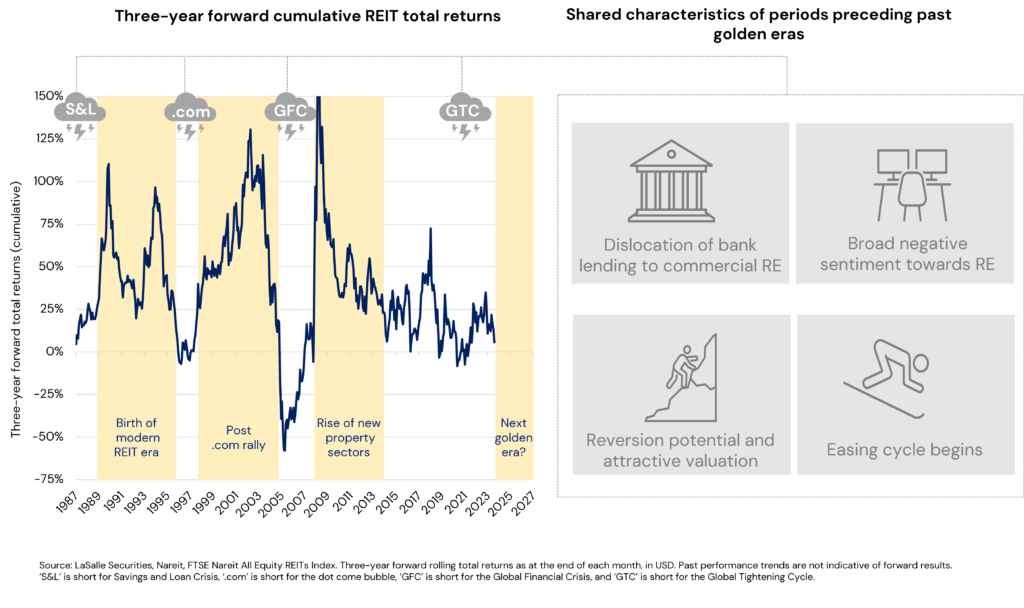
Recent history, marked by a post-pandemic recovery followed swiftly by the Great Tightening Cycle (GTC), presents important similarities to these historical periods of severe market challenges. For instance, real estate bank lending is dislocated. An AI-driven tech frenzy and fears of a generalized “commercial” real estate malaise mean REITs have underperformed compared to equities (see LMQ pg. 22). Meanwhile, signs of an easing or stabilization in financial conditions and a potential global monetary easing cycle are becoming more apparent (see LMQ pgs. 9, 10 and 30).
While history does not repeat itself, it does often rhyme. The presence of those elements in today’s market environment, and the potential for those concerns to flip to opportunities, may foretell the next REIT golden era. We discuss each of these factors in turn.

Challenged real estate lending represents an opportunity for REITs. The past two to three years have been characterized by a significant retrenchment in bank lending to real estate. According to the US Senior Loan Officer Survey (see LMQ pg. 16), the net balance between demand for loans and banks’ willingness to lend points to the widest undersupply of credit in the past ten years, except for during the depths of COVID-19. The shortage is evident in all styles of borrowing, from riskier construction loans to mortgages backed by traditional, defensive apartment assets.
This circumstance presents an opportunity for REITs given their strong financial positions and access to the capital markets. Having learned a painful lesson from the GFC, global REITs went into the GTC with their lowest leverage levels on record (see LMQ pg. 16), and nearly 90% of their debt on fixed rates and an average remaining term of seven years.2 Looking specifically at the US market, the overwhelming majority of REIT borrowing – nearly 80% – is from the unsecured market, at rates that are today almost 100 bps lower than a traditional mortgage. This relative advantage in both access and cost of capital positions REITs to potentially play the role of aggregator and to take market share.

“Commercial” real estate negativity is office-focused, but all real estate is not office. Headlines proclaiming the demise of commercial real estate usually involve a misleading generalization. Professionally managed, income-producing real estate generally should not be conflated with office specifically. It is well known that hybrid work and other factors have harmed office values. Office fundamentals are expected to remain relatively weak,3 with the sector’s growth outlook trailing nearly all other REITs globally. Office landlords will likely need to invest capital aggressively to maintain competitiveness.
These challenging office sector dynamics have unfairly cast a shadow over the broader real estate and REIT universe. In reality, office has over time become a smaller portion of the real estate landscape, especially in the public market; as of the date of this paper, only about 6% of global REITs by market capitalization are office focused (see LMQ pg. 20).4 The public market now offers a diverse sector menu comprising a wide range of dynamic sectors. These include industrial and logistics; forms of rental residential including multi- and single-family rental, manufactured housing and student housing; various formats of healthcare property; and exposure to tech-related real estate in the form of data centers and cell towers. Sectors other than office comprise the overwhelming majority of the public REIT market,5 and many of those sectors have growth outlooks that are forecast to produce earnings growth that is in line with or better than broader equities.6 That growth outlook is underpinned by a combination of secular demand drivers and declining supply levels, the other side of the higher interest rate coin.7
Media coverage naturally tends to focus on the national and trans-national arenas, but local political developments can be especially impactful for real estate investments. Such issues can fly under the radar, especially given many of the most relevant ones are only of interest to a specialist audience. For example, changes in policy around topics like the planning process, property taxes and transfer taxes (a.k.a. stamp duty) can have direct, measurable and immediate impacts on property cash flows and thus values. The distraction of the bright shiny lights of global geopolitics should not be allowed to excessively overshadow the critical local issues that impact real estate.

Underperformance may set the stage for a return to outperformance. The negativity around lending or financing concerns and the “death of office” have weighed on both the absolute and relative performance of REITs. The chart below shows the rolling one-year relative performance differential between REITs and equities; it indicates that REIT underperformance has reached its typical peak historical level before starting to reverse. Periods of underperformance have historically tended to reverse, and this instance is likely no different; indeed, the performance gap is already narrowing.
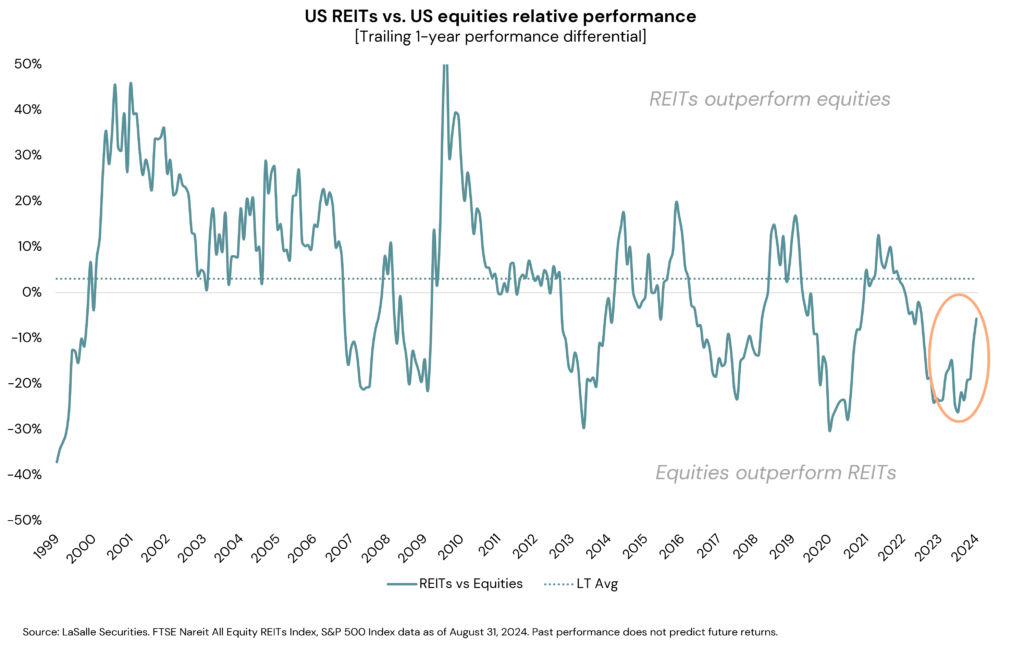

The start of a global monetary easing cycle. Real estate is a capital-intensive business that exhibits significant sensitivity to changes in financial conditions, an observation that holds for both directions of interest rate change. The downside of this dynamic was evident for much of 2022 and 2023, but the upside is likely coming into play. A global monetary easing cycle is now decidedly underway, heralded by the Fed’s 50 bps rate cut on September 18 (see LMQ pg. 31). REITs have generally performed well in periods leading up to and following a central bank easing cycle, as the chart below shows.
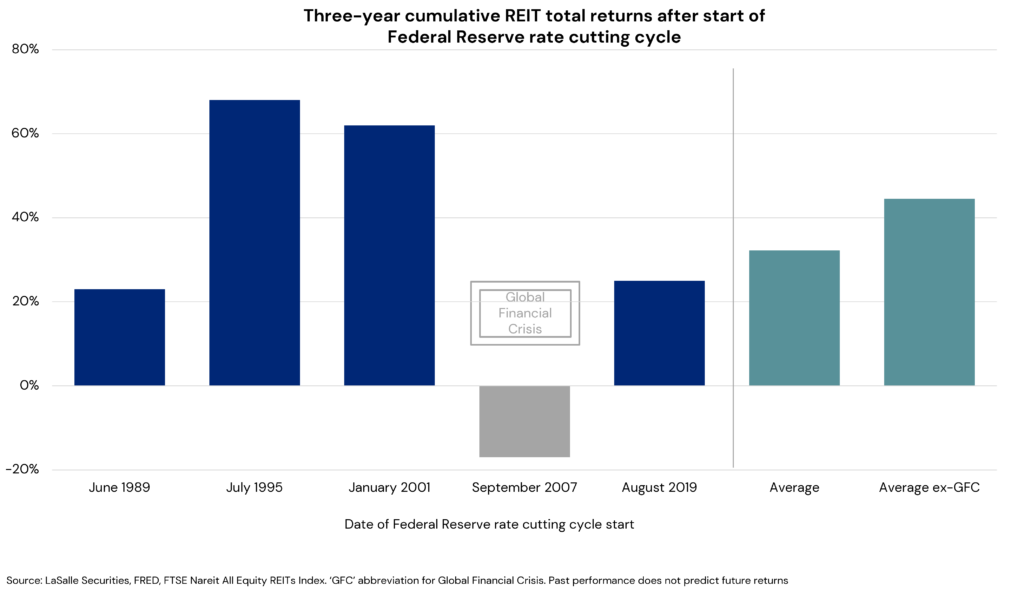
Over the past 25 years, REITs have produced total returns of 8% per annum, with 4-5 percentage points of that return coming from income. LaSalle’s base case underwriting for the next three years is for the REIT market to produce total returns of 9%, slightly above historical averages, with roughly four percentage points of that coming from income. That base case forecast incorporates today’s fundamental outlook and interest rate levels. Should any further easing in financial conditions occur, even only in the amount of 50 bps or 100 bps, those return expectations increase to 13% and 18% per annum, respectively, in line with previous “golden eras.”
LOOKING AHEAD >
- Pattern recognition is a useful approach that can help in predicting regime shifts in market conditions. Our study of historical periods of listed REIT under- and outperformance identifies a clear pattern. Namely, there are four common factors that have driven REIT strength after a period of challenges: dislocated bank finance, weak sentiment, underperformance versus broader equities, and the start of an easing in financial conditions.
- We also identify three historical “golden eras” for REITs — all of which were preceded by periods characterized by those four factors. These periods are those immediately in the wake of the S&L crisis, the Dot-com bust and the GFC.
- The current environment resembles the set up for these historical golden eras, suggesting that the REIT market may be on the cusp of its next golden era of investment, according to our analysis.
- Many of the factors supporting the REIT market’s upbeat prospects are also positives for real estate as a whole. For example, an easing in financial conditions has historically been a driver of strong forward REIT returns, as well as those for private equity real estate.
- That said, some of the dynamics are more specific to listed real estate markets. For example, REITs’ strong balance sheets and the cost of capital advantage of their unsecured borrowing options versus conventional mortgages positions listed players to seize opportunities.
Footnotes
1 This analysis based on LaSalle Securities analysis of historical macroeconomic, capital market and listed market trends. Source for the REIT performance data cited below are the FTSE Nareit indices.
2 Source for debt pricing comments in this paragraph: S&P Global Market Intelligence, Green Street Advisors, company financial releases, company research and market analysis conducted by LaSalle Securities.
3 There is considerable global variation in office performance, and there are certainly exceptions to this generalization, especially in select Asia-Pacific markets and the higher end of the European office quality spectrum. For more discussion of global office trends, see our ISA Outlook 2024 Mid-Year Update.
4 Source: LaSalle Securities. Percent of companies classified as office focused within the global listed universe defined as the constituents of the S&P Developed REIT, FTSE EPRA Nareit Developed and Nareit All Equity Indices. Sector classifications determined by LaSalle Securities.
5 As measured by market capitalization. Source: LaSalle Securities. Global listed universe defined by the constituents of the S&P Developed REIT, FTSE EPRA Nareit Developed and Nareit All Equity Indices. Sector classifications determined by LaSalle Securities.
6 As based on LaSalle Securities proprietary modelling and consensus earnings forecasts for the Bloomberg World Index, a proxy for broader equity markets.
7 Higher interest rates mean development proformas use higher exit yield assumptions and more expensive development finance. When interest rates are high, all else being equal, the rents required to justify development are higher.
8 Based on proprietary internal LaSalle Investment Management modeling of securities returns. There is no guarantee that such forecasted returns, or any other returns referred afterwards, will materialize.
This publication does not constitute an offer to sell, or the solicitation of an offer to buy, any securities or any interests in any investment products advised by, or the advisory services of, LaSalle Investment Management (together with its global investment advisory affiliates, “LaSalle”). This publication has been prepared without regard to the specific investment objectives, financial situation or particular needs of recipients and under no circumstances is this publication on its own intended to be, or serve as, investment advice. The discussions set forth in this publication are intended for informational purposes only, do not constitute investment advice and are subject to correction, completion and amendment without notice. Further, nothing herein constitutes legal or tax advice. Prior to making any investment, an investor should consult with its own investment, accounting, legal and tax advisers to independently evaluate the risks, consequences and suitability of that investment.
LaSalle has taken reasonable care to ensure that the information contained in this publication is accurate and has been obtained from reliable sources. Any opinions, forecasts, projections or other statements that are made in this publication are forward-looking statements. Although LaSalle believes that the expectations reflected in such forward-looking statements are reasonable, they do involve a number of assumptions, risks and uncertainties. Accordingly, LaSalle does not make any express or implied representation or warranty, and no responsibility is accepted with respect to the adequacy, accuracy, completeness or reasonableness of the facts, opinions, estimates, forecasts, or other information set out in this publication or any further information, written or oral notice, or other document at any time supplied in connection with this publication. LaSalle does not undertake and is under no obligation to update or keep current the information or content contained in this publication for future events. LaSalle does not accept any liability in negligence or otherwise for any loss or damage suffered by any party resulting from reliance on this publication and nothing contained herein shall be relied upon as a promise or guarantee regarding any future events or performance.
By accepting receipt of this publication, the recipient agrees not to distribute, offer or sell this publication or copies of it and agrees not to make use of the publication other than for its own general information purposes.
Copyright © LaSalle Investment Management 2024. All rights reserved. No part of this document may be reproduced by any means, whether graphically, electronically, mechanically or otherwise howsoever, including without limitation photocopying and recording on magnetic tape, or included in any information store and/or retrieval system without prior written permission of LaSalle Investment Management.
Dave White, Head of Real Estate Debt Strategies, and Brett Ormrod, Net Zero Carbon Lead for Europe, discuss the current and future state of green lending across Europe.
While lending volumes across the market remain volatile, data shows one continuously increasing metric: the demand for green loans, which is being driven by the ever-growing sustainability requirements from both investors and sponsors.
Dave White and Brett Ormrod discuss the challenges that borrowers and investors are facing, and how we at LaSalle are navigating these dynamics. They discuss how green loans are impacting the European real estate market, what they can mean for investors’ bottom lines, and the overall opportunity not just for green loans, but for greener assets in investors’ portfolios.
Want to read more?
This article first appeared in PropertyEU’s State of Logistics report
LaSalle’s Petra Blazkova recently joined Property EU’s State of Logistics 2024 conference in Amsterdam to present the firm’s inaugural Paths of Distribution Score research, which gives the ability to compare logistics locations at a micro, market, country and pan-European level.
LaSalle identifies top logistics locations in Europe
Paris and the surrounding Île-de-France region are the top micro-locations for efficient logistics distribution in Europe, according to a new study by LaSalle Investment Management.
The Paths of Distribution study considered over 150,000 micro-locations across the UK and EU, scoring them based on factors like manufacturing output, consumer spending, infrastructure, and labour costs. It also took into account the location of Amazon warehouses and analyzed data from REITs and other real estate databases.
Presenting the results at the Amsterdam logistics event, Petra Blazkova, Europe head of Core and Core-plus Research and Strategy, LaSalle Investment Management, pointed out that the data provides valuable insights for investors seeking the most efficient and attractive logistics locations with the greatest potential for long-term rental growth.
Want to read more?
Paris / Île-de-France is home to Europe’s top micro-locations for efficient logistics distribution, according to the inaugural release of the Paths of Distribution score, published today by LaSalle Investment Management (“LaSalle”). The innovative, granular new research gives the ability to compare logistics locations at a micro, market, country and pan-European level, with extensive flexibility for understanding, benchmarking and ranking locations at both micro and macro scale.
The Netherlands, thanks to its immediate access to Europe’s major consumption centres and having one of the crossroads of trade within and into Europe, was identified as the strongest-performing country. The port city of Rotterdam, the key gateway of global trade, ranked second and is joined in the top 20 regional markets by local rivals Amsterdam and the North Brabant region of Breda and Tilburg. Germany, the second-best performing country, provided another five of Europe’s top 20 markets, all in the west of the country, establishing this corner of north-western Europe as a hotspot for manufacturing and transportation. The UK, although separated from continental European logistics markets, placed third in the country standings, with Greater London its highest-ranked logistics market, although the West and East Midlands, the North-West of England (surrounding Manchester) and Kent all placed in the top 20 thanks to their strong infrastructure.
Belgium was fourth best performing, with the Antwerp and Brussels markets ranking seventh and seventeenth respectively. The wider Milan region also scored highly in the rankings, despite comparatively low investment volumes historically, while the Veneto-Verona corridor was another Italian market which scored well, with domestic consumption being the primary driver. Likewise, in Poland, the biggest winners were the Katowice-Krakow corridor and Lodz – ranking above the capital Warsaw – both growing notably in recent years and benefitting from investment in infrastructure and labour availability. LaSalle’s analysis shows there is a positive correlation between Paths of Distribution and logistics take-up, making a connection between current demand and these locations’ potential.
Micro-location and methodology
The research is the first of its kind, and takes an innovative, granular approach to its methodology, breaking the continent down into 158,445 10-kilometre hexagons. Each micro-location is scored across four key pillars of manufacturing output, consumer spend, infrastructure quality and the proximity to skilled labour. The model not only factors in demand, but also considers the cost from an operator’s perspective of meeting that demand, using an extensive set of region-to-region road freight transport cost metrics, along with a random forest machine learning model evaluating how extensive and accessible the road network is at the most granular level.
The top scoring micro-location hexagons are in the Eastern Crescent that semi-circles Paris, stretching from the area surrounding the Charles de Gaulle airport in the north, moving south-east through Noisy-le-Grand, then continuing south covering Créteil. This sub-market of Paris benefits from excellent connectivity into Paris, as well as to the wider French market, and further north and east.
Logistics distribution scoring is unlike other city rankings because it is about far more than central cities – entire regions and all the micro-locations within them are potentially efficient places for distribution. So the LaSalle team took a new approach filling in all the gaps in the regions of Europe between cities. The vibrant maps showing location scores across all of Europe highlight the corridors, conurbations, clusters, and crescents which define the optimal locations for modern logistics.
Petra Blazkova, Head of Research & Strategy, Core & Core-Plus Capital, Europe at LaSalle, said: “With continued uncertainty around energy prices and supply chains being disrupted, cost uncertainty is high across the continent for logistics providers. Location is a key variable which distributors can still control, and so it is more important than ever: optimising your choice of location can help minimise exposure to these other risks and protect your supply chain. Today’s rankings demonstrate which areas are best for distributors to try to insulate themselves from those pressures. As investors in the sector, this new insight into the most resilient logistics markets in Europe informs our portfolio composition and asset management.”
The full top 20 logistics markets were as follows:
1 Paris / Île-de-France, France
2 Rotterdam, The Netherlands
3 Frankfurt-Mainz, Germany
4 Milan, Italy
5 Greater London, United Kingdom
6 Rhine-Ruhr, Germany
7 Antwerp, Belgium
8 West Midlands, United Kingdom
9 Madrid, Spain
10 Dortmund, Germany
11 Amsterdam, The Netherlands
12 East Midlands, United Kingdom
13 Stuttgart, Germany
14 North West England (Manchester), United Kingdom
15 North Brabant (Breda-Tilburg), The Netherlands
16 Karlsruhe-Mannheim corridor, Germany
17 Brussels, Belgium
18 Veneto-Verona corridor, Italy
19 Kent, United Kingdom
20 Barcelona, Spain
Ends
About LaSalle Investment Management | Investing Today. For Tomorrow.
LaSalle Investment Management is one of the world’s leading real estate investment managers. On a global basis, LaSalle manages US$84.8 billion of assets in private and public real estate equity and debt investments as of Q2 2024. LaSalle’s diverse client base includes public and private pension funds, insurance companies, governments, corporations, endowments and private individuals from across the globe. LaSalle sponsors a complete range of investment vehicles, including separate accounts, open- and closed-end funds, public securities and entity-level investments.
For more information, please visit www.lasalle.com, and LinkedIn.
Company news


No results found
One of our key conviction sectors for real estate investment over the last few years has been logistics. It has been a particular focus of our research, as we seek to identify investment opportunities in prime locations. But with continued uncertainty around variables such as energy prices and supply chains being disrupted, cost uncertainty is high across the continent for logistics providers.
Location, however, is a key variable which distributors can still control, and so it is more important than ever: optimising your choice of location can help minimise exposure to these other risks and protect your supply chain.
LaSalle’s inaugural “Paths of Distribution Score,” focuses on the geography of the European logistics market. This innovative, granular new research gives us the ability to compare logistics locations at a micro, market, country and pan-European level, with extensive flexibility for understanding, benchmarking and ranking locations – and opportunities to deploy capital – at both micro and macro scale. As investors in the sector, this new insight into the most resilient logistics markets in Europe informs our portfolio composition and asset management.
Want to read the full report?
This article first appeared in the September 2024 edition of PERE
LaSalle’s Isabelle Brennan sat down with peers from other leading alternative credit providers across the US to discuss the state of real estate debt across the United States.
US private lenders eye real estate opportunities as activity ramps up
With banks likely to remain on the sidelines amid regulatory changes, participants in PERE’s US debt roundtable anticipate openings to deploy capital both in refinancing and new acquisitions, Stuart Watson reports.
Over the past 18 months higher interest rates, uncertainty about property values, and questions over secular shifts in demand for some asset classes have combined to suppress activity in US commercial real estate lending markets. Meanwhile both money center and regional banks have scaled back activity in the face of concerns over the health of their balance sheets, and the expected introduction of stricter capital requirements aimed at reducing liquidity risk.
Want to read more?
This article first appeared in the Summer 2024 edition of PREA Quarterly
LaSalle’s Global Head of Research and Strategy, Brian Klinksiek, discusses how ex-US investors are viewing the US real estate market.
Foreign investors are an important—if far from dominant—source of capital for US commercial real estate. Since 2010, foreign investors have made up around 12% of total US investment activity, compared with the 30%–60% range for most other major developed markets, according to MSCI Real Capital Analytics (Exhibit 1). However, foreign investors also play a meaningful role as limited partners in funds. According to the PREA Investor Composition Survey, investors from outside the US in 2022 held nearly 18% of the NCREIF Fund Index—Open End Diversified Core Equity (NFI-ODCE) net asset value, a share that has risen steadily from less than 5% in 2012. Moreover, in some phases of the market, offshore capital has acted as the marginal buyer of certain types of real estate, giving an outsize impact on pricing.
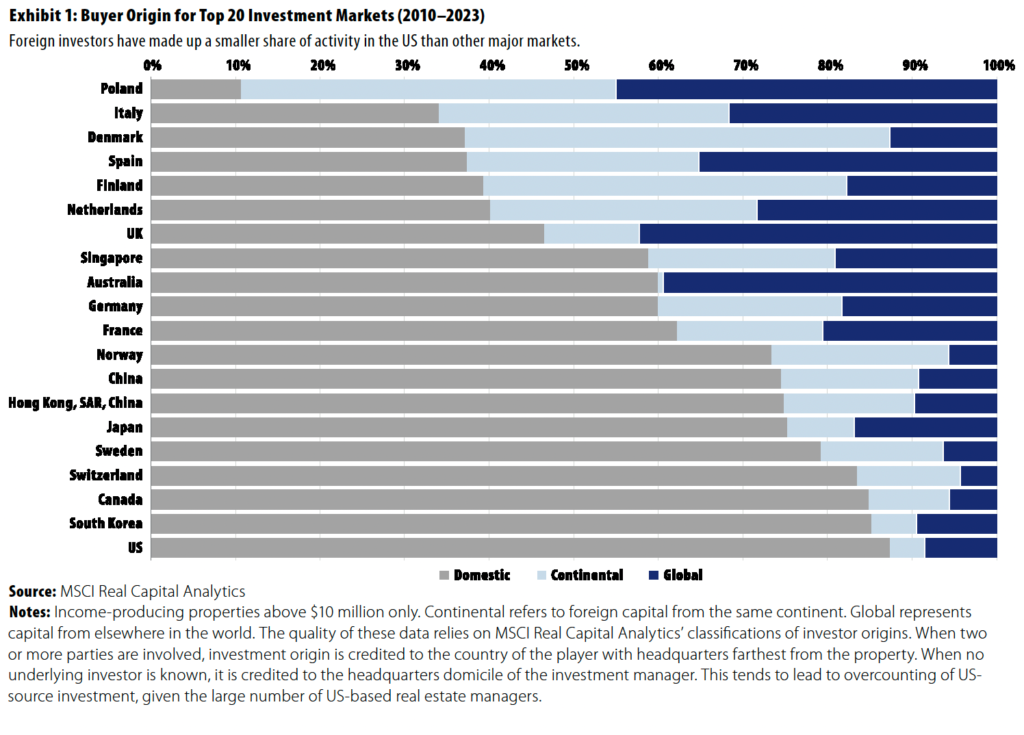
Investors broaden their real estate holdings outside their home countries for many reasons, including to diversify, expand the opportunity set, and avoid crowded capital markets at home. The drive to expand globally is especially strong for investors in countries with excess savings in the form of well-funded defined benefit pension systems (e.g., Northern Europe), mandatory retirement savings programs (superannuation in Australia), or sovereign wealth funds (many energy exporters). LaSalle has long been an advocate of “going global”; while not the focus of this article, LaSalle covers the case for global investing in its ISA Portfolio View report.
Want to read more?
This article first appeared in the August 2024 edition of IPE Real Assets
With increasing regulations and more investors embedding sustainability goals into their investments, incorporating green targets into the debt component of the capital structure is becoming more common. As a result, the debt market across Europe is becoming a two-tiered market, with more green loans being issued at the same time as overall lending volumes have declined.
In this guest article for IPE Real Assets, Dave White discussed the growing appetite for these loans across Europe, and how both lenders and investors are responding to this changing landscape.
LaSalle is one of Europe’s largest and most established investors in real estate debt, offering a variety of loan types across sectors. Learn more about this dynamic asset class, and LaSalle’s capabilities from Dave White, Head of European Debt Strategies here at LaSalle.
Want to read more?
Dave White, Head of Real Estate Debt Strategies, Europe discusses the market in 2024 and where we are seeing opportunities for investors.
Want to read more?
“You take the blue pill—the story ends, you wake up in your bed and believe whatever you want to believe. You take the red pill… all I’m offering is the truth.”
– Morpheus to Neo, The Matrix (1999)
We published the global chapter of the ISA Outlook 2024 on November 14, 2023, just before euphoria about a potential ‘V’-shaped property market turnaround emerged. Interest rates fell quickly as financial markets priced in several US Federal Reserve (Fed) rate cuts in 2024. For a time, it looked as though our prediction that it would take a little longer for markets to digest a renewed spike in rates would not age well.
In this Mid-Year Update, however, we look back to find an outlook with an uncanny resemblance to that of six months ago. This is not because nothing has changed, but because the mood has gone full circle. The landscape remains characterized by interest rate volatility, soft fundamentals in some markets, and gaping quality divides, but also by pockets of considerable strength. Another factor that has not changed is that financial conditions (i.e., interest rates) remain the dominant driver of the market, and that political and geopolitical uncertainties are in focus in many countries (see LaSalle Macro Quarterly, or LMQ, pages 4-6).1
In this report, we discuss five themes we see driving real estate markets for the rest of 2024 and beyond. At our European Investor Summit in May, our colleague Dan Mahoney argued that—like Neo in the Matrix—we should take the red pill and endeavor to see the market as it is, not as we’d like it to be. Taking the red pill requires a realistic view on property values. It reveals as unlikely a return to an environment of ultra-low interest rates or uniformly benign fundamentals in the “winning” sectors.
But it does not mean that there will not be attractive investment opportunities. Unlike the bleak dystopia of The Matrix, there are many reasons for optimism, as well as signs that the coming months will come to be seen as a favorable investment vintage. That said, investing successfully will require a balance of big-picture perspective and granular discernment, and a mix of patience and willingness to take risk.
Interest rates – Still no map to the trail
Over the past year, we likened the interest rate path in most markets to a strenuous mountain trek: the relentless climb (2022), the range-bound altitude of an alpine ridge line (H1 2023), the unexpected upward turn in the trail (Q3 2023), and the mountain meadow of cooling inflation and expected rate cuts (Q1 2024). More recently, there have been upward turns in the interest rates trail whenever there have been signs of sticky inflation in the US and other key countries.

One thing is for sure: No map exists for this trail. While interest rates have big consequences for real estate capital markets, they are extremely difficult to predict. We continue to caution investors against overconfidence in their ability to forecast the path of long-term interest rates.
Mercifully, falling rates are not a necessary condition for a robust recovery in real estate transaction activity. Despite interest rates remaining elevated, property markets are already showing signs of finding their footing, such as renewed US CMBS issuance and resilient deal volumes in many markets and sectors.2 A key reason for this is that wherever interest rates have spiked over the past two and half years, especially Europe and North America,3 real estate prices have by now adjusted downward significantly. The relativities between expected returns for real estate and those for other asset classes now look more appropriate than they have in many months; in other words, more of the market is at or near fair value.4
That said, while lower rates are not necessary for real estate capital market normalization, greater stability in rates than we have been seeing would no doubt help. Interest rate volatility is the enemy of a smoothly functioning private real estate transaction market. Excessive movement in borrowing costs during due diligence periods can lead to dropped deals and re-trades. Moreover, when rates are volatile, the conclusions of fair value models are also volatile, impacting both buyers’ and sellers’ assessments of appropriate pricing. Looking at recent trends in the MOVE index,5,6 interest rate volatility appears to be gradually easing but is still elevated relative to recent history (see LMQ page 13).
Increasing stability in rates is welcome, but for now it is reasonable to expect continued strains in real estate capital markets that create both challenges and opportunities. Such conditions can represent favorable entry points for debt investors (lenders), distressed equity players and core investors seeking entry points below replacement
Macro – Deciphering divergence
Over the past half-year, interest rates have been increasingly influenced by widening divergences between near-term growth, inflation and monetary and fiscal policy outlooks. Most notably, the bond yield gap between the US and other markets, especially the eurozone, has widened. US growth and inflation have surprised on the upside, in the face of softening or stability elsewhere. Markets currently expect only one Fed rate cut in 2024, down from up to four earlier in the year.7 Meanwhile, in early June the Bank of Canada became the first G7 central bank to cut rates since the great tightening cycle began, with the European Central Bank (ECB) following shortly after (see LMQ page 7).
Regional groupings can obscure divergences within them. The key driver of eurozone softness is Germany (see LMQ page 23), owing to its reliance on manufacturing exports and past dependance on Russian energy. Meanwhile, the Spanish economy remains strong due to healthy consumption and tourism. Within North America, Canada’s economy is underperforming the US because the structure of its residential mortgage market makes it more exposed to higher rates.8 These intra-regional variations may have a range of impacts on property markets, for example by shifting the relative short-term prospects for demand and value.
Japan and China represent long-standing divergences that persist.9 In China, a loosening bias remains in effect as inflation hovers at around 0%.10 In Japan, monetary policy is gradually normalizing, but so far without triggering a big increase in interest rates (at least compared to elsewhere). In March, the Bank of Japan (BOJ) abandoned negative interest rates and ended most unorthodox monetary policies, though it has since held policy interest rates at around zero. Japan’s economy becoming more “normal” is generally a positive, but interest rate differentials have pushed the yen to a 34-year low against the US dollar (see LMQ page 14), creating upside risks to inflation.11 But notably, Japan remains the one major global market in which real estate leverage remains broadly accretive to going-in yields.
Aside from reinforcing the potential benefits of diversification, what do these divergences mean for investors? Mechanically, any unexpected relative softening of interest rates should, all else equal, be beneficial for relative value assessments of real estate in that market. But firmer rates in the US have predictably come alongside a stronger US dollar. This points to practical limits to global monetary policy divergences; central bankers are keenly aware that weaker currencies come with inflationary risks. Moreover, it is worth asking how persistent macro divergences will be; current divergences are rooted in timing differences of expected rate cuts, rather than an anticipated permanent disconnect.
Renewed cyclicality — Ride the (supply) wave
For several years, secular themes and structural shocks have dominated the trajectories of global property markets. But there is a clear cyclical pattern reemerging in the form of a pronounced upswing in vacancy across global logistics markets, and in US apartments. The return of cyclicality in those favored sectors is having significant impacts on their near-term prospects.
The softening trend is not new. In the ISA Outlook 2024, we identified hot sectors “coming off the boil.” Part of this was down to normalizing demand levels, but elevated new supply was also a key driver. As expected, the softening we observed has continued to deepen, leading to outright rent declines in certain markets, especially for apartments in US sunbelt metros.
Softening fundamentals are not to be ignored, but we recommend investors to have the conviction to “ride the wave” of excess supply. Wide variation in supply levels at the market and submarket level means that investors with granular market data and the discipline to incorporate it into their market targeting processes should be positioned to select the most attractive markets and submarkets.

Moreover, the forces that create cycles sow the seeds of their own reversal; we expect the current supply wave to moderate soon, as evidenced by sharply falling construction starts (see LMQ page 25). Many of the projects being completed today broke ground when credible exit cap rate assumptions were several hundred basis points lower than today. Higher interest rates upended development economics; far fewer new developments can now be justified on today’s mix of land prices, construction costs and financial conditions.
Finally, investors should be prepared to think about cash flows in both real and nominal terms. When cooling nominal rental growth comes alongside cooling inflation, as it does today, it is possible for that to be consistent with solid real rental growth, depending on the relative magnitude of each.
The next chapters in secular change
Beyond the reassertion of supply cycles in some markets, there is an evolving mix of secular stories that deserve attention. Some of these are so long-standing that they could almost be considered constants. These include structural shortages of housing in most of Europe, Canada and Australia, as well as the widespread changing definition of core real estate in favor of more operational niche sectors and sub-types.12 We continue to be strong advocates for investment in undersupplied living sectors, and for participating in the institutionalization and growth of niche sub-sectors such as single-family rental (SFR) and industrial outdoor storage (IOS).
More dynamic themes that deserve a closer look include the stabilization of retail real estate and divergent office investment prospects:
- Rebalanced retail — In much of the world, the various sub-sectors of retail are on firmer ground than they have been in years. This owes to a nearly decade-long process of rebalancing, supported by normalizing post-pandemic demand trends and the removal, through demolition or irrelevance, of uncompetitive retail inventory. We have found retail assets to be some of the most stable performers in our portfolio in recent quarters. While the consumer mood is bifurcated between healthy higher-end households and lower-income households struggling with inflation’s hit to real spending power, physical retail has proven its enduring role in serving both convenience and experiential shopping. We are constructive on selective investment in several retail sub-types, particularly European outlet centers, top Canadian regional malls, and select open-air centers in the US.
- All-over-the-map office — The office sector is quite literally “all over the map”, with huge variation in outlook depending on geography, ranging from Seoul, South Korea, where office market conditions are currently tighter than nearly any other market/sector combination globally, to the many North American office markets where vacancy rates are well into double digits. We stand by our long-held views13 on the widely varying prospects for global office markets, with Asia-Pacific markets (ex-Australia and China) having the best near-term outlook, US markets having the worst, and Europe in between. One office sector theme that deserves special mention is the increasingly compelling case for investment in super-prime offices in a handful of key European central business districts. We see the conditions for a substantial shortage of top-quality space several markets, which should lead to substantial rent spikes for the best positioned assets.
Other key secular themes driving investment opportunities today include the implications of artificial intelligence (AI) adoption for data center demand, student mobility for student accommodation in Europe and Australia and aging for senior housing.
Don’t wait for the “all clear”
Past experience of real estate cycles suggests that the best investment opportunities tend to arise in periods marked by significant uncertainty, volatility and pessimism, but also when early signs of improvement and stabilization are present—in other words, moments similar to today’s environment. Experience also reinforces that it is nearly impossible to time the market, so it is best to be selectively active throughout the cycle. By the time the “all clear” signal is sounded after a market crisis, it is too late to achieve the best risk-adjusted returns.
That said, “red pill” thinking means we must recognize that the coming capital market rebound is unlikely to be as sharp as it was after the Global Financial Crisis (GFC), given that central banks are unlikely to usher in ultra-loose policy. Seeing the market as it is requires accepting the likelihood that interest rates could remain sticky, and a realistic view of near-term fundamentals as a wave of supply impacts some sectors.
LOOKING AHEAD >
- Strategies for both new and existing investments must take a realistic stance on interest rate uncertainty, with duration exposures aligned to an investor’s goals and risk appetite. Using real estate as a vehicle to place bets on bond markets is as inefficient as it is misguided. We continue to recommend that investors be largely “takers” of bond market signals, and today those are pointing to interest rates remaining high for longer in the US and several other key markets.
- Upended development economics in many markets and sectors means that assets can be bought well below replacement cost, suggesting rents will need to rise and/or land prices will need to fall to justify incremental supply. While buying below replacement cost can be one indicator of a potentially attractive acquisition opportunity, we are cautious about using replacement costs in isolation as an investment decision-making tool. It is essential to adjust for the capital expenditure required to truly equalize the market position of a new asset versus an old one. Often a building is worth less than the cost to build a new building simply because it is old and uncompetitive.
- The anchor of “replacement cost rents” only operates when there is a fundamental need for additional space. In heavily vacant markets, such as US offices, it likely will be years before this mechanism kicks in. Investors acquiring below replacement cost in heavily unbalanced markets must be prepared to wait a long time for that discount to close, and the extended passage of time to monetize a discount is mathematically deleterious to IRRs. A focus on markets working through short-term challenges such as a wave of new supply, but characterized by long-term strength, may generate the best risk-adjusted returns.
- Market bottoms are hard to see in the moment, and only tend to become obvious in retrospect many months down the line; it is hard to see today whether we are fully clear of the lowest point in prices. But we have a least moved from a period of relentless upward movement in rates to volatility around a pivot point. Moreover, challenged capital stacks built before the great tightening still need repair. Both observations point to potentially strong opportunities to invest today across real estate debt and equity.
Footnotes
1 Also see our ISA Briefing, “Elections everywhere, all at once: Geopolitics and risk”, April 2024. In that note, we highlighted the various sources of political uncertainty this year and outlined how we recommend investors consider these risks. At the time of writing, political developments are particularly salient for short-term movements markets in France and the UK, given elections that have been called in those countries.
2 Source: MSCI Real Capital Analytics and Trepp
3 Japan and China are key exceptions that we cover in greater depth under the “deciphering divergence” header.
4 Of course, there is considerable variation embedded in this and any assessment of fair value. As always, the devil is in the detail on the assumptions that go into expected and required returns; at LaSalle, specific fair value inputs and conclusions remain a proprietary output.
5 The Merrill Lynch Option Volatility Estimate (MOVE) is a market-implied measure of volatility in the market for US Treasuries. It calculates options prices to reflect the expectations of market participants on future volatility. Observation made as of June 24, 2024.
6 Source: Bloomberg as of June 26, 2024.
7 For more discussion of the Canada-US divergence and the consequences of mortgage rate resets, see our ISA Briefing, ”The impact of residential mortgage resets”.
8 For more detailed discussion of the unique factors in the Japanese and Chinese macro environment, see our ISA Briefing, “Key economic questions for China and Japan”.
9 Source: Oxford Economics; Gavekal Dragonomics as of June 26, 2024.
10 Economic theory suggest that weak currency may contribute to inflationary forces because it pushes up the cost of imported goods.
11 See our PREA Quarterly article on “The Changing Definition of Core Real Estate” for a discussion of how the characteristics considered desirable in core properties is moving from traditional metrics like lease length, to observed qualities like the stability of cash flows. This shift elevates the appeal of niche sectors sub-sectors versus traditional sectors such as conventional office.
12 See our ISA Focus report “Revisiting the future of office”, published March 2023.
Important notice and disclaimer
This publication does not constitute an offer to sell, or the solicitation of an offer to buy, any securities or any interests in any investment products advised by, or the advisory services of, LaSalle Investment Management (together with its global investment advisory affiliates, “LaSalle”). This publication has been prepared without regard to the specific investment objectives, financial situation or particular needs of recipients and under no circumstances is this publication on its own intended to be, or serve as, investment advice. The discussions set forth in this publication are intended for informational purposes only, do not constitute investment advice and are subject to correction, completion and amendment without notice. Further, nothing herein constitutes legal or tax advice. Prior to making any investment, an investor should consult with its own investment, accounting, legal and tax advisers to independently evaluate the risks, consequences and suitability of that investment.
LaSalle has taken reasonable care to ensure that the information contained in this publication is accurate and has been obtained from reliable sources. Any opinions, forecasts, projections or other statements that are made in this publication are forward-looking statements. Although LaSalle believes that the expectations reflected in such forward-looking statements are reasonable, they do involve a number of assumptions, risks and uncertainties. Accordingly, LaSalle does not make any express or implied representation or warranty, and no responsibility is accepted with respect to the adequacy, accuracy, completeness or reasonableness of the facts, opinions, estimates, forecasts, or other information set out in this publication or any further information, written or oral notice, or other document at any time supplied in connection with this publication. LaSalle does not undertake and is under no obligation to update or keep current the information or content contained in this publication for future events. LaSalle does not accept any liability in negligence or otherwise for any loss or damage suffered by any party resulting from reliance on this publication and nothing contained herein shall be relied upon as a promise or guarantee regarding any future events or performance.
By accepting receipt of this publication, the recipient agrees not to distribute, offer or sell this publication or copies of it and agrees not to make use of the publication other than for its own general information purposes.
Copyright © LaSalle Investment Management 2024. All rights reserved. No part of this document may be reproduced by any means, whether graphically, electronically, mechanically or otherwise howsoever, including without limitation photocopying and recording on magnetic tape, or included in any information store and/or retrieval system without prior written permission of LaSalle Investment Management.
In 2024 to date, European markets have pivoted through inflection points on interest rates, economic growth, and property capital markets – which we graph and unpeel in our latest LaSalle European Market View chartbook.

Cyclical shifts are interacting with geopolitical risks in 2024 – from trade headwinds to energy and migration demographics – to create volatility and to shape changes in Europe’s occupier demand and investor risk appetite, all as the region stands on the cusp of an unexpectedly active summer election season.
We cover the latest real estate market trends in 2024 to date. Particularly notable is how a combination of moderating inflation and resilient fundamentals has led to an improvement in real – after inflation – market rent growth, even as nominal rent change has come off the boil.

Want to read more?
This article first appeared in the June 2024 edition of PERE
LaSalle’s Dan Mahoney sat down with peers from across the industry to discuss the state of the UK real estate market.
UK real estate’s rocky road to recovery
After a period of political and economic turbulence, not to mention real estate market paralysis, participants in PERE’s UK roundtable anticipate calmer waters ahead, writes Stuart Watson
For the participants in this year’s PERE UK roundtable discussion, certainty is a welcome thing, following as it does a prolonged period of political turbulence that saw the UK withdraw from the European Union, combined with both the covid-19 pandemic and the global supply chain and inflation shocks that disrupted the UK real estate investment market.
Want to read more?
This article first appeared in the Spring 2024 edition of PREA Quarterly
LaSalle’s Global Head of Research and Strategy, Brian Klinksiek, discusses how the definition of core real estate is changing for investors, and what that could mean for their strategies.
A surprising standout as the most conversation-provoking exhibit from LaSalle’s ISA Outlook 2024 is titled “LaSalle’s Changing Definition of Core.” The simple table, reproduced for this article, contrasts a traditional core mind-set against an emerging “new” core mind-set. The former is focused on classic real estate metrics, such as credit quality and lease length, and flatters the property types that tend to score well against them, such as office. The latter is a more evidence-based approach focused on predictability and growth of actual cash flows, a lens that tends to favor the living sectors and niche property types and subtypes, such as medical office.
Taking a step back, the definition of core can be framed in various ways. It may be cast in relation to the other main “styles” of real estate investment—value-added and opportunistic—in that core is supposed to offer lower but safer and more predictable returns than either of those. Defining this with specificity might involve formal labels and thresholds, such as maximum leverage levels and property type characterizations. Assets and portfolios on the correct side of such definitions would be considered core and those beyond them would not be. Of course, financial theory suggests that the fundamental value of an asset should derive from the characteristics of its cash flows, not its conformance with metrics, criteria, and labels. Given that core portfolios are meant to deliver more reliable returns than non-core ones, an understanding of their sensitivity to factors such as economic growth and inflation and their vulnerability to operational challenges should be more important than how they align with some prescribed taxonomy. In this article, I take each of the classic metrics covered in the LaSalle chart and address why a change of mind-set may lead to better core portfolios.
Want to read more?
This article first appeared in the May 2024 edition of PERE
LaSalle’s Dave White sat down with peers from other leading alternative credit providers across Europe to discuss the state of real estate debt across the continent.
Opportunities are slow to unfold in European real estate debt
A golden era for alternative real estate lenders has so far failed to get underway. But there are signs the machinery is becoming unclogged, writes Judi Seebus
A year ago, alternative real estate lenders in Europe were convinced they were on the cusp of a golden age. During PERE’s European debt roundtable discussion in March 2023, participants spoke of a “huge” opportunity ahead to take advantage of a potential shortfall in refinancing funds for maturing loans amid a potential retrenchment from traditional lending sources. “I have seldom been this excited to be investing in debt,” said one participant.
Want to read more?
This article first appeared in the May 2024 edition of PERE
Kunihiko Okumura, LaSalle’s Japan CEO and Co-Chief Investment Officer for Asia Pacific, speaks with PERE about why Japan continues to be an attractive market.
Looking up: Investors stay positive at the end of an era
The return of steady inflation to Japan will put pressure on asset management skills, but there are opportunities across the board, says LaSalle’s Kunihiko Okumura
In an interview with PERE for its 2024 Japan report, Kunihiko Okumura, LaSalle’s Japan CEO and Co-CIO for Asia Pacific, shared his outlook on the market, including the impact of Japan’s interest rate hike and opportunities across various sectors such as office, multifamily and logistics.
Want to read more?
Roughly 60% of the world’s population lives in countries facing major elections in 2024, markets representing 65% of the institutional investable real estate universe.1 Elections are, of course, the cornerstone of the democratic process, which in turn underpins the appeal of the most transparent, investable markets; that said, elections come with the possibility of policy changes that may impact returns. Today’s geopolitical risks, whether they be this continuing election super-cycle (see LaSalle Macro Quarterly, or LMQ, page 4), or the various ongoing conflicts and trade disruptions, prompt important questions about how to manage investment risks related to these themes.
One of the protagonists in the Oscar-winning film Everything Everywhere All at Once says that being “’right’ is a small box invented by people who are afraid.” LaSalle’s risk management philosophy emphasizes optimizing risk/return trade-offs rather than minimizing risk-taking, while recognizing the limitations of point-estimate predictions and base-case scenarios — that is, attempts at “being right.” Today’s geopolitical events are especially likely to confound any forecaster seeking to be exactly right.
How should an investor manage their assets in the context of “unknowables” about which engaging in guesswork is tempting, but being “right” is elusive? What frameworks do we have to mitigate geopolitical risks? We propose six recommendations to keep in mind for investors taking stock of the many elections, and several conflicts, that may impact markets in 2024.
1. Be mindful of the tendency toward overreaction.
There are many examples of ex ante predictions of elections’ investment implications having been overstated. For instance, leading up to the 2016 US presidential election, there were widespread predictions that the US economy would be significantly negatively impacted by Donald Trump’s anti-immigration and protectionist stance were he elected.2 In the event, equity markets rebounded strongly after a short-lived hit and the US economy proved resilient to the changes in rhetoric and policy that came with a new president.3
Looking ahead to the US elections later this year, almost certainly a rematch between Biden and Trump, coverage of the candidates’ differences should be accompanied by awareness of their similarities. Both candidates seek to prioritize domestic production, which could lead to greater levels of on- or near-shoring of supply chains.4 Moreover, election prediction odds (see LMQ page 6) suggest divided control of the two houses of Congress and the presidency is likely; divided government has typically been associated with relative stability in domestic policy, which is generally positive for markets.5 Both of these factors — at least in isolation — point to the potential for news cycle hype to overstate long-term market impacts of this particular election.
2. Consider an asset’s “geopolitical beta.”
Financial theory tells us that systematic risks are undiversifiable.6 Systematic factors are those with significant, far-reaching implications that affect the price of all assets. But financial theory also entertains that different assets may have different sensitivities to the same set of factors; an asset’s “beta” signifies the responsiveness of its price to a given factor. This is a useful way to think about an investment’s sensitivity to political and geopolitical events. For example, a property in a metro area whose economy is heavily driven by government spending would likely have a high sensitivity to political changes. Another example could be that a property located in the Baltic States, ex-Soviet countries on the border with Russia, is likely to be especially sensitive to developments concerning relations between Russia and the West. Investors should be mindful of assets’ expected sensitivities to geopolitics, whether assessed empirically or, as is more often the case given a lack of data, estimated through intuition.
3. Avoid excessive focus on catastrophic risks.
Systemic risks go beyond systematic factors; they involve severe shocks that have the potential to re-align entire markets in unpredictable ways. An example of such an extreme event is the remote but non-negligible potential that today’s so-called “proxy wars”7 escalate into a broader active conflict between great powers.8 The challenge of incorporating such eventualities into investment decision making is not only estimating appropriate probabilities that such events may occur, but establishing ideal strategic responses should they do so. Catastrophic shocks are exceedingly rare and have the potential to create winners and losers in asset markets that are difficult or impossible to predict.9 It may be more fruitful for investors to focus on more incremental — and more likely — eventualities that have the added benefit of being easier to model.
4. Do not neglect local political risks.
Media coverage naturally tends to focus on the national and trans-national arenas, but local political developments can be especially impactful for real estate investments. Such issues can fly under the radar, especially given many of the most relevant ones are only of interest to a specialist audience. For example, changes in policy around topics like the planning process, property taxes and transfer taxes (a.k.a. stamp duty) can have direct, measurable and immediate impacts on property cash flows and thus values. The distraction of the bright shiny lights of global geopolitics should not be allowed to excessively overshadow the critical local issues that impact real estate.
5. Practice diversification but engage in “pattern recognition.”
To a certain extent, political risks can be managed through diversification. This is especially true when they involve isolated events that impact one country or subnational division such as a specific city, province or state. But often political events are part of a broader arc with potentially far-reaching consequences. A smattering of small seeds can grow from obscurity into a thicket. Nothing illustrates this better than the rise of populism, nationalism and protectionism around the world, themes set to dominate elections this year and beyond. The very notion of “globalized nationalism” may sound like an oxymoron, but it has become a fact.10 While diversification is an essential portfolio construction concept that helps manage many types of risk, including political risk, care must be taken to recognize when what may appear to be “specific” risks are part of a broader pattern that is difficult to “diversify away.”
6. Conduct “what if” exercises around potential impacts.
Geopolitical and political risks are difficult to incorporate into traditional financial analysis. We find that thinking through scenarios can be helpful in identifying investment themes that may emerge from geopolitical trends. These can point to strategies to avoid — as well as potential new ones to pursue. The “Looking Ahead” section of this note expands on some of the key themes we have been tracking.
As geopolitical events are difficult to control and plan for, one may conclude, similarly to that same protagonist in the Everything Everywhere film, that “nothing matters.” But uncertainty is no excuse for ignoring geopolitical risks. We do stop short of directly feeding geopolitical themes into our formal risk management program, where the focus is on the specific risks that can actively be managed for our clients.11 However, it remains important to observe and understand macro conditions from a holistic perspective. The work done in our regional research teams — particularly that focused on capital markets, the signals that foreshadow potential inflection points and the local political themes that impact real estate — is critical to this effort.
Looking ahead
We have argued that political and geopolitical risks are difficult to incorporate into investment processes, but that considering “what ifs” can be useful in uncovering relevant investment themes. Below are three potential real estate implications of the current geopolitical backdrop that we are monitoring today:
- Policy uncertainty widens the corridor of possible market outcomes, and has been empirically shown to translate into greater volatility in financial markets and decreased investment decision-making in the real economy.12 There are likely impacts on both broader investment at the macroeconomic level, as well as real estate transactions activity specifically. We continually monitor key indicators of policy uncertainty (see LMQ page 7).
- Geopolitical factors should be assessed for their potential impact on inflation and monetary policy. To the extent these interrupt cooling inflation trends and thereby slow the rate at which interest rates moderate, there could be an impact on the trajectory of the real estate recovery. For example, continued attacks on the critical Red Sea shipping route (LMQ Page 10) have caused a five-fold increase in the cost of shipping goods from Asia to Europe. Estimates suggest the impact of this is likely small, temporarily adding just 0.3% back to global core inflation in the first half of 2024,13 but it does serve as a reminder of the volatility that geopolitics can trigger.
- On a longer timescale, geopolitical fracturing could lead to increased levels of on- and near-shoring and could thus lead to the duplication of supply chains.14 This is less efficient than a fully globalized world where countries’ exports are specialized according to comparative advantage, and is therefore likely to correspond to higher long-term inflation.15 That said, analysis by LaSalle suggests that the localization of supply chains could be beneficial for real estate demand, particularly in the logistics sector and in politically aligned, lower cost markets adjacent to major ones, such as along the Mexico-US border.
Footnotes
1 LaSalle analysis of data from Time and our proprietary investable universe estimates. See LMQ page 5 for more detail.
2 Sources: “What do financial markets think of the 2016 election?” Brookings Institution paper, Wolfers and Zitzewitz, 2016. The article predicted that “a Trump victory would trigger an 8-10% sell-off”. See also “The Consequences of a Trump Shock,” a Project Syndicate article by Simon Johnson, 2016. He predicted Trump’s election would “likely cause the stock market to crash and plunge the world into recession.”
3 On the news of the 2016 election result, Standard & Poor’s 500-stock index initially fell 5% but ended the day up more than 1%, according to Refinitiv. The US avoided a recession until the emergence of the COVID-19 pandemic, according to Oxford Economics.
4 Source: “Biden vs Trump: Key policy implications of either presidency,” Economist Intelligence Unit, 2023.
5 Sources: “What to Expect From Divided Government.” PIMCO article, Cantrill, 2022. According to the article, “the equity markets historically have tended to do well in years of split government.”
6 Source: The Handbook of Risk Management: Implementing a Post-Crisis Corporate Culture. P. Carrel, 2012. “Systematic or market risk refers to the inherent danger present throughout the entire market that cannot be mitigated by diversifying your portfolio. Broad market risks include recessions, periods of economic weakness, wars, rising or stagnating interest rates, fluctuations in currencies or commodity prices, and other ‘big-picture’ issues like climate change. Systematic risk is embedded in the market’s overall performance and cannot be eliminated simply by diversifying assets.”
7 According to the Oxford Dictionary, “proxy wars are the replacement for states and non-state actors seeking to further their own strategic goals yet at the same time avoid engaging in direct, costly, warfare.” Various observers have argued that the Russia-Ukraine and Israel-Gaza conflicts are proxy wars. For example, see “IKs the ware in Ukraine a proxy conflict?” Kings College London report, Hugues (2022).
8 According to a research brief by RAND: “Great power wars — conflicts that involve two or more of the most powerful states in the international system. These have historically been among the most consequential international events.”
9 Source: “What a third world war would mean for investors,” The Economist, 2023. The article highlights the virtual impossibility of positioning an investment portfolio to outperform through prior world wars, even if the investor had correctly predicted that these conflicts would occur.
10 For further discussion of the global spread of nationalism, see “How cynical leaders are whipping up nationalism to win and abuse power”, The Economist, 2023; “Demonizing nationalist parties has not stemmed their rise in Europe,” The Economist, 2022; “The new nationalism,” The Economist, 2016.
11 We do, however, utilize tools that correlate to geopolitical risk. For example, the JLL Global Real Estate Transparency Index (GRETI) supports our monitoring of evolving investment conditions around the globe. Whilst the model does not explicitly consider political risk, the two are inexplicably linked through the inclusion of a number of governance and regulation data points.
12 Source: “A global economic policy uncertainty index from principal component analysis,” Finance Research Letters, Peng-Fei Dai, 2019.
13 Source: “What are the impacts of the Red Sea shipping crisis,” J.P. Morgan, 2024.
14 Source: “The Great Rewiring: How Global Supply Chains Are Reacting to Today’s Geopolitics,” Center for Strategic & International Studies, 2022.
15 Sources: “The business costs of supply chain disruption,” Economist Intelligence Unit, 2021 and “Why Deglobalization Makes US Inflation Worse,” Project Syndicate, Moyo, 2022.
This publication does not constitute an offer to sell, or the solicitation of an offer to buy, any securities or any interests in any investment products advised by, or the advisory services of, LaSalle Investment Management (together with its global investment advisory affiliates, “LaSalle”). This publication has been prepared without regard to the specific investment objectives, financial situation or particular needs of recipients and under no circumstances is this publication on its own intended to be, or serve as, investment advice. The discussions set forth in this publication are intended for informational purposes only, do not constitute investment advice and are subject to correction, completion and amendment without notice. Further, nothing herein constitutes legal or tax advice. Prior to making any investment, an investor should consult with its own investment, accounting, legal and tax advisers to independently evaluate the risks, consequences and suitability of that investment.
LaSalle has taken reasonable care to ensure that the information contained in this publication is accurate and has been obtained from reliable sources. Any opinions, forecasts, projections or other statements that are made in this publication are forward-looking statements. Although LaSalle believes that the expectations reflected in such forward-looking statements are reasonable, they do involve a number of assumptions, risks and uncertainties. Accordingly, LaSalle does not make any express or implied representation or warranty, and no responsibility is accepted with respect to the adequacy, accuracy, completeness or reasonableness of the facts, opinions, estimates, forecasts, or other information set out in this publication or any further information, written or oral notice, or other document at any time supplied in connection with this publication. LaSalle does not undertake and is under no obligation to update or keep current the information or content contained in this publication for future events. LaSalle does not accept any liability in negligence or otherwise for any loss or damage suffered by any party resulting from reliance on this publication and nothing contained herein shall be relied upon as a promise or guarantee regarding any future events or performance.
By accepting receipt of this publication, the recipient agrees not to distribute, offer or sell this publication or copies of it and agrees not to make use of the publication other than for its own general information purposes.
Copyright © LaSalle Investment Management 2024. All rights reserved. No part of this document may be reproduced by any means, whether graphically, electronically, mechanically or otherwise howsoever, including without limitation photocopying and recording on magnetic tape, or included in any information store and/or retrieval system without prior written permission of LaSalle Investment Management.
Purpose-built student accommodation (PBSA) in Europe ranks as one of our top-conviction sectors for investment in the coming years. No longer deserving of the “niche” label in the United Kingdom, it is already more institutional than any other type of living sectors property in the country and is rapidly maturing in Continental Europe as well. The rise of student accommodation on investors’ buy lists is for good reason. This ISA Briefing will set out why that is so and discuss how the sector stands out in Europe compared with student housing in the rest of the world.
Demand factors
After a brief, pandemic-induced interruption, in-person learning in Europe is back with more students enrolled than at any point in history. Higher education participation rates in the European Union have steadily risen across recent years, reaching an all-time high of 36% for 20-24 year-olds1 in 2021/22, with the same proportion recorded for the UK in 2023.2 A total of 18.5 million students were studying in the EU as of the 2021/22 academic year, with a further 2.9 million in the UK, having grown by 8% and 20%, respectively, over the previous five years.3
Demand for PBSA varies by profile of student. While domestic students are still crucial as a source of demand, particularly in markets where few students commute from home to study, international students are far more likely to reside in PBSA than domestic students (60% more likely to do so in the UK, as an example4). As shown in the chart below, international student mobility has been on a clear growth trend in recent years, with 2021/22 seeing a record number of foreign students in the EU and UK. European students studying outside their home countries elsewhere in Europe is a longstanding feature of the market, facilitated by freedom of movement within the EU, well-established student exchange programs, the rise of English-language courses and Europe’s dense geography.
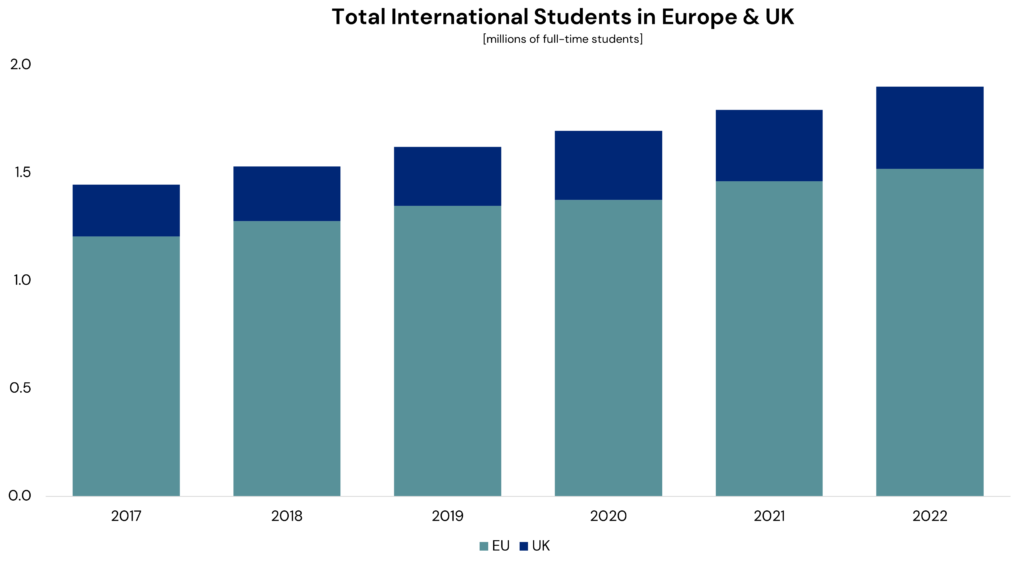
A key driver of growth has been students from outside Europe. Europe has an outsized number of highly ranked universities relative to its size,5 a prevalence of English-language courses (which are increasingly no longer limited to the UK and Ireland) at a comparatively cheaper cost of tuition and living compared to North America.6 These attributes taken together can explain the sharp rise in non-EU students studying in the bloc, whose numbers have grown 31% since 2016.7 In the UK, the growth has been even faster, at 59% over the same period.8
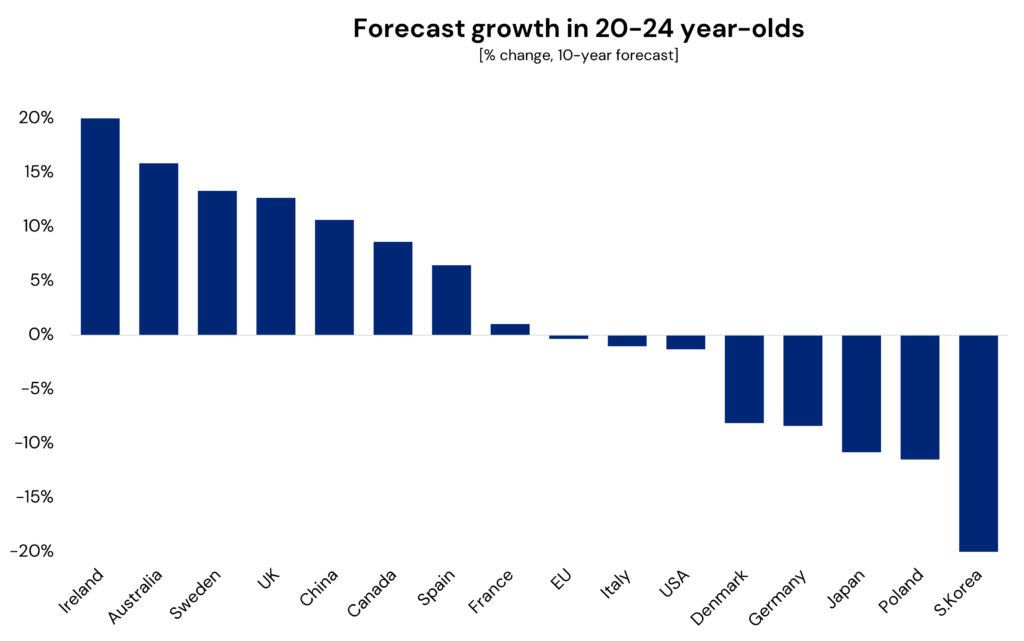
That said, there are demand-side risks to be mindful of. The demographic outlook for Europe is mixed; forecasts for some countries such as the UK, Spain and Sweden show a demographic ‘bump,’ with the number of university-aged people growing ahead of national population levels. However, in other nations, numbers are forecast to be broadly flat (France) or negative (Germany and the Netherlands). This suggests uneven growth in demand for higher education going forward.9
This mixed demographic outlook will mean greater reliance on international student demand, but there are tentative signs that may also be facing some headwinds. A recent policy change in the UK has removed the right to visas for international students’ family members.10 For now, this change represents tinkering around the edges and is unlikely to have a major impact on demand. It does, however, indicate a directional change in policy aimed at restricting overseas student numbers, presumably in a bid to bring down immigration figures. Such policy changes may incrementally dissuade would-be foreign students from studying in the UK, though demand may shift elsewhere, potentially to the benefit of other European countries. Despite such risk factors, the overriding view is one of positivity for higher education demand in Europe and therefore PBSA.
Supply factors
European student housing should be viewed within the wider context of the region’s housing market. Europe is currently facing a long-term, persistent housing shortage. Housing scarcity is not limited to major gateway cities, but is also the reality within mid-sized cities and even smaller university towns. Since 2010, Europe has built homes at a rate only 40% below pre-GFC levels,11 contributing to rising rents, increasing house-price-to-income ratios and worsening access to suitable housing. Demand for rental housing in cities remains robust, supported by long-term trends of immigration, urbanization and declining home ownership rates; as such, the imbalance between supply and demand is now fully entrenched.12
Students are, like all participants in the housing market, at the mercy of housing supply and demand. Shortages have fed through to the student market, with students finding accommodation increasingly unaffordable. Over the past two years, this has led to sharp growth in PBSA rents, with several UK cities reporting year-over-year growth in the high teens for 2023, and other markets experiencing growth well ahead of previous levels.13 The lack of supply is also leading to students being housed increasingly in unsuitable conditions; stories from the UK of students living in hotels or in completely different cities over an hour travel from campus are a clear symptom of insufficient student housing stock.
New investment in the sector should contribute to resolving the imbalance, but it will be a major challenge to fully close the wide gap between supply and demand. While there are nuances between markets, rising construction and development financing costs are making the delivery of new schemes less economical, evidenced by a sharp decline in the number of residential permits issued in several countries over the past year.14 Furthermore, restrictive planning laws and burdensome safety regulations are lengthening the time it takes for projects to be realized.
These factors inform our positive outlook on the rental housing market in Europe, which carries over into PBSA. The imbalance between supply and demand will likely persist and even worsen, driving very low vacancy and supporting strong rental growth for owners of residential and student housing real estate, or those who can deliver new schemes in those sectors.
Regulation haven
Regulations in Europe can act as a handbrake for residential rents, as we set out in our ISA Briefing, Controlling Interest: Keeping tabs on residential regulations. In nearly all continental European rental markets, rents cannot be increased annually at the landlord’s discretion, with rental levels for in-place tenants typically linked to a backward-looking index. During the recent ‘great reflation’ period, this has meant income from many rented residential properties did not keep pace with inflation. But student housing stands out from more traditional rental housing investments as having a cash flow profile far less impacted by the growth-muting tendencies of regulation.
In part, this is because PBSA often faces less regulation or stands outside of regulatory systems altogether. Students’ nature as transient, temporary residents means that their needs are rarely prioritized by local politicians, particularly compared to those of permanent residents. They typically only stay in a city for a few years, do not have dependents and their rental obligations often come with implicit or explicit parental guarantees. This means that PBSA is targeted for rent controls far less often than the wider rental market. Moreover, zoning and classifications for student accommodation are often distinct from standard rental housing, exempting it from regulations that limit absolute rent levels or restrict annual rental increases. Moreover, regulatory requirements on minimum unit sizes or lease lengths usually do not apply.
Even where regulated, PBSA benefits from its relatively short duration of tenancy. Given the vast majority of students study for 3-4 years, there is far greater annual turnover of tenants compared with the wider residential market. Faster turnover allows for landlords to more effectively mark rents to market levels. This means PBSA rents may better keep pace with inflation, even in jurisdictions where regulations do apply to the sector.
Increasingly mature
The increased maturity of student accommodation is another factor in its favor. The UK is clearly ahead of the rest of Europe in this regard, with a deep, liquid investment market, publicly traded REITs and a large number of established specialist operators. The sector’s wide acceptance from both tenants and investors means that we would consider it a ‘Core’ sector on our ‘going mainstream’ framework, as detailed in our ISA Portfolio View. Elsewhere in Europe the sector is considered more niche, but its growing acceptance means we would consider it ‘Near-Core’ on the same framework. Investment figures support the observation of a varying level of maturity for the sector—UK PBSA has made up 66% of investment volumes annual on average since 2014, despite the EU having 6.4 times the number of students.15
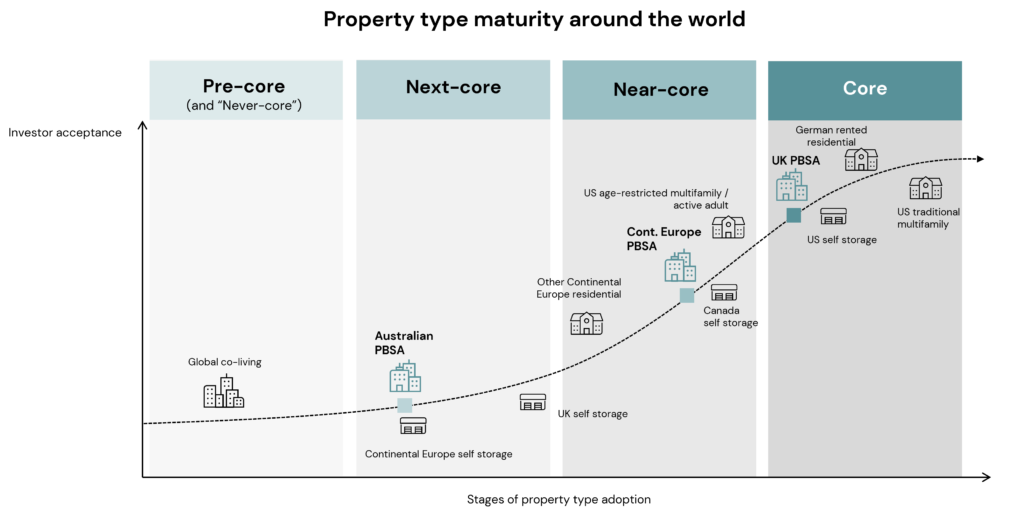
Over time, we expect this to change; the opportunity for investors to take advantage of the structural trends outlined above is likely to drive increased investment in the sector. Countries like as Spain or Italy have PBSA provision rates16 of below 10%, compared to more than 30% in some major UK markets,17 suggesting there is significant scope for delivery of new supply. Cities such as Milan, Madrid and Barcelona all have student populations of over 100,000 and multiple well-ranked institutions, giving them diverse demand bases and making them likely to be key growth markets for the sector in the coming years.
As niche sectors mature, greater liquidity and investor acceptance tends to lead to any yield premium they offer versus traditional sectors narrowing, as investors require less compensation for liquidity and transparency risks; such a pattern has already been observed in UK PBSA. This potential narrowing of yields in European markets is another factor behind our conviction that the sector is likely to offer attractive returns.
Comparisons with other regions
Student accommodation in much of Asia Pacific is still in a nascent stage, with relatively limited PBSA stock, few specialized operators and comparatively little institutional investment. The major exception in the region is Australia, which has characteristics similar to those of the sector in Europe and the UK, but is a number of years behind in its evolution. This suggests a similar path to maturity may lie ahead. Like Europe, Australia benefits from English-language courses at comparatively lower tuition costs than the US, while also offering post-study work visas. As a result, it has an even higher proportion of international students than most major European countries.18 Still, the Australian PBSA sector remains in its infancy as an investable property type. Stock numbers are low even compared to the most immature countries in Europe, with a student-to-bed ratios of 16-to-119 and significantly higher than the UK where it is around 3-to-1.
Traditionally, international students in Australia tap into private rental housing for accommodation. Both the private rental market and the PBSA sector in Australia have experienced tight occupier market fundamentals and experienced double-digit rental growth over the past two years.20 The solid performance has been primarily driven by strong migrant inflows, including international students, as well as high interest rates that encourage Australians to rent rather than buy, and relatively limited existing stock and new supply of all types of housing.
The United States, by contrast, has a more established student housing sector, but our view of the property type there is less favorable as compared to other regions. For a start, the demographics are less favorable given the population of 18-to-24 year-olds in the US is forecast to decline through 203321 and enrollment rates at 4-year institutions have remained roughly flat since 2010.22
An additional point of difference between US and European universities is their locations. Many top-tier US universities are in small cities in which a single school dominates the population and economy. Student housing properties in these markets are dependent on a single source of demand that controls enrollment growth and housing policy. Additionally, barriers to new supply are generally lower compared to major European cities, which allows for more new development to come in and disrupt the market. Taken together, these factors mean rent trends in these markets can be volatile. While there are similar university-centric towns in Europe, our investment focus is on the larger markets, where housing markets are tightest and there is a diverse demand base from multiple universities.
Looking ahead
- Europe’s leading universities should continue to attract demand from students, both domestic and international, positioning student housing for further growth. However, this growth may be uneven given mixed demographic outlooks and the potential for government interference. Investors should focus on the most-supply constrained markets, where there are resilient and varied sources of demand from multiple universities.
- European PBSA can act as a proxy for investment in the housing markets of supply constrained cities that face regulation, while generating cashflows more akin to investments in unregulated markets. We maintain our previously stated view that residential regulations can lead to lower cash flow volatility and thus may even mean better risk-adjusted returns. However, given the persistent housing shortages and continued demand for rental housing of all forms, we forecast rental growth across many European residential markets to be well ahead of inflation. This means in markets where residential landlords are constrained by inflationary indexation, owning PBSA may give investors a better opportunity to capture that market growth than does traditional residential.
- Elsewhere in the world, the investment case for student accommodation is less compelling. The US market, for example, is characterized by a relatively weak demographic profile for student demand. Moreover, in many cases investing in it involves exposure to smaller cities to which investors would not otherwise seek exposure. That said, PBSA markets with similar characteristics to Europe, such as Australia, can offer interesting opportunities for global investors. For investors seeking higher returns, entry into sectors can be especially interesting when they are at the early stages of their emergence.
Footnotes
1 Source: Eurostat
2 Source: Higher Education Statistics Agency (UK)
3 Source: Eurostat, Higher Education Statistics Agency (UK)
4 Source: Savills
5 The number of European universities in the top 2000 spots Center for World University Rankings (CWUR) league tables per capita is the highest of any world region, according to data from CWUR, Oxford Economics, and analysis by LaSalle.
6 Source: Educationdata.org
7 Source: Eurostat
8 Source: HESA
9 Assuming no change in the propensity of people in that age cohort to attend university.
10 UK Government introduced policy on January 1st 2024
11 Source: European Central Bank
12 For deeper analysis of European housing markets and the underlying supply imbalance see LaSalle’s ISA Outlook 2024.
13 Source: JLL
14 LaSalle analysis of data taken from the national statistics agencies of major European countries (Germany, UK, France, Spain, Sweden, Denmark, Finland, Italy, Portugal, Netherlands, Ireland)
15 Source: MSCI Real Capital Analytics
16 Metric defined as number of purpose-built student beds as a share of total enrolled population of students in higher education.
17 Source: JLL
18 Source: UNESCO
19 Source: CBRE
20 Source: SQM Research (for private rental market), as of November 2023; CBRE (for PBSA), as of August 2023
21 Source: Oxford Economics
22 Source: National Center for Education Statistics (US)
Important Notice and Disclaimer
This publication does not constitute an offer to sell, or the solicitation of an offer to buy, any securities or any interests in any investment products advised by, or the advisory services of, LaSalle Investment Management (together with its global investment advisory affiliates, “LaSalle”). This publication has been prepared without regard to the specific investment objectives, financial situation or particular needs of recipients and under no circumstances is this publication on its own intended to be, or serve as, investment advice. The discussions set forth in this publication are intended for informational purposes only, do not constitute investment advice and are subject to correction, completion and amendment without notice. Further, nothing herein constitutes legal or tax advice. Prior to making any investment, an investor should consult with its own investment, accounting, legal and tax advisers to independently evaluate the risks, consequences and suitability of that investment.
LaSalle has taken reasonable care to ensure that the information contained in this publication is accurate and has been obtained from reliable sources. Any opinions, forecasts, projections or other statements that are made in this publication are forward-looking statements. Although LaSalle believes that the expectations reflected in such forward-looking statements are reasonable, they do involve a number of assumptions, risks and uncertainties. Accordingly, LaSalle does not make any express or implied representation or warranty, and no responsibility is accepted with respect to the adequacy, accuracy, completeness or reasonableness of the facts, opinions, estimates, forecasts, or other information set out in this publication or any further information, written or oral notice, or other document at any time supplied in connection with this publication. LaSalle does not undertake and is under no obligation to update or keep current the information or content contained in this publication for future events. LaSalle does not accept any liability in negligence or otherwise for any loss or damage suffered by any party resulting from reliance on this publication and nothing contained herein shall be relied upon as a promise or guarantee regarding any future events or performance.
By accepting receipt of this publication, the recipient agrees not to distribute, offer or sell this publication or copies of it and agrees not to make use of the publication other than for its own general information purposes.
Copyright © LaSalle Investment Management 2024. All rights reserved. No part of this document may be reproduced by any means, whether graphically, electronically, mechanically or otherwise howsoever, including without limitation photocopying and recording on magnetic tape, or included in any information store and/or retrieval system without prior written permission of LaSalle Investment Management.
LaSalle’s Global CEO Mark Gabbay sat down with The Schwab Networks’ Oliver Renick to discuss the state of commercial real estate on the Friday, March 1 edition of Market on Close. He talks about regional banking and commercial real estate and goes over what potential Fed cuts mean for commercial real estate.
This article first appeared in February 2024 edition of the BAI Newsletter
For debt providers, the relative risk adjusted return profile for new real estate credit today is very attractive. Higher interest rates have helped to improve the return profile, and new loan detachment points are generally trending lower, particularly in instances where borrowers are willing to show support for underlying assets and commit additional cash to a transaction.
These attractive fundamentals for lenders were largely in place last year too, however transaction volumes across new acquisitions and refinancings were limited for a variety of reasons. By contrast, in 2024 we expect to see robust demand for debt financing solutions provided by real estate investment funds. This is due to both recent market developments and longer-term structural trends. In the shorter term, borrowers have begun to adapt to a higher cost of financing. This comes as no surprise given the dynamics behind the rapid increase in interest rates that abruptly ended 15 years of historically low rates. With the borrowing market adapting to this new environment, and with interest rates expected to stabilize and start to decline, we have also seen transactions start to move forward at the start of 2024. It is expected that debt will again become a common component of sponsors’ business plans in 2024.
In the longer term, the migration of commercial real estate lending activity away from banks and towards debt funds has been a dominant theme over the past 15 years. The long-running Bayes Business School study of UK CRE lending* found that, in the first half of 2022, debt funds exceeded domestic banks’ new originations for the first time.
Alternative lenders are poised to further expand their market share in the coming years. Bayes Business School estimates demand for real estate finance in Europe at €310 billion per year, and the current stock of outstanding real estate debt at €1.6 trillion. However, as underlying values have declined and loan-to-value ratios (LTVs) are down, traditional lenders may only be willing to advance around €1.3 trillion of the capital necessary to refinance loans maturing through 2027.
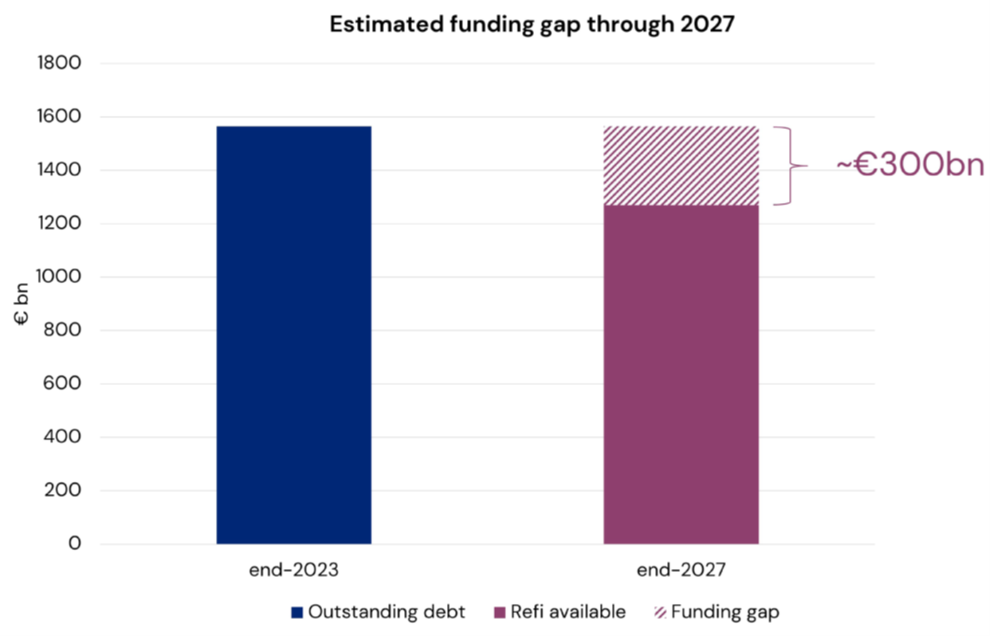
Source: MSCI Real Capital Analytics, Bayes Business School, CBRE, JLL, LaSalle (01/24).
Notes: Past performance is not indicative of future results. There is no guarantee that any trends shown herein will continue or that any forecasts shown herein will materialize as expected. Funding gap estimates based on Bayes Business School assessment of debt outstanding and maturing annually, and LaSalle forecasts of capital value change.
Funds will therefore encounter a significant volume of investment as they play an ever-increasing role in addressing the real estate financing gap, created by banks’ ongoing retrenchment and the considerable quantities of debt falling due for refinancing in the short run.
Despite these attractive dynamics for non-bank real estate lenders, this remains a market with potential for real dispersion in performance between fund managers. Delivering attractive risk-adjusted returns for investors will require several crucial ingredients, including having a well-resourced platform across all facets of the business that is established in the market and leveraging analytical tools to negotiate with borrowers.
The benefits of an established market presence and platform
For alternative lenders to remain competitive, they must be able to offer sponsors a wide range of capital solutions. The flexibility afforded by a variety of debt structures should help borrowers transition to a higher-rate environment, allocate risk to where it is most suitably borne and ensure that good-quality properties continue to have access to liquidity.
In other words, both debt funds and borrowers benefit from differentiated pockets of debt capital, ranging from senior lending, whole loans, levered whole loans and mezzanine, including development and refurbishment financing. Borrower demand for bespoke financing solutions makes this an attractive environment in which to be active and to deploy capital across a diverse range of market opportunities.
As a lender, a natural complement to this diversity of investment strategies is a wider geographic scope. The ability to deploy capital across borders and across currencies further enhances funds’ ability to be selective.
Structuring is also critical, particularly when underwriting risk for assets that traditional lenders are less willing to finance. Appropriately managing risk while offering more structured solutions, utilizing a range of protections such as standard loan covenants or business plan targets are all measures that help align interests between borrowers and lenders.
Scalability also plays a critical role in a lender’s ability to remain competitive in today’s environment. – While refinancing needs can be met by more traditional senior-mezzanine lending structures, an increasingly prevalent structure sees a whole loan provided by an alternative lender. The whole loan provider provides a single counterparty and point of contact for a borrower to work with, while allowing for more certainty as well as enhanced control for the lender. This combination of a flexible investment mandate, cross-border presence and a robust approach to underwriting and deal structuring is fundamental to striking the right balance between supporting borrowers and protecting investors’ capital. These attributes will naturally be found in those established players with a proven track record of transacting and who can offer certainty and speed of execution.
Those same funds will also disproportionately be those with access to a wider asset management platform, also to borrowers’ benefit.
Ultimately, a collaborative real estate debt investment manager will not be extending loans with the express intention of eventually taking over or outright owning the assets. But being part of a large platform with asset management capabilities is not just an important safety net in the event that a restructuring and transfer of ownership does take place. It also helps pre-empt and avoid that situation. Drawing on those asset management capabilities means that lenders can identify red flags in a deal early-on, and in turn work with their borrowers and help provide insight into ways to maximise value.
Leveraging wider analytical tools
As detailed in LaSalle’s ISA Outlook 2024, we also believe that, to lend successfully in a challenging market, debt providers need to maintain a targeted approach, effectively sourcing transactions by scrutinising market data and making use of local market presence.
Tapping into a wider pool of analytical tools, data and longer-term outlooks is invaluable when working with borrowers and understanding their commercial horizons. For example, in the absence of comparable transactions to act as reference points for how certain asset valuations have rebased, the ability to conduct price discovery by analysing, understanding, and underwriting fundamentals from the point of view of an equity sponsor is key.
In some instances, fresh borrower equity is required to support elongated business plans. To that end, fostering a good relationship with borrowers by working with their reformulated business plans is fundamental to unlocking the right structured financing solutions, especially in the face of forthcoming debt maturities. In a market impacted by rising interest rates and geopolitical convulsions, finetuning capital requirements quickly can be only undertaken by a real estate manager with the capabilities and resources to conduct that deep analysis.
Good data is also important when seeking to invest across a range of different real estate assets. Currently, lender appetite is focused on sectors with especially strong occupier fundamentals, and their ability both to capture rental growth in line with inflation and to access relatively liquid capital markets. Logistics, residential, student and select operational sectors, such as hospitality, are widely considered to offer resilient fundamentals. This is resulting in a reasonable degree of liquidity for originating new financings in those preferred sectors, but insight remains crucial to picking both markets and sponsors with the capabilities to access such growth. More importantly and particularly in scenarios whereby strong occupational trends are obvious, it is still critical to understand cost structure, and ultimately capital markets in an environment where very little transaction data exists. Access to good quality data is a key component of determining underlying value of an asset in today’s environment.
Outside of those preferred sectors with a more obvious path to cash flow, the traditional sectors of offices and retail have been most challenged. That is especially true for offices outside of prime CBD, whereby a large amount of uncertainty exists, arising from the cloud of uncertainty surrounding future occupier demand and what the impact on capital markets over the long run will be. Data-led insights and a proprietary view on whether, how and where the office market will recover is therefore an important advantage for lenders. For example, sustainability credentials are increasingly important as a key determinant of asset performance in the office sector. Wellness, energy efficiency, sustainability accreditations – all of these are metrics that need to be analysed to forecast occupier demand, and in turn, valuation trends.
Opportunities and challenges for 2024
Since the global financial crisis, commercial real estate lending has evolved towards a diverse pool of capital providers which includes both more traditional banks, but also debt funds. In 2024, this trend is expected to continue.
Despite the scope for funds to earn more market share this year, lenders face many potential pitfalls. When it comes to origination, sourcing financing opportunities will require a focus on parts of the market where supply and functionality has lagged societal trends. These situations enable rental growth at or above inflation, aligning with what individual and corporate occupiers want from their spaces. Likewise, credit selection and structuring will require a keen eye on lending basis and coverage levels, alongside the underlying real estate capabilities of the sponsors.
Real estate credit is currently a highly attractive asset class. But to ensure that both fund investors and borrowers are being served well requires a debt platform that can provide a variety of leverage solutions, tap into a rich bank of data/analytics, and draw on insights from a wider bench of real estate specialists, all underpinned by a market-leading team with exceptional borrower relationships. Those are the characteristics that investors and borrowers alike should prioritise in their partners.
*From 2018, The UK Commercial Real Estate (CRE) Lending Survey is based at Bayes Business School, City, University of London. The Survey is a unique and comprehensive record of CRE lending, and an industry standard source of information, regularly referenced in the national financial press and trade publications: https://www.bayes.city.ac.uk/ faculties-and-research/centres/real-estate/bayes-cre-lending-report. Up to 2017, the study was published by De Montfort University, Leicester.
This article first appeared in Winter 2024 edition of PREA Quarterly
LaSalle’s Global Head of Research and Strategy, Brian Klinksiek, discusses why it’s important to go beyond heuristics to find relative value in global real estate.
Which global real estate markets are ahead and which are behind in the process of repricing?
This question, along with its many variations, has been by some margin the most frequent one asked of me when presenting LaSalle’s recently released ISA Outlook 2024. Investors understandably want to know where they can find value amid real estate capital markets that continue to adjust to higher interest rates. They want to focus their efforts on geographies and sectors for which the bulk of the price adjustment is in the rearview mirror instead of still lying ahead.
Attempts to answer this question with numbers often begin with simple comparisons of peak-to-current value declines. The implicit logic is that larger-measured todate declines for a market indicate that it is farther along in the repricing process or, simply, that it is cheaper and thus attractive. But these sorts of analyses are plagued by a range of measurement and interpretation issues that complicate comparisons. At best, they can lead to contradictory conclusions; at worst, they may contribute to missteps in investment strategy. Some of the key challenges are explored below.
Want to read more?
Chase McWhorter, Institutional Real Estate, Inc.’s managing director, Americas, recently spoke with Richard Kleinman, Americas Head of Research and Strategy and co-CIO at LaSalle, to discuss what institutional real estate investors can expect in the new year.
They covered a wide range of topics in their conversation, including the biggest unknowns for 2024, sector outlooks, credit, capital fundraising and key differences between the real estate markets in the US and Canada.
On November 28, LaSalle’s Global Head of Research and Strategy, Brian Klinksiek, gave a keynote address at Canadian Real Estate Forum’s annual Global Property Market conference in Toronto where he discussed our global real estate investment themes for 2024:

- The ongoing search for peak rates
- Solving the capital stack equation
- Favored sectors coming off the boil
- Moving beyond bifurcation in the market
- The changing definitions of quality and core
These themes are discussed in detail in ISA Outlook 2024, our annual publication designed to help our clients and partners navigate the year ahead. It brings together smart perspectives and investment ideas from our teams around the world, based on what we see across our more than 1,500 assets that span geographies, property types and risk profiles.
CHICAGO (Dec. 5, 2023) – The US and Canadian real estate markets continue to see subdued transaction volume and a wait-and-see approach from investors amid their respective central banks’ campaigns to snuff out inflation through interest rate hikes. LaSalle’s Insights, Strategy and Analysis (ISA) Outlook 2024 makes the case that secular trends, not cyclical trends, may hold answers as to where winning property types will land in 2024, with the early half of the year looking similar to 2023 and the potential for a rebound later in the year.
The report will be released in regional chapters throughout November and December, and can be viewed at: www.lasalle.com/Outlook2024.
The ISA Outlook 2024 looks at five key themes from a global and regional level:
- The search for peak interest rates
- Solving the capital stack equation
- Coming off the boil
- Beyond bifurcation
- The changing definition of quality and core
On a broad basis in the Americas, the report observes a potential recovery later in 2024, a continued focus on interest rates and their impact and the potential for supply weighing on real estate fundamentals.
Brian Klinksiek, Global Head of Research and Strategy at LaSalle, said: “Significant unknowns remain in the global real estate market as we head into 2024, including interest rates, geopolitical tensions, and whether major economies may tip into recession. While it’s very difficult to time markets, data on previous down cycles suggest that it’s often during unsettled periods that savvy investors can find strong value in real estate, making this a potentially strong vintage for investment.”
Select ISA Outlook 2024 findings for North America include:
- The residential (encompassing both single-family rental and apartments) sector continues to see healthy fundamentals. However, as the report notes, residential properties that were bought at peak pricing in 2021 and 2022 and financed with elevated levels of floating rate debt will need to either be recapitalized or sold which may cause a cooling effect on the sector in 2024. The industrial sector will also cool from peak performance levels, with pockets of softening rents in some markets. Both residential and industrial will benefit in time from the reduced levels of new development starts in 2023 and beyond.
- Select sub-sectors of retail such as US grocery-anchored properties are seeing a boost in investor confidence. Limited new supply and a better understanding of which assets are better positioned is creating confidence that these properties can be an accretive portion of a balanced real estate portfolio.
- The question around the future of office properties continues to be pervasive, and something investors are watching closely. The report observes a divide between Canadian and US office markets with Canada slightly better positioned than the US due to lease structures. The US continues to deal with substantial work-from-home headwinds. The report notes that widespread distress may lead to high-risk, high-reward opportunities for investors.
Rich Kleinman, Co-CIO and Head of Research & Strategy for the Americas at LaSalle, said, “Looking at real estate investment solely through the lens of interest rates means you’re missing the bigger picture as we believe sectors and markets will adjust to rates at varying speeds. Investors with dry powder, flexibility and who can identify price gaps are likely to come out as winners in this transitional market.”
Chris Langstaff, Head of Research & Strategy for Canada at LaSalle, said, “Looking to 2024, we expect that in the midst of a continued softening of the Canadian economy in the near term, the strong migration trends will support long-term growth of the Canadian economy. This will particularly benefit the apartment and industrial sectors when economic growth resumes.”
About LaSalle Investment Management | Investing Today. For Tomorrow.
LaSalle Investment Management is one of the world’s leading real estate investment managers. On a global basis, LaSalle manages approximately $89 billion of assets in private and public real estate property and debt investments as of Q3 2023. LaSalle’s diverse client base includes public and private pension funds, insurance companies, governments, corporations, endowments and private individuals from across the globe. The firm sponsors a complete range of investment vehicles including separate accounts, open- and closed-end funds, public securities and entity-level investments. For more information, please visit www.lasalle.com, and LinkedIn.
Forward looking statement
The information discussed above is based on the market analysis and expectations of LaSalle and should not be relied upon by the reader as research or investment advice regarding LaSalle funds or any issuer or security in particular. The information presented herein is for illustrative and educational purposes and is not a recommendation, offer or solicitation to buy or sell any securities or to adopt any investment strategy in any jurisdiction where prohibited by law or where contrary to local law or regulation. Any such offer to invest, if made, will only be made to certain qualified investors by means of a private placement memorandum or applicable offering document and in accordance with applicable laws and regulations. Past performance is not indicative of future results, nor should any statements herein be construed as a prediction or guarantee of future results.
Company news


No results found
LONDON (29 November 2023) – Despite a challenging macroeconomic picture, European real estate has begun to acclimatise to higher interest rates and will offer some of the world’s most attractive supply-demand dynamics next year, according to the Insights, Strategy and Analysis (ISA) Outlook 2024 report published by global real estate investment manager LaSalle Investment Management (“LaSalle”).
Last year’s report predicted European macro headwinds and a stall in capital markets activity, but also strong real estate market fundamentals. Looking ahead, the 2024 ISA Outlook for Europe describes how investors that are ready to move out of waiting mode, with realistic expectations for operating income growth, can find compelling new investment opportunities.
This year’s report identifies five trends that differentiate Europe and earn the region’s real estate assets an important place in investors’ property portfolios:
- Europe’s city centre vibrancy and occupier demand have strongly rebounded
- The region’s firms and individuals are taking the lead in decarbonization
- Skilled migration is supporting growth
- Expansion of the EU’s single market is regaining traction
- The high prevalence of inflation-index commercial leases in the EU has helped the region’s property cash flows to better keep pace with inflation
These trends are driving demand in particular for logistics and rental housing, as well as superior performance by offices in the ‘super-prime’ segment.
Macro challenges but appealing supply-demand dynamics
Having defied expectations of a recession in 2023, Europe still faces elevated recession risk. Inflation has begun to abate but proven comparatively stubborn, particularly in the UK, inducing higher policy rates from the ECB and Bank of England. As the delayed impact of rising rates begins to bite, European property markets enter 2024 searching for a clear peak in interest rates – as well as an end to the war in Ukraine.
Europe’s occupational fundamentals are coming off the boil of recent years, with rental growth set to cool to its lowest level since 2020 next year. However, we expect that average rent growth should remain positive, especially for logistics and rental housing – even in an economic downturn – helped by low vacancy rates relative to history.
In logistics, while demand has cooled across Europe and vacancy is ticking up from extremely low levels, a shrinking construction pipeline means that the long-term revenue growth outlook remains very bright. The scope for further e-commerce market penetration is, conversely, a headwind for European retail. However, assets such as outlet centers with turnover-linked leases have lifted revenues in line with nominal sales growth.
Investors in Europe can access strategies rooted in barriers to supply, arising from Europe’s high (and rising) constraints on development. Nowhere does this apply more than in the residential sector, where the undersupply is chronic, while migration powers long-term demand growth. Surging student demand and rising mortgage rates are causing people to rent for longer and until later in life, boosting demand further in Purpose-Built Student Accommodation and rental housing specifically.
Opportunities on the leading edge of offices
European city centers are returning to their pre-Covid levels of vibrancy, attracting office occupiers and capital to more central locations. To better understand how this spectrum of office quality is evolving, we recommend going beyond ‘bifurcation’ alone in segmenting the market. The widening gaps between leading and lagging offices are determined by a range of many factors like location, design, amenities and sustainability.
In London, “super-prime” office buildings command significant rent premiums to “prime” averages. Since 2019, the UK capital’s median office relocation was from a non-BREEAM-rated EPC-D building to BREEAM Excellent / EPC-B or better. Across Paris and London, new offices’ vacancy rate is c.2%, three times less than for second-hand offices. Notably, centrally located, modern offices in Paris and Munich have defied subdued transaction levels and remain liquid, with sales attracting respectable bidder pools.
Alternative lenders gain momentum
Outside of these pockets of investment activity, alternative lenders are well positioned to solve capital stack equations in 2024, filling gaps created by banks’ reduction in LTVs to provide debt financing that generates attractive risk-adjusted returns.
Dan Mahoney, Head of European Research and Strategy at LaSalle, said: “What we are seeing in Europe is real estate markets beginning to acclimatise to the higher-rate environment and gradually shift out of the waiting mode that has chilled transaction volumes in 2023. The continent’s distinct combination of rebounding city vibrancy, high supply barriers and compelling conditions for debt make it an important allocation in global real estate portfolios.”
Brian Klinksiek, Global Head of Research and Strategy at LaSalle, added: “Significant unknowns remain in the global real estate market as we head into 2024, including interest rates, geopolitical tensions, and whether major economies may tip into recession. While it’s very difficult to time markets, data on previous down cycles suggest that it’s often during unsettled periods that savvy investors can find strong value in real estate, making this a potentially strong vintage for investment.”
Ends
About LaSalle Investment Management | Investing Today. For Tomorrow.
LaSalle Investment Management is one of the world’s leading real estate investment managers. On a global basis, LaSalle manages approximately $78 billion of assets in private and public real estate property and debt investments as of Q1 2023. LaSalle’s diverse client base includes public and private pension funds, insurance companies, governments, corporations, endowments and private individuals from across the globe. LaSalle sponsors a complete range of investment vehicles, including separate accounts, open- and closed-end funds, public securities and entity-level investments. For more information, please visit www.lasalle.com, and LinkedIn.
NOTE: This information discussed above is based on the market analysis and expectations of LaSalle and should not be relied upon by the reader as research or investment advice regarding LaSalle funds or any issuer or security in particular. The information presented herein is for illustrative and educational purposes and is not a recommendation, offer or solicitation to buy or sell any securities or to adopt any investment strategy in any jurisdiction where prohibited by law or where contrary to local law or regulation. Any such offer to invest, if made, will only be made to certain qualified investors by means of a private placement memorandum or applicable offering document and in accordance with applicable laws and regulations. Past performance is not indicative of future results, nor should any statements herein be construed as a prediction or guarantee of future results.
Company news


No results found
With shifting interest rates, dynamic occupier fundamentals and deepening bifurcation within sectors, ISA Outlook 2024 asks how real estate investors should respond to rapidly changing market conditions. To answer these questions and more, we published four separate chapters covering the global and regional outlooks over the course of November and December.
Download the full document now, or individual chapters covering the Global, European, North American and Asia Pacific outlooks are available in the tabs below.
Chapters
The global macroeconomic context for real estate remains unsettled, and more so than earlier in 2023. Until late summer, interest rates in most major markets exhibited high volatility, but little overall trend. They moved mainly sideways, owing to cooling inflation and expectations that central banks were reaching the end of their tightening cycles. This was helpful in setting a pricing baseline for real estate investors. But the outlook for rates and thus real estate pricing has become more unsettled of late.
What does this mean for real estate and how does it intersect with other key trends?
Authors

Global Head of Research and Strategy

Managing Director, Global Research and Strategy
No results found
European property markets have been waiting for a peak in European Central Bank and Bank of England policy rates, for an end to the war in Ukraine and for bid-ask pricing spreads to resolve. Investors ready to move out of waiting mode in 2024 can benefit from rebased prices, opportunities to solve capital stack equations, and strong fundamentals in many sectors.
In this chapter of ISA Outlook 2024, we examine the state of the European market and conclude with recommendations for specific investment strategies – underpinned by realism and targeted toward areas of forecast resilient income growth.
Authors

Europe Head of Research and Strategy

Europe Head of Core and Core-plus Research and Strategy

Chief Economist
No results found
Against a volatile macroeconomic backdrop and with growth expected to slow, we believe that in 2024 it will be the trajectory of interest rates that will have the greatest impact on real estate values in the US and Canada.
As investors continue to adapt to cooler conditions, this chapter of ISA Outlook 2024 examines the current landscape and looks ahead to the coming year, including where we see select opportunities emerging, as well as variation between the two markets. We conclude with three broad strategic themes and recommended strategies where investors may consider deploying their capital.
Authors

Americas Head of Research and Strategy

Canada Head of Research and Strategy
No results found
The sheer size and complexity of the Asia Pacific region means real estate markets and investment opportunities are as diverse as the region itself.
In the final chapter of ISA Outlook 2024, we discuss this complexity and how China’s new economies – such as high-tech manufacturing and biotechnology – are growing rapidly and, after more than two decades, Japan is hoping to bid sayōnara to deflation. In other key parts of the region – Australia, Hong Kong, Singapore and South Korea – central banks are near the end of their rate-hiking campaigns in a bid to lower inflation which, as in the rest of the world, could lead to a rebound in transaction activity.
Authors

China Head of Research and Strategy

Senior Strategist, Asia Pacific Research and Strategy
No results found
Published every year since 1993, LaSalle’s annual ISA Outlook is designed to help our clients and partners navigate the year ahead. It brings together smart perspectives and investment ideas from our teams around the world, based on what we see across our more than 1,500 assets that span geographies, property types and risk profiles.
As always, we welcome your feedback. If you have any questions, comments or would like to learn more, please get in touch by using our Contact Us page.
The real estate investable universe in 2023
In an uncertain market, it is tempting to prioritize cyclical questions such as the risk of recession and the path of interest rates over structural topics with longer-run implications. But challenging periods in real estate markets can also be attractive times to build exposure to the asset class.1 Questions about how to build portfolios do not diminish in importance just because bond market volatility makes front-page news. In our view, one of the most useful starting points for approaching portfolio construction is having a sense of the size of the real estate investable universe and its subcomponents. This is why we regularly update our estimates of the real estate investable universe and have done so consistently since 2005.
We first shared our latest estimates for the size of the global real estate universe in the 2023 edition of ISA Portfolio View. As described there, the vast scale of real estate as an asset class is among the key pillars supporting the case for including property in multi-asset portfolio. But putting a thoughtful number on the size of the asset class is easier said than done. We believe it is worth the effort because quantifying the size and distribution of the market — rather than just a subset covered by a particular index or data source — helps investors sharpen their thinking on target allocations by asset class, geography and investment structure. A full description of our methodology, data sources and summary table by country is available here, and we are glad to provide additional detail upon request.
We estimate market size, defined as aggregate gross asset value, for three nested segments, shown below. The largest and most comprehensive estimate is for all property held for the income it provides, inclusive of all types of owners (except owner-occupiers) and all quality levels. Using a separate methodology, we also estimate real estate owned by institutional investors, and by one particular type of institutional investor — those whose equity is publicly traded.
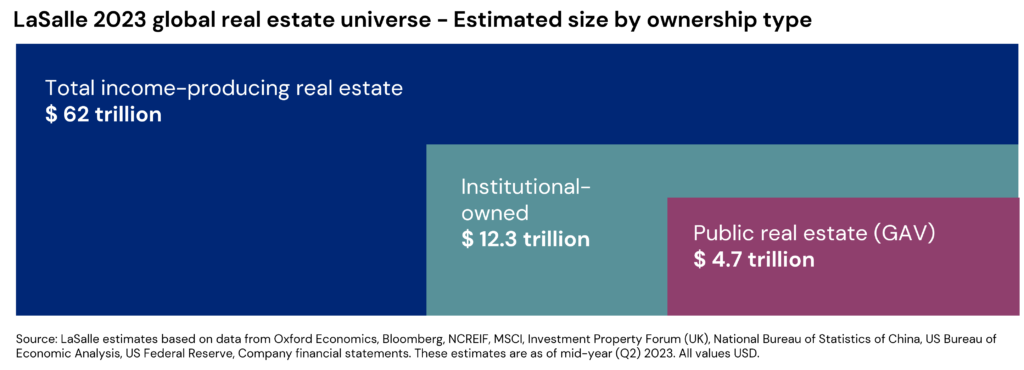
Our analysis shows that one fifth of global real estate is owned by institutional investors, and 40% of that institutional ownership is by listed companies. The estimates also break down market size by country, property type and city, using a methodology combining several bottom-up and top-down sources.
We take a closer look in this ISA Briefing at three key findings from the real estate universe analysis: (1) global income-producing real estate has recently ebbed to a below-average size relative to GDP, (2) real estate value has a fairly even distribution across the three major global regions and (3) those regions differ significantly in how real estate is distributed across metros, implying different optimal diversification strategies.
1: Real estate is large, but at a cyclical ebb
Figures in trillions can be so enormous that they lose some meaning — so it is helpful to put those numbers in context. An illuminating comparison is to put income producing real estate alongside other asset classes like stocks and bonds, as shown in the graph below.
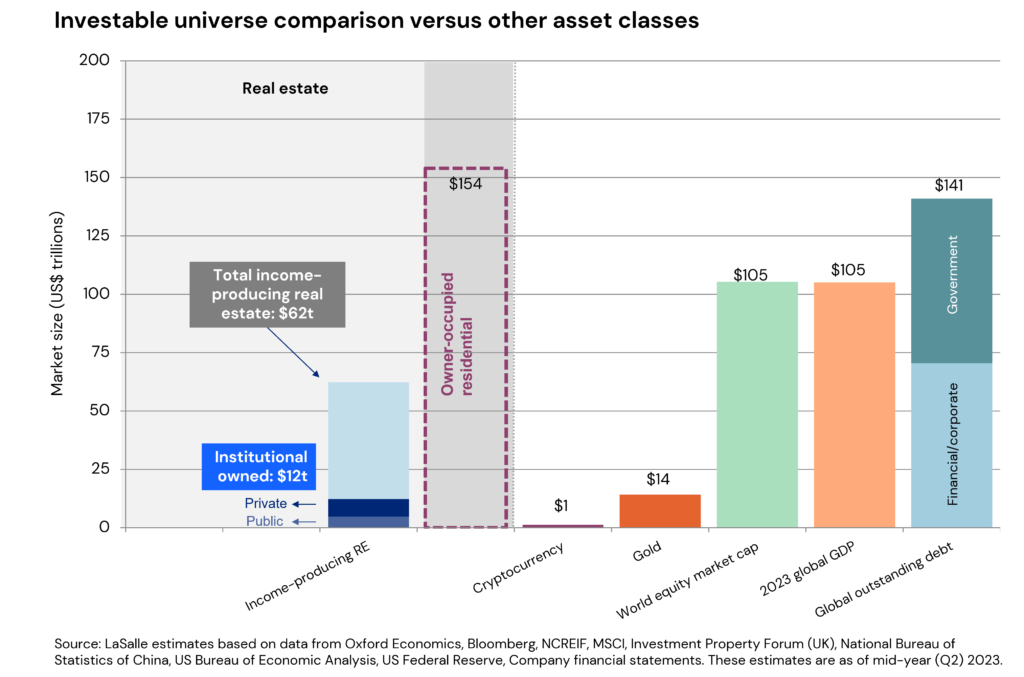
These estimates show global real estate is a smaller sibling to stocks and bonds but very much in the same family of major asset classes. Notably, owner-occupied residential real estate, which is not included in LaSalle’s real estate estimates, is significantly larger in size than all income-producing property, and even larger than the global fixed-income market.
Another useful comparator, shown below, is against global GDP. We estimate that real estate is equal to 60% of global GDP in 2023. This puts it at a low ebb relative to recent history. This is consistent with the historic pattern of real estate comprising a higher share of GDP late in expansions and then a lower share of GDP in repricing episodes. Currently our real estate market size estimate is near previous cyclical lows as a share of GDP seen in 2009-2012. Since 2000, our real estate market size estimates have averaged 68% of global GDP.
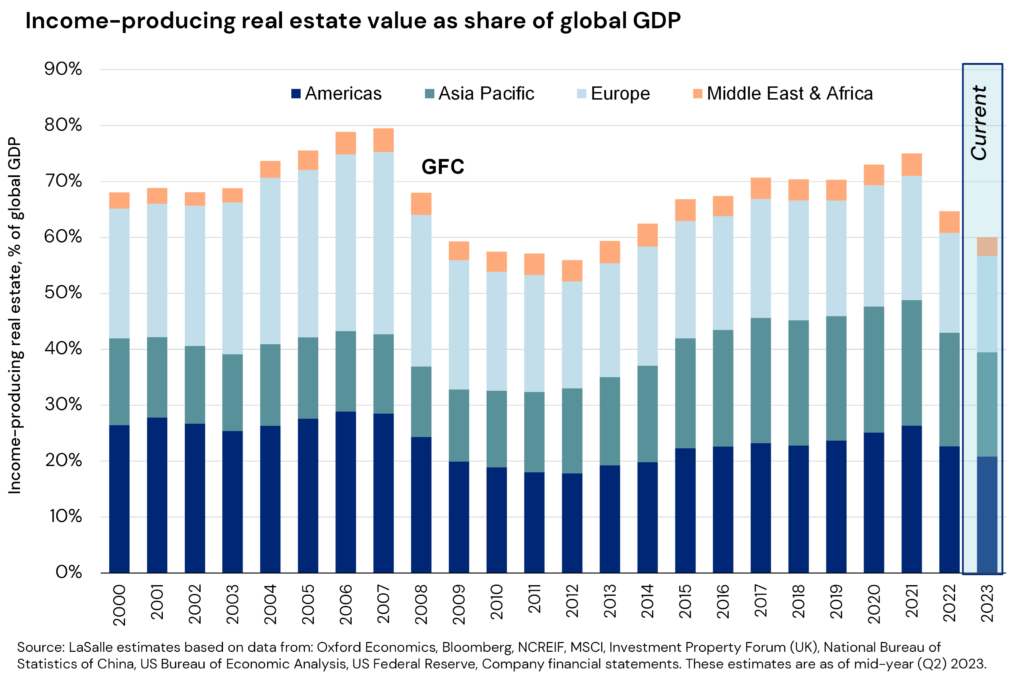
2: Still a global asset class
A second key finding from LaSalle’s universe estimates is the relatively even split in value observed between the three major regions of the Americas, Asia Pacific, and Europe. We estimate that 35% of income producing property is in the Americas, 31% in Asia Pacific, and 29% is in Europe. We believe these estimates from LaSalle’s real estate universe analysis better reflect the true opportunity set than other splits based on simple GDP or real estate indices, which can sometimes be lopsided based on where coverage is greatest or which types of investment fund products predominate. For example, 67% of the MSCI Global Property Fund Annual Index AUM is in North America.2
The split above suggests an even distribution of opportunities by region. At the same time, our national estimates also show global diversification can be achieved with a small number of countries. The eight countries with the most institutional-invested real estate together account for 70% of the invested universe. A focus on these larger countries — as well as multi-country funds — can enable investors to efficiently achieve diverse exposures, while also managing the challenges that come with differences in market practices, currency, regulation and building market knowledge.

3: Big regional differences in universe at city level
Our third notable finding emerges when zooming in one level further from the national level to individual cities. Cities and their surrounding metropolitan areas form the underlying building blocks of the real estate universe; they are often the basic level of analysis investors have in mind when comparing market allocations.
LaSalle estimates institutional real estate market size are for the entire metropolitan (metro) market — including the principal city and its suburbs that are economically connected to it, adopting official metropolitan area definitions from national statistical agencies where available.

Real estate held in institutional investor portfolios is highly concentrated in the largest metros, and these local market size estimates highlight the degree of that concentration. The 40 largest metropolitan real estate markets account for 58% of all institutional property. Some of the world’s largest metro areas dwarf many individual countries when it comes to institutional real estate ownership. Our latest estimates show that there is likely more institutional-owned real estate in Greater Tokyo than in all but three of the 201 countries covered in our estimates.
The metro market size distribution varies considerably across regions, with important implications for portfolio strategy. Institutional real estate ownership in Asia Pacific is more concentrated in its largest metros than in any other region. And its real estate is far more concentrated in a few cities than its population. In Asia Pacific, 18 metros account for 75% of institutional property, whereas the equivalent metro total is 52 in the Americas. In Europe, real estate is the most dispersed across cities, reflecting its more fragmented quilt of different jurisdictions. Over 100 European metros must be amalgamated to account for 75% of the regional total. Such dispersion makes the task of setting target markets even more complex, which is where tools like the recently released LaSalle European Cities Growth Index (ECGI) can help.
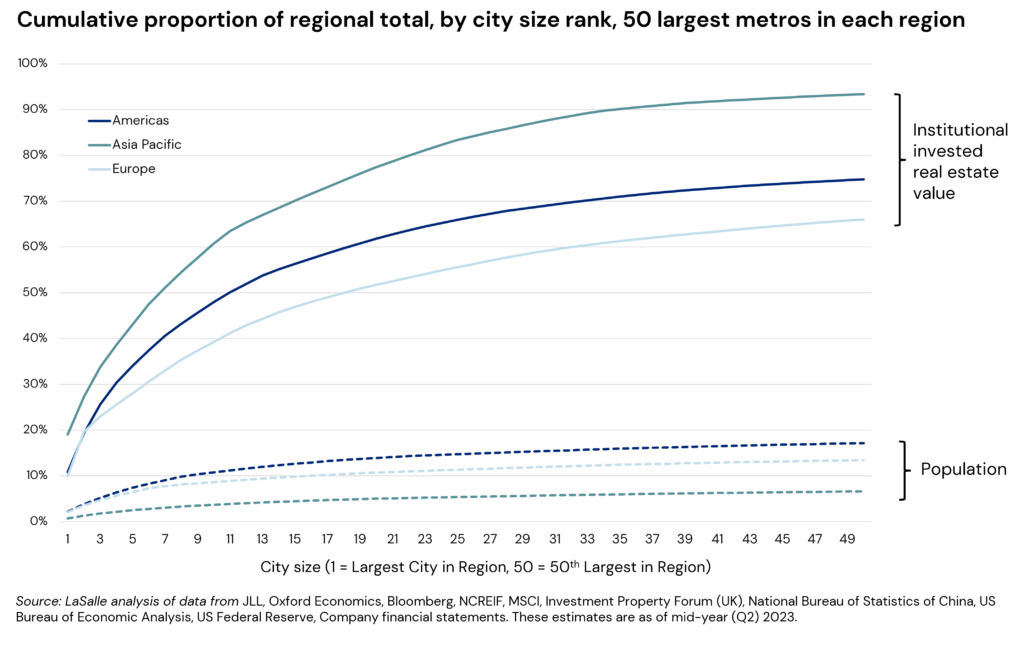
These differences impact investment strategy and approaches to diversification. Asia Pacific’s concentration of large institutional markets implies that investors may be able to achieve diversification by investing in fewer metros, but that it is also a region where each “bet” on geo-market allocation matters more. In Europe and North America, investors are more active across a larger number of medium-sized markets, offering diversification benefits as well as challenges in terms of access and efficiency.
Looking ahead
- The real estate universe is massive — it constitutes a meaningful portion of all global investable assets across asset classes — and therefore is a key piece of diversified mixed asset portfolios. Its ratio to global GDP is now below its long-term average, near past cyclical lows seen on this measure. Over a ten-year horizon, we expect real estate to grow as a share of GDP.
- The real estate universe is evenly dispersed by region (though concentrated by country and city). A globally balanced portfolio would give roughly a one-third weighting each to North America, Asia Pacific and Europe.
- The concentration of institutional real estate in highly transparent countries and in major metro areas implies that investors can achieve a good degree of diversification with a small number of countries and moderate number of metro markets, with differences across region.
- Investable universe estimates can help investors devise ‘neutral weights’ for markets and sectors, which they can then adjust based on structural considerations (e.g. tax status) and their views of relative value. We look forward to sharing our outlook and strategic recommendations for 2024 real estate investment in our upcoming ISA Outlook 2024, the first installment of which will be released on November 14.
Footnotes
1 Vintages around the time of market disruption tend to outperform, according to LaSalle analysis of data from the INREV Global IRR Index through Q4 2022. See page 30 of our ISA Portfolio View for a more complete discussion of this analysis.
2 Source: MSCI. Data as of 2022 (most recent available).
Important Notice and Disclaimer
This publication does not constitute an offer to sell, or the solicitation of an offer to buy, any securities or any interests in any investment products advised by, or the advisory services of, LaSalle Investment Management (together with its global investment advisory affiliates, “LaSalle”). This publication has been prepared without regard to the specific investment objectives, financial situation or particular needs of recipients and under no circumstances is this publication on its own intended to be, or serve as, investment advice. The discussions set forth in this publication are intended for informational purposes only, do not constitute investment advice and are subject to correction, completion and amendment without notice. Further, nothing herein constitutes legal or tax advice. Prior to making any investment, an investor should consult with its own investment, accounting, legal and tax advisers to independently evaluate the risks, consequences and suitability of that investment.
LaSalle has taken reasonable care to ensure that the information contained in this publication is accurate and has been obtained from reliable sources. Any opinions, forecasts, projections or other statements that are made in this publication are forward-looking statements. Although LaSalle believes that the expectations reflected in such forward-looking statements are reasonable, they do involve a number of assumptions, risks and uncertainties. Accordingly, LaSalle does not make any express or implied representation or warranty, and no responsibility is accepted with respect to the adequacy, accuracy, completeness or reasonableness of the facts, opinions, estimates, forecasts, or other information set out in this publication or any further information, written or oral notice, or other document at any time supplied in connection with this publication. LaSalle does not undertake and is under no obligation to update or keep current the information or content contained in this publication for future events. LaSalle does not accept any liability in negligence or otherwise for any loss or damage suffered by any party resulting from reliance on this publication and nothing contained herein shall be relied upon as a promise or guarantee regarding any future events or performance.
By accepting receipt of this publication, the recipient agrees not to distribute, offer or sell this publication or copies of it and agrees not to make use of the publication other than for its own general information purposes.
Copyright © LaSalle Investment Management 2023. All rights reserved. No part of this document may be reproduced by any means, whether graphically, electronically, mechanically or otherwise howsoever, including without limitation photocopying and recording on magnetic tape, or included in any information store and/or retrieval system without prior written permission of LaSalle Investment Management.
At a recent CREFC Europe event co-hosted by LaSalle and property developer Regal London, representatives from the real estate industry’s leading debt funds, banks, and developers came together to discuss the outlook for European real estate credit markets.
Hosted at LaSalle’s new London offices, the open-forum discussion between all participants covered topics such as the (re)financing environment for borrowers and lenders, where lenders and borrowers see best value and greatest opportunity, and who should assume the responsibility for bearing the costs of delivering sustainable real estate.
A higher interest-rate environment, quick on the heels of the pandemic, makes this an important juncture for participants in this diverse and opaque market to share perspectives. Introducing the session, Dominic Silman, LaSalle’s European Head of Debt and Value-Add Capital Research and Strategy, compared analysing real estate debt markets to the parable of the blind men and the elephant. Each interprets what they can feel, depending on the part of the elephant that they are holding – from snake to tree to fan. Likewise, real estate debt markets are covered by a variety of different data sets which, taken in isolation, can fail to capture the bigger picture.

Some of the megatrends remain readily apparent. The migration of commercial real estate lending activity away from banks and towards debt funds has been a dominant theme over the past 15 years. The long-running Bayes Business School study of UK CRE lending found that, in the first half of last year, debt funds exceeded domestic banks’ new originations for the first time. Funds will continue to play an increasing role in addressing the financing gap created by banks’ ongoing retrenchment and the considerable quantities of debt falling due for refinancing in the next 15 months.
However, it can be a challenging market for funds to negotiate those refinancings. David White, Managing Director in LaSalle’s Debt Investments team, pointed out that over the past 18 months, certain asset valuations have rebased – but it’s not always clear to what level.

Close collaboration between borrowers and lenders is becoming more critical than ever before in order to unlock the right structured financing solutions in the face of forthcoming debt maturities. Lenders need to work closely with sponsors to understand how business plans are evolving in light of the macroeconomic environment.
A lot of what is seen in the market today is focused on sectors with especially strong occupier fundamentals, and their ability both to capture rental growth in line with inflation and to access relatively liquid capital markets. Logistics, residential, student and select operational sectors, such as hospitality, are widely considered to offer resilient fundamentals. Marc Eden, Investment Director at Regal London, spoke of their decision to diversify across the beds sectors, from residential to student with hotels and later living in the mix too. Continuing the earlier theme, Richard Craddock, Managing Director in LaSalle’s Debt Investments team, explained that “elephants are going to the same few watering holes – beds, sheds and, selectively, ‘meds’”.
This is resulting in a reasonable degree of liquidity for originating new financings in those preferred sectors. In that context, a lender’s geographic scope and ability to deploy across borders offers flexibility to be more selective. Debt funds may also benefit from access to differentiated pockets of debt capital, from senior lending to mezzanine debt to development / refurbishment financing. Borrower demand for bespoke financing solutions makes this an attractive environment in which to be active and to deploy a broad range of capital across diverse market opportunities.
Outside of those preferred sectors, the consensus view seemed to be that the traditional sectors of offices and retail were most challenged, particularly for offices outside of Prime CBD where valuations were deemed not to have yet caught up with the cloud of uncertainty surrounding future occupier demand. A few participants with significant exposure to the office sector acknowledged that much of their time was consumed with managing their book. A key takeaway from this part of the conversation was that, regardless of sector, modern real estate is more operational, and lenders look beyond the assets themselves through to the sponsors. As with the period post-GFC, the market will see a flight to quality of assets and sponsors.
The discussion closed with a debate on the willingness of lenders – and their underlying investors – to encourage borrowers to invest in environmental upgrades by offering economic incentives.

The valuation premium for assets with top-performing sustainability credentials, particularly in the office sector, is widely understood. Lenders can therefore frame this question from a risk-adjusted return perspective: a greener building makes for better-quality collateral and therefore reduced risk. A similar logic applies at the owner/occupier level. Jonathan Seal, CEO of Regal London explained that in his discussions with potential office occupiers, wellness, energy efficiency and the associated sustainability accreditations were incredibly important to draw people back to the workplace.

However, because of the opaque relationship between a building’s sustainability performance, the costs of refurbishment and the impact on cashflows and valuation, this requires a deep understanding by all parties of real estate fundamentals, asset carbon / sustainability performance and how to underwrite specific assets and their associated business plans.
The conversation on sustainability highlighted two key inter-linked challenges: metrics and data. There was consensus among participants – borrowers and lenders alike – that assets with better sustainability credentials intuitively offer better risk profiles. However, due to the embryonic nature of some metrics and an inconsistency in others as well as lack of transparency in data, especially for social and governance considerations, there was no common language to help differentiate risk and respective margins. This made it difficult to agree on who should provide the financial incentives for the transition of assets.
Overall, the conversation underlined one of the key characteristics of lending markets today. Real estate credit is currently a highly attractive asset class – but it’s only those lenders able to underwrite individual asset-level fundamentals in terms of quality, location and sustainability specifications who are best placed to capitalise.
We have been fielding questions on two big macroeconomic topics impacting the Asia-Pacific region: (1) the outlook for China’s economic recovery and (2) the path of the Bank of Japan’s monetary policy. These involve legitimate worries about China’s growth engine and the risk of interest rate hikes in Japan. Nonetheless, we find that media coverage of these topics can sometimes sensationalize their implications without going below the surface.
In this ISA Briefing, and the accompanying LaSalle Macro Quarterly (LMQ), we dissect these concerns and share our views on several frequently asked questions. Our analysis points to a nuanced picture that is more supportive of investments in these two countries than the media coverage might suggest.
China’s economic recovery
China’s economic recovery has been slower than in past cycles, as we anticipated in our ISA Briefing from early March (China’s Great Reopening). While exports and for-sale residential investment have been sluggish, domestic consumption, industrial output, manufacturing and infrastructure investment continue to support the economy (see the chart below). The for-sale residential market could bottom in the next 6-12 months as demand-supply dynamics gradually improve. Unlike previous downturns, the government has not announced a blast of mega monetary or fiscal stimulus. This conservative approach could help ensure a sustainable long-term growth environment for the Chinese economy without unintentionally creating new imbalances.
We expect economic activity in China to continue to recover through 2024. Various supportive economic measures designed to boost business and consumer confidence were rolled out after the Politburo meeting on July 24; however, it takes time for stimulus measures to take effect. We continue to expect a modest recovery in China this year, likely close to the 5% GDP growth target. But oft-cited concerns over the Chinese economy such as the weak for-sale residential sector, the defaults of highly leveraged real estate developers, high youth unemployment and deflationary pressures deserve to be addressed, as we do in this FAQ.
GDP growth and key economic indicators in China in Q2 2023
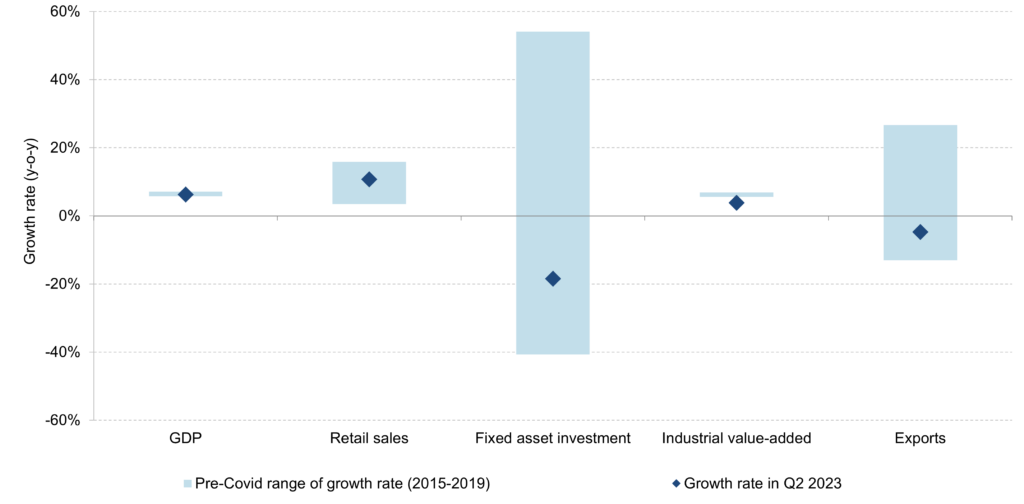
Note: The growth rate of industrial value-added is the y-o-y growth rate of the YTD data. The growth rates of other indicators are the y-o-y growth rates of quarterly data. The historical ranges of the indicators are based on historical y-o-y growth rates in the 20 quarters in 2015-2019.
Sources: The National Bureau of Statistics of China (GDP growth, retail sales volume, fixed asset investment growth, and industrial value-add growth), as of Q2 2023; General Administration of Customs (export growth), as of Q2 2023; LaSalle Investment Management (retail sales growth), as of Q2 2023.
Q: How concerning is the outlook for China’s housing market?
A: The for-sale residential sector is stabilizing in the largest cities.
Despite short-term volatility in sales volume and prices, China’s for-sale residential sector is experiencing a slowing decline in sales volumes and prices compared to the second half of 2022. In Tier 1 cities, however, both sales volume and prices are already improving [LMQ page 24]. In the next 6-12 months, the overall for-sale residential market could reach bottom, supported by government policies, a decline in supply and a reduction in mortgage rates and down payments. We expect the subsequent recovery to be gradual. For-sale residential prices may improve, though sales volumes are unlikely to recover to their prior peak. We expect housing markets in Tier 1 and top Tier 2 cities to lead the recovery of low-tier cities.
Q: What about the troubled developers?
A: Highly leveraged developers are likely to have only a marginal impact on the Chinese financial system.
Despite our expectation of an eventual recovery in China’s for-sale residential sector, the outlook for over-leveraged developers with large exposures to low-tier cities, including Evergrande and Country Garden, remains gloomy. The resolution of these developers’ onshore and offshore corporate debt is expected to take time, which will continue to draw media attention. However, the impact of the default or bankruptcy of these troubled residential developers on the Chinese financial system has been limited so far, and we expect it to remain so, given the exposure of Chinese commercial banks to real estate construction loans only accounted for ~4% of their total assets as of the second quarter of 2023.1 Even for the more vulnerable trust companies, the exposure to real estate declined from ~13% of their total assets in the second quarter of 2019 to ~5% in the second quarter of 2023.2
Q: What is the story with rising youth unemployment?
A: The high youth unemployment rate is misleading.
The unemployment rate of the labor force aged 16-24 in China is rising. However, the direct impacts of this on retail sales and the broader economy are likely to be limited. Those aged 16-24 accounted for only around ten percent of the Chinese population as of 2021.3 In addition, many of those aged 16-24 are still in school, given that young people in China finish education at around age 20, on average.4 There could be some indirect impacts of high youth unemployment on household confidence, although we do not expect them to be significant given that the unemployment rate for the key labor force in China (aged 25-59) is at its lowest level since 2018 [LMQ page 25].
Q: Is China at risk of deflation?
A: It is premature to make the call that China is entering a deflationary period.
It is true that China’s headline inflation rates have been fluctuating around 0% in recent months, primarily driven by food and energy prices coming off peak levels post lockdowns. However, the core inflation rate (excluding food and energy) remains in positive territory [LMQ page 16]. As the Chinese economy gradually recovers and the post-lockdown effects fade, we expect inflation to gradually escalate.
Looking ahead
- Western commentators have generally been disappointed at China’s lack of bazooka stimulus to reinvigorate the economy. The Chinese government’s approach has been to instead focus on smaller stimulus measures or targeted policy shifts. We believe that even if all these supportive actions fail, China still has many options it can implement to boost the economy. In our view, there is a high probability that the Chinese economy could reach its 5% GDP growth target by the end of the year.
- China’s mild economic recovery and slowly improving business and household confidence suggest the demand recovery for income-producing real estate in China could be modest in the near term. Net absorption of major sectors including office, logistics, retail and rented multifamily in the next 12-18 months is likely to be below the levels seen in 2021.
- Troubled for-sale residential developers may continue to offload assets to repair their balance sheets. Over the past decade, Chinese developers have built large portfolios of commercial real estate, mainly composed of offices, retail malls, and hotels. A small number of these developers also own assets in our favored sectors, such as multifamily rental and logistics. Distressed sales at attractive prices could continue to surface in the next 6-12 months.
The path of Japanese monetary policy
The Bank of Japan (BoJ) remains an outlier among global central banks, as it continues to maintain ultra-accommodative policy in the form of yield curve control (YCC). The BoJ introduced YCC in 2016, with the intent to keep 10-year government bond yields low to stimulate consumer spending and business investment. Over the past year, speculation has mounted as to whether this policy would be sustained, with volatility being triggered around moments of policy adjustments or speculation that YCC would be abandoned.
Most recently, on September 22, the BoJ kept the YCC policy unchanged with a unanimous vote. The 3-month rates used a reference for borrowing costs have been bouncing around -0.2 to -0.1%, while the 10-year Japanese government bond (JGB) yields have increased to 0.73% since the BoJ’s surprise tweak to the YCC in December last year [LMQ page 7].5 Inflation in Japan has been running above the BoJ’s two percent target over the past 17 months,6 which in theory could be a catalyst for the BoJ to make more tweaks to its YCC policy or even exit it in the near term. But the answers to complex questions about the trajectory of rates in Japan aren’t so simple; policy actions and capital market reactions are inherently difficult to predict, but are likely to be less dramatic than feared.
Q: Isn’t the BoJ under pressure to change policy to tackle above-target inflation?
A: The two percent inflation target is likely to be achieved in the short term, but the BoJ is focusing on whether the target can be achieved sustainably.
The latest BoJ inflation projections and Tankan survey results7 suggest that inflation could remain above the BoJ’s 2% target at least over the next 12 months [LMQ page 19]. Wages in Japan, a key component of inflation, grew by 2.3% y-o-y in July 2023 due to a tight labor market.8 Employment conditions are expected to tighten further in the near term,9 potentially reaching levels last seen in 1990s. The 2024 Shunto (spring) wage negotiation is the next key event to monitor. Hence, it is as yet uncertain whether wage growth in Japan could remain consistently above its 2% target.
Inflation and core inflation in Japan
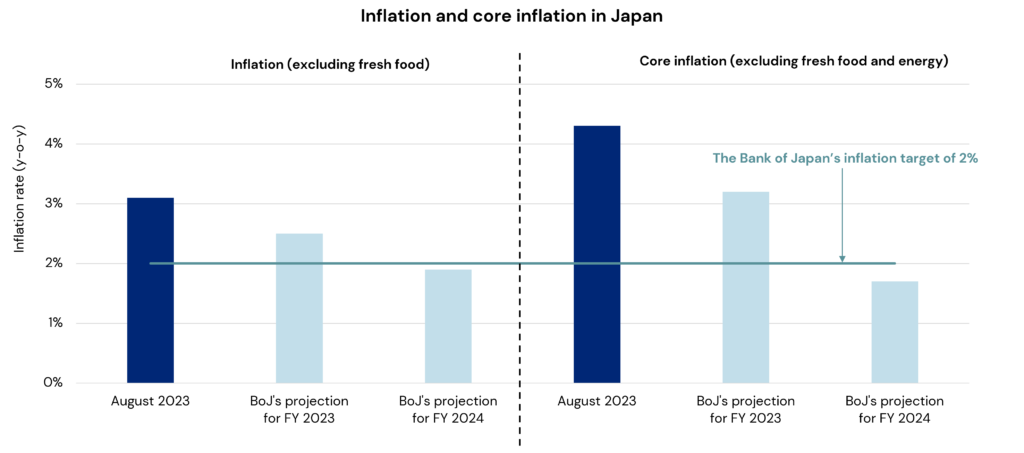
Source: The Japan Statistics Bureau (historical inflation data), as of August 2023. The Bank of Japan (inflation projection for fiscal year 2023 and 2024), as of July 2023.
Inflationary pressures do not exist in a national vacuum. Thankfully, inflation is now declining in other developed markets [LMQ page 12], potentially giving the BoJ more time to evaluate the prospects for inflation in Japan. Many central banks, following the lead of the US Federal Reserve, are seen to be at or near the end of their tightening cycles as inflationary pressure tapers. That said, global central banks are highly unlikely to cut interest rates sharply any time soon, unless economies fall into deep recession. Therefore, we expect the interest rate differential between Japan and the US to remain wide but may narrow somewhat in the near term. Moderation in the interest rate differential could help the weak yen to regain some ground, which might also alleviate some pressure on the BoJ.
Q: How do you read the political tea leaves around BoJ’s policy?
A: Policymakers will tread carefully as they do not want to upset the labor market and the financial system.
Inflation in Japan has been outpacing wage growth, putting pressure on Prime Minister Fumio Kishida’s approval ratings, according to a poll conducted by the Asahi Shimbun newspaper on September 18. There is a strong political impetus for Kishida and the new cabinet to ensure wage growth consistently exceeds the inflation rate. Moreover, as more than 70% of the mortgage loans in Japan have floating rates,10 there is a strong incentive for the BoJ to keep short-term interest rates relatively low. BoJ measures that could derail Japan’s economic recovery or disrupt the capital markets could be considered politically risky and thus less likely.
Looking ahead
- Forward markets indicate that 3-month interest rates are expected to enter positive territory but remain below 0.2% over the next two years, which implies that borrowing costs in Japan would remain much lower than those of other developed economies. Leveraged real estate yields in Japan remain higher than unlevered yields, in contrast to many other markets where real estate debt is now priced at levels that lead to “negative leverage” at today’s pricing. Japanese real estate debt costs could remain relatively low if the forward markets’ prediction is accurate.
- Yields on 10-year JGBs have increased sharply by Japan’s historical standards since the BoJ loosened the YCC in December 2022. The forward markets imply that 10-year JGB yields could increase to close to 1.1% by September 2025, near the level last seen in the second half of 2011. Such an increase would be modest by global comparison but could be viewed as a step closer to interest rate normalization. Given “the math” of rate rises when the starting point is low in absolute terms, even a modest increase in 10-year JGB yields could have some impact on Japanese real estate valuations, a risk that investors should anticipate and plan for accordingly.
- Nonetheless, there are still wide gaps between JGB yields, current yields on other asset classes and real estate yields. This makes income-producing Japanese real estate investments attractive, especially for domestic investors, who dominate the market. With a uniquely wide positive spread between borrowing costs and cap rates, we expect Japan to continue to remain the most liquid institutional real estate market in Asia-Pacific for the foreseeable future, albeit with some volatility at times.
Footnotes
1 Source: The People’s Bank of China (total amount of outstanding real estate construction loans), as of Q2 2023; State Administration of Financial Supervision and Administration of China (total assets of commercial banks), as of Q2 2023
2 Source: The China Trustee Association, as of Q2 2023
3 Source: The National Bureau of Statistics of China, as of 2021
4 Source: LaSalle Investment Management, as of 2021. The estimation is based on the average years of education among the young labor force in China published by the Ministry of Education of China in 2021.
5 Source: Bloomberg, as of September 25, 2023
6 Source: The Japan Statistics Bureau, as of August 2023
7 Source: The Bank of Japan’s Tankan survey on the inflation expectation and the output price expectation among corporates of all industries, as of June 2023
8 Source: The Japan Statistics Bureau, as of August 2023
9 The Bank of Japan’s Tankan survey: all-industry employment conditions, as of June 2023
10 Source: The Japan Housing Finance Agency, covering home loans between October 2022 and March 2023.
Important Notice and Disclaimer
This publication does not constitute an offer to sell, or the solicitation of an offer to buy, any securities or any interests in any investment products advised by, or the advisory services of, LaSalle Investment Management (together with its global investment advisory affiliates, “LaSalle”). This publication has been prepared without regard to the specific investment objectives, financial situation or particular needs of recipients and under no circumstances is this publication on its own intended to be, or serve as, investment advice. The discussions set forth in this publication are intended for informational purposes only, do not constitute investment advice and are subject to correction, completion and amendment without notice. Further, nothing herein constitutes legal or tax advice. Prior to making any investment, an investor should consult with its own investment, accounting, legal and tax advisers to independently evaluate the risks, consequences and suitability of that investment.
LaSalle has taken reasonable care to ensure that the information contained in this publication is accurate and has been obtained from reliable sources. Any opinions, forecasts, projections or other statements that are made in this publication are forward-looking statements. Although LaSalle believes that the expectations reflected in such forward-looking statements are reasonable, they do involve a number of assumptions, risks and uncertainties. Accordingly, LaSalle does not make any express or implied representation or warranty, and no responsibility is accepted with respect to the adequacy, accuracy, completeness or reasonableness of the facts, opinions, estimates, forecasts, or other information set out in this publication or any further information, written or oral notice, or other document at any time supplied in connection with this publication. LaSalle does not undertake and is under no obligation to update or keep current the information or content contained in this publication for future events. LaSalle does not accept any liability in negligence or otherwise for any loss or damage suffered by any party resulting from reliance on this publication and nothing contained herein shall be relied upon as a promise or guarantee regarding any future events or performance.
By accepting receipt of this publication, the recipient agrees not to distribute, offer or sell this publication or copies of it and agrees not to make use of the publication other than for its own general information purposes.
Copyright © LaSalle Investment Management 2023. All rights reserved. No part of this document may be reproduced by any means, whether graphically, electronically, mechanically or otherwise howsoever, including without limitation photocopying and recording on magnetic tape, or included in any information store and/or retrieval system without prior written permission of LaSalle Investment Management.
The transition to a lower-carbon built environment is reshaping the definition of quality real estate. We can point to numerous anecdotal examples of green building features driving higher rents and values, as well as better overall performance. However, showing this rigorously and quantitively is challenging.
Various academics, real estate agencies and other researchers have attempted to measure the difference between assets that possess and those that lack green features. They use a range of datasets that vary widely and have enjoyed varying degrees of success in drawing clear, convincing findings from their analysis.
So is there a green premium? Or a brown discount?
Price, value and performance differentials between assets that possess and those that lack certain sustainable credentials are often called one of the other. In our view, the difference between the green premiums and brown discounts is a matter of perspective and can vary with time, as given attributes transition from novel, to highly valued, to standard.
For simplicity’s sake, we think of them as a single concept that we call “the value of green.”
Our approach for this report is to examine the existing work on the topic and identify the most helpful and relevant analyses. This sits alongside our monitoring of outcomes within our own portfolio, a few examples of which we highlight as case studies.
We find that while the range of estimates are wide, and depend on a variety of methodological considerations, the studies consistently find a statistically significant financial impact of asset sustainability features on metrics such as achieved rent, capital value, leasing success and overall performance. We will continue to monitor the evolving evidence of these differentials, both in the broader literature and within our portfolios.
So does “green” actually have value?
Through history, residential rent controls have tended to appear at times of external shock and dislocation.1 COVID-19 and the subsequent inflationary spike have proven to be such a catalyst. Changes to rent regulations can potentially reshape the risk-reward profile of residential investments, impacting values over both short and long timescales. As we set out in a previous piece, A New Wave of Residential Rent Control, the introduction of rent control measures can also have unintended consequences that distort the market. While often sold as a solution to spiralling housing costs, in practice they can have the opposite effect to their intent, deterring the construction of new rental housing, thus leading to further increases in rents.
Our findings in that report still hold true, but an update is needed because the “great reflation” period has seen a groundswell of support for further rent regulations, especially in Europe. The pandemic opened the door to unprecedented government intervention, and there has been a heightened willingness among politicians to introduce forms of rent control. But there continues to be vast differences across countries, regions and cities, reflecting varying political appetites for intervention. What is the impact of these recently enacted measures and which markets have been most impacted?
Rent regulation starting positions vary widely
Regulations take many different guises including broad brush limits on initial rent levels (e.g., in France, Ireland), market-wide caps to annual rental increases (Germany, Sweden) or caps limited to buildings of a certain age or in certain areas deemed to be stretched (Denmark, Catalonia, New York City, California). Beyond rent-setting, lease length, security of tenancy and eviction protections are additional factors to consider. Crucially, regulation should be viewed on a spectrum rather than as a binary determination.
In “unregulated” rental markets, such as England, most of the US and select European countries (e.g., Finland, Poland and Czechia), rents can typically be freely set at the outset of a tenancy, with the landlord permitted to increase them at the end of the agreement (typically 12 months) by any amount. This allows landlords in these markets to mark rents to market levels quickly. Even in markets that are usually considered to be unregulated, other legal limitations should also be considered; for example, the UK parliament is currently considering a law which would end no-fault evictions in England and Wales.
Elsewhere in Europe, in parts of Canada, and in several US states like California, Oregon and New York, the most typical form of rent control is limiting annual rent escalations for existing tenants. The devil is in the detail of these specific regulations. California, Oregon and New York City’s regulations, for example, apply to a subset of older assets; in Toronto (and all of Ontario) they apply to all but the newest. In the case of Oregon, a limit of 7% increase plus CPI is not much of a limitation on investment economics,2 while in New York City, rent increases are set by a regulatory body and can have a significant impact.
Europe’s generally more constraining rent increase caps mean that in-place rents are normally significantly below open-market rents for new leases. Limiting annual rent increases for in-place tenants prevents rents from being marked to market, usually resulting in tenants being “stickier”, staying in their homes in the knowledge that the rents they are paying are below what they would pay under a new lease. This has the effect of higher occupancy levels and lower expenses on unit turnover and voids. Catch-up between in-place and market rents occurs gradually, even during periods of weakness in market rents.
As a result of these factors, heavily regulated markets tend to experience stable in-place cash flow growth, without the cyclicality of less restrictive markets. This is highlighted on the below chart, which shows that residential rental growth in the UK has been far more volatile than regulated European markets. Given steady, non-cyclical growth, regulated residential in Europe has been able to deliver a higher level of long-run growth than most of the commercial sectors. These attributes of stability and low-but-dependable growth can be appealing to core investors, especially in lower inflation environments.
Rental growth and volatility
[Average per annum since 2000* and standard deviation]
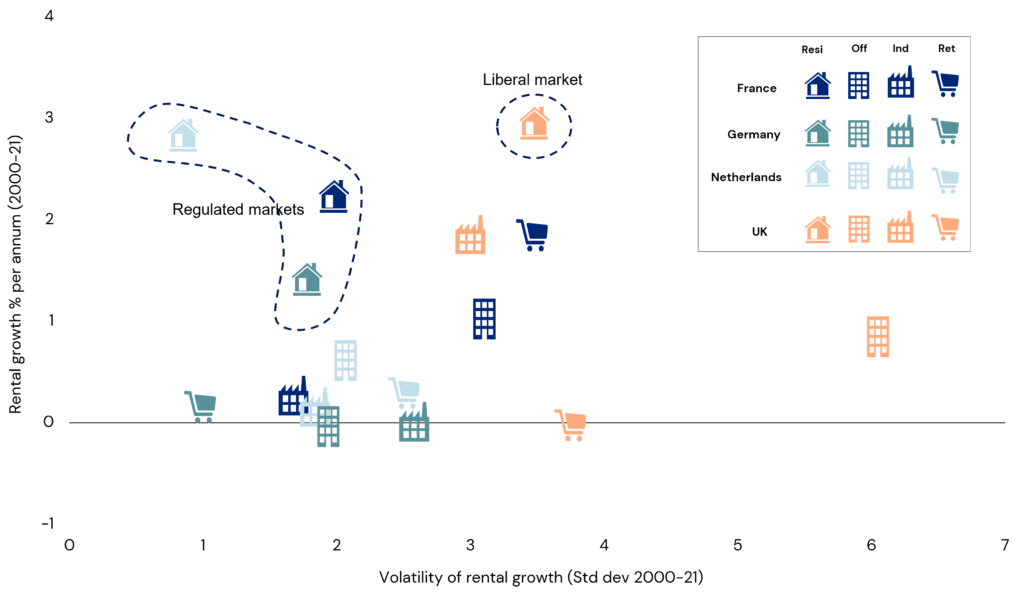
Source: LaSalle (May 2023), MSCI (December 2021)
Variety of cash flows can be a positive – but beware regulatory surprises
If regulations are known and stable, they can be priced in, limiting the risks to informed investors. A bigger concern comes from new, unforeseen regulations during the ownership of an asset. So-called “stroke-of-the-pen” risks may cause underwritten rent levels and growth to suddenly change. This remains a persistent threat as long as some policymakers are willing to support new rent controls. The factors which have made residential such a compelling sector in recent years, namely the undersupply of housing and tailwinds supporting demand, have exacerbated the threat, as rents in many major markets have increased as a share of average household income. The bout of high inflation seen in 2022-23 has put even more pressure on household finances and motivated politicians to act. The result has been new regulations brought in across Europe and North America, although some are some supposedly temporary.
Another wave of new regulation—Europe
Since beginning of 2022, several European markets have introduced new rental regulations, including in Scotland, France, Spain, Denmark and the Netherlands (see map). In other markets, such as Germany, new regulations are now being discussed.
The impact of these is just beginning to play out, but they are having meaningful effects already, with significant variation by market and asset profile. During this period of high inflation, these caps have created a double hit for some residential owners, limiting rental growth at the same time as operating expenses rose quickly.
Rental regulations introduced over 2022-2023
[Lighter colored markets considered unregulated]
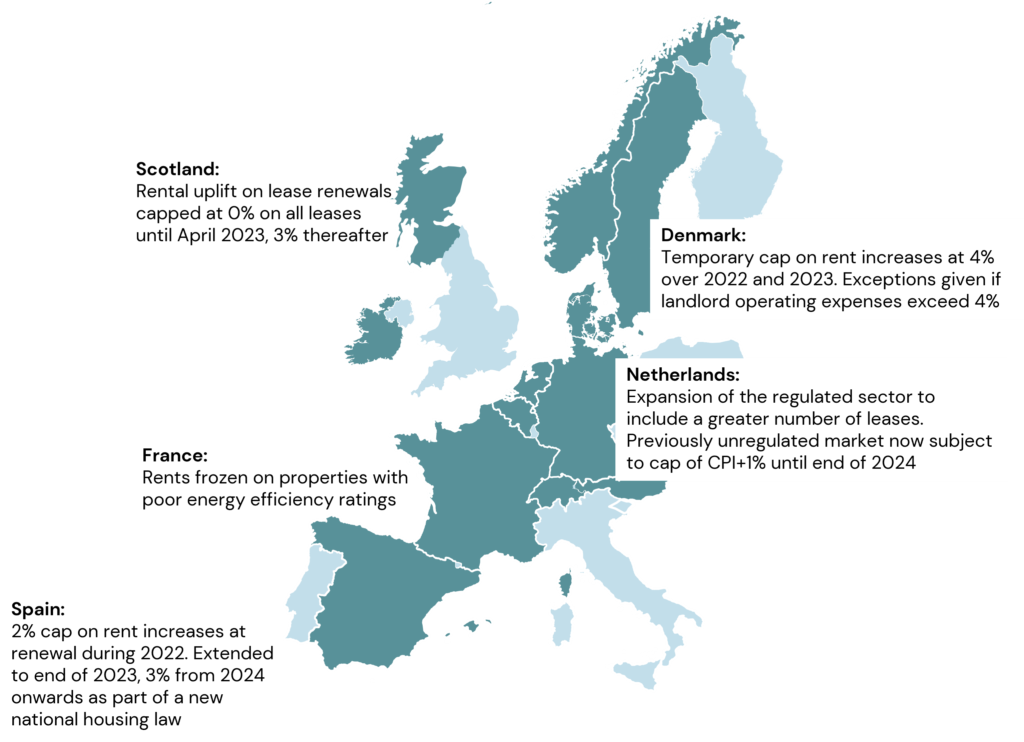
Source: LaSalle (May 2023)
In some markets, recent regulatory changes are less disruptive. For example, the cap to indexation at 4% in Denmark may result in below-inflation rental growth for one or two years. Should inflation revert to historic levels as anticipated, this is unlikely to meaningfully damage performance on assets held over the long term, but potentially mean negative real cashflow growth for landlords in the near term. This is because inflation exceeded the cap in 2022 and will expect it will likely do so again in 2023. Residential assets in regulated markets have only been able to deliver inflationary in-place rent growth when inflation is at “normal” levels. This is because regulators in Denmark and elsewhere have tended to prevent double-digit nominal increases even when justified by inflation.
The Scottish government’s decision to ban rent increases completely in September 2022 was potentially more disruptive. Some developers and investors indicated that construction of badly needed new for-rent supply was not viable in such an environment. Being unable to underwrite rental growth would likely discourage private investment in Scotland’s housing market, exacerbating the housing shortages which necessitated the rent controls in the first place. The Scottish government backtracked in April 2023, replacing the freeze with a still tight 3% cap.
Once regulations are introduced they are often very difficult to unwind, as few politicians will publicly campaign to reverse policies which will result in their voters paying more in rent. Evidence of this can already be seen in Spain, which introduced supposedly temporary caps to rent increases that have been extended beyond their original end dates and has further tightened regulations with the introduction of a wide-ranging national housing law.
Less constraining changes in the US
In parts of the US, rent control gained traction in the late 2010s, reversing a two-decade trend toward less regulation. But most cases, new measures have been relatively mild. In 2019, Oregon and California enacted statewide caps on annual rent increases for existing tenants, but limited the restrictions to older properties and set the level of the caps high.3 A notable example of a more severe new rent ordinance comes from St. Paul, Minnesota. Voters there approved an ordinance in 2021 that limited rental increases to 3% across all buildings and for renewals and new leases alike. Developers responded by halting construction projects in the city, with residential permits falling by 30%. Less than a year later, the St. Paul city council revised the ordinance to more closely resemble the legislation in California and Oregon.4
Despite the advances of rent control legislation in a small number of states and cities in recent years, many more jurisdictions have rejected it. In 2022 alone, new rent regulations were introduced by state legislators in 19 states and did not receive enough support to pass. Most recently, in April 2023, Florida passed an outright ban on rent control in that state while at the same time allocating new funding for the development of affordable housing.
Living with increased regulation
Despite the risks of regulatory change, regulated residential assets can potentially offer investors a favourable return given low risks, particularly when compared to the more challenged office sector. That said, the devil is in the details, given widely varying regulatory frameworks across cities, states and countries. With changes to policies underway, managing the risks of greater regulation is now more important than ever for investors. To do so, we recommend an approach that encompasses vigilance, diversification and identification of less-regulated proxies for residential—we detail each of these strategies below.
Looking ahead
- Be vigilant of shifting regulations impacting both current and potential investments. Assessing the likelihood and timing of new legislation is an extremely difficult task but is a prerequisite when screening any potential acquisition in the sector.
- Diversify exposures across markets with differing regulatory regimes, limiting the impact of a single change in legislation to a portfolio.
- Require higher returns to compensate for future regulatory risk. The lack of certainty on regulations necessitates that investors to add an extra level of uncertainty to their future cashflows, potentially requiring additional risk premia at both acquisition and exit.
- Consider whether other Living sub-sectors may be less likely to be brought under the scope of rent controls. For example, in European purpose-built student accommodation (PBSA) operates with very limited restrictions on rents, even in the most tightly controlled markets. Because European universities tend to be clustered in major cities, PBSA offers investors some of the same compelling attributes as traditional residential—a chronic supply-demand imbalance, short leases allowing for rapid capturing of rental growth and further maturity as an asset class to come—but with lower regulatory risk. Similarly, shorter-stay co-living and serviced apartment stock may fall outside the regulation of traditional apartments.
- The earliest record of rent control dates to the Roman Empire. Notable shocks that were a catalyst for new rent regulation included the Chinese Song dynasty’s relocation to its new capital city in 1127 and the period immediately following the Great Lisbon Earthquake of 1755. See Kholodilin’s fascinating review of historic rent control at this link.
- On the other hand, changes in eviction protections in Oregon have been significant; this is a reminder to consider non-rent aspects of regulation.
- California’s law caps annual rent increases at the lower of CPI+5% or 10% while Oregon allows for 7% plus the rate of inflation.
- The revised St. Paul ordinance exempts buildings less than 20 years old and allowing for increases of CPI plus 8% for new leases.
Want to read more?
The state of the market year-to-date: Capital markets digest repricing, as tenant demand stays resilient and energy markets deliver a positive surprise.
Our latest LaSalle European Market View shows how Europe’s economies and real estate markets are being impacted by, and adapting to, the current period of unusual uncertainty.
This update highlights recently released data on how Europe’s energy market has coped with shutoffs and surging prices in the winter following Russia’s invasion of Ukraine. It did so through a combination of reduced consumption (p. 6), more electricity generation from renewables (p. 7), and shifting to imports from new sources (p. 8). In Q1, the EU’s natural gas consumption was tracking 18% below average. This owes some thanks to mild winter temperatures, but also to conscious conservation efforts.
Natural gas consumption in Europe (EU27)
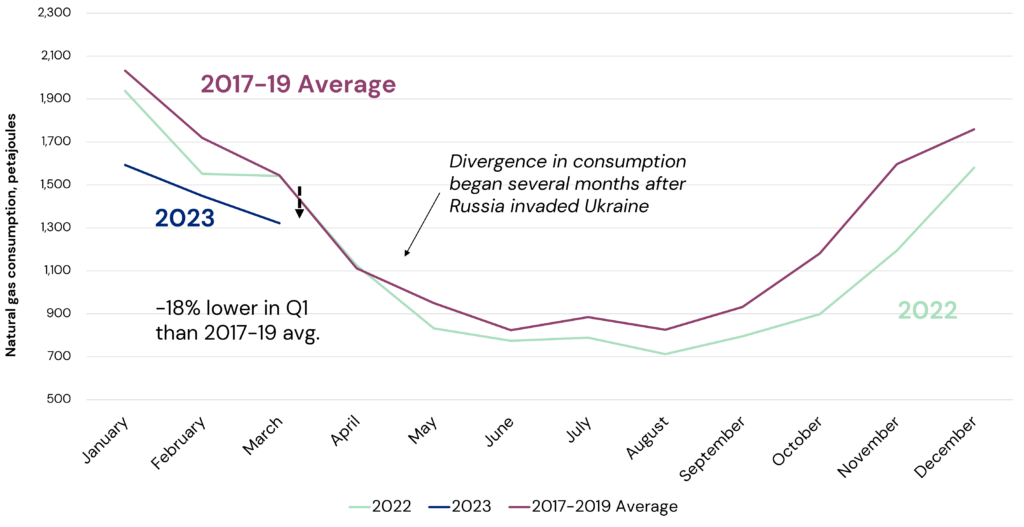
Source: LaSalle analysis of Eurostat data to March 2023. Note that the UK is excluded from all time series data above.
Falling energy prices have led to recent steep headline inflation declines (p. 11) and kept Europe’s largest economies from entering recession to date (p. 9). Yet core inflation – excluding volatile food and energy – is higher today than in 2022 – and GDP growth is at stall speed. European banks have weathered the aftershocks of SVB’s failure and the Swiss National Bank’s forced resolution of Credit Suisse. However, some pullback in bank risk appetite is evident in debt markets (see p. 29 and our April ISA Briefing).
Even as the ECB and Bank of England’s rate hikes have continued, long-term swap rates today are similar to where they started the year (p. 28). This has given private real estate and yields some time to digest the new repricing math. The UK’s repricing stands out for its speed, with monthly UK index data swinging to a positive return in March after eight months of deep negative returns (p. 34).
European real estate transaction volume declined to an 11-year low in Q1. This is a lagging rather than concurrent indicator, however, and reflects the high uncertainty and bid-ask spreads that existed near the end of 2022. At the same time, the most recent Q1 data on occupier trends shows hardy demand fundamentals, albeit with some cooling. In Q1, prime logistics rents continued to grow at a double-digit annualized pace and UK residential sector kept pace with high inflation across many markets, even as office rents cooled and retail rents were flat. As we look ahead, we believe the relationship between current vacancy and its historic levels (p. 18, 20, 21) points to the European property types and markets where rent momentum is most likely to continue.
Quarter-over-quarter rental growth in Europe
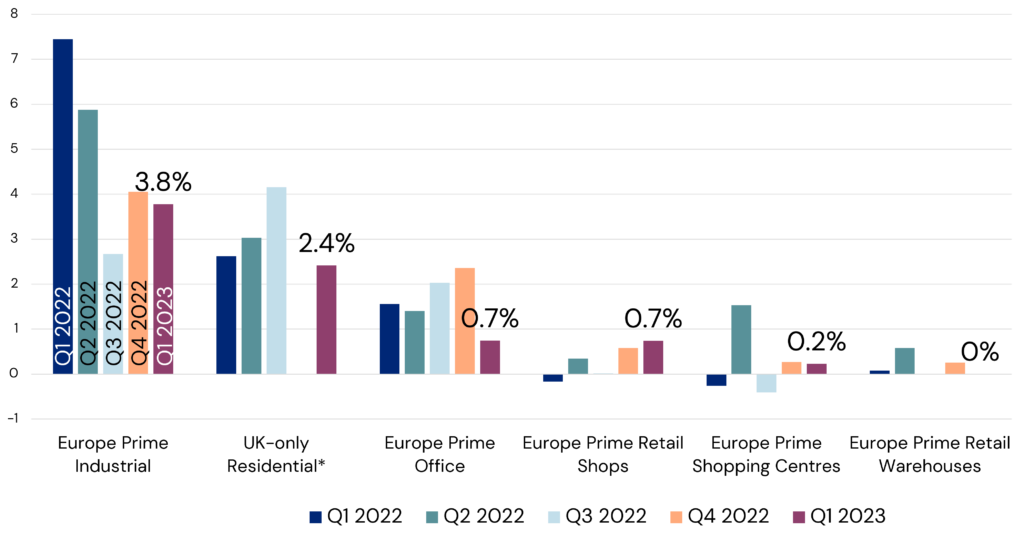
*Average rent and Q1 2023 residential data currently unavailable. UK residential rent data is based on new listings (rather than in-place rents).
Source: JLL, HomeLet data to Q1 2023. Latest as of May 2023.
Want to read more?
US private real estate returns went negative in Q4 2022 as the impact of higher interest rates continued to ripple through to market pricing and appraised values. This trend is expected to continue through the first half of 2023 with stability projected to return later in the year.
Returns in the fourth quarter showed negative appreciation and income returns in line with previous quarters, resulting in negative total returns for both the NPI and ODCE. The slowdown in returns was most significant for industrial, with retail delivering the highest returns of the major sectors (this is a notable shift from trends of the last 5+ years). Looking ahead, the dominant theme in sector performance is expected to be the under-performance of offices.
This note provides details on the fourth quarter performance of the NPI and ODCE indices, summarizes the outlook for future returns, and provides some information regarding insights from the first release of data related to the new NCREIF subtypes.
Highlights from the Q4 data releases include:
- The quarterly total NPI return declined 410 bps from Q3 to -3.5%. The Q4 return comprised a 0.95% income return and -4.45% appreciation return.
- The trailing-year return declined more than 1,000 bps quarter-over-quarter to 5.53%.
- Returns for all property types were down from the previous quarter and in negative territory, with industrial seeing the greatest decline for the second consecutive quarter. Retail was the highest-returning property type for the first time since Q1 2016.
- The ODCE value-weighted quarterly gross total return of -4.97% was down 440 bps from the third quarter. Appreciation remained negative at an index level and the income return was flat at 0.80%, an all-time low. Mark to market on leverage was a positive as interest rates rose, but negative appreciation caused leverage to be an overall negative to returns.
Want to read more?
The balance of virtual and in-person interaction is close to a post-pandemic steady state. So we observed in our ISA Outlook 2023, where we called this out as one of our key global themes for the year. We pointed out that after a long period of gradual improvement in office attendance, the rate of change has substantially leveled off, with weekly office visits stabilizing below 50% in many US markets, and at somewhat higher levels in Europe and substantially higher levels in much of Asia-Pacific.
In many markets, but especially North America, work-from-home (WFH) headwinds have hit leasing demand as leases roll. An anticipated boost from permanent social distancing failed to materialize. At the same time, the cyclical outlook for job growth has weakened with the macroeconomy. These factors have contributed to deepening worries about the prospects for office values, which have made front-page news due to prominent defaults on commercial mortgages backed by office assets.
In this context, we thought it important to revisit the prospects for the office sector, addressing key questions, while highlighting differences and similarities among global markets. Where are risks greatest and where are they less? How should we think about the role of office in the portfolio? How will current trends play out in the various regions where we invest?
This is also an opportunity to look back on our predictions to assess where we got things right, and where we did not. As a part of this, we introduce a new feature in our ISA suite, “Looking Back”, in which we check on our prior predictions and forecasts.
Want to continue reading?
Value investing in European real estate today is characterised by an abundance of unmeasurable uncertainty over quantifiable risk. Successfully navigating that uncertainty requires the intersection of expertise and experience.
Beyond the current turmoil however, we believe four themes will define the Europe of the near future – Europeans will be smarter, greener, older and more mobile.
Periods of dislocation, while testing for investors’ convictions, can also offer opportunity. Uncertainty can result in attractive entry pricing as markets become over-correlated. As a result, fund vintages raised during challenging markets, which are able to take advantage of this repricing, have outperformed in recent cycles.
Where short-term dislocation overlaps with our long-term convictions, we believe lasting value can be created.
Want to continue reading?
What it means for Chinese and global property markets
After nearly three years of enforcing a comprehensive approach to COVID-19, involving frequent testing, rigorous contact tracing and strict border quarantines, China unexpectedly ended its zero-COVID policy in early December 2022.
After an initial period of surging new infections, by mid-January 2023 the situation had improved substantially. Most recently, cases have fallen sharply as the virus has already infected a large share of the population. Life in China is quickly returning to normal, as evidenced by rebounding subway passenger volume and rising road congestion.1 This return to pre-pandemic normality has meaningful implications for the economic and real estate outlook in China, the broader Asia-Pacific region and the world.
Road congestion and subway passenger volume in Tier I cities in China
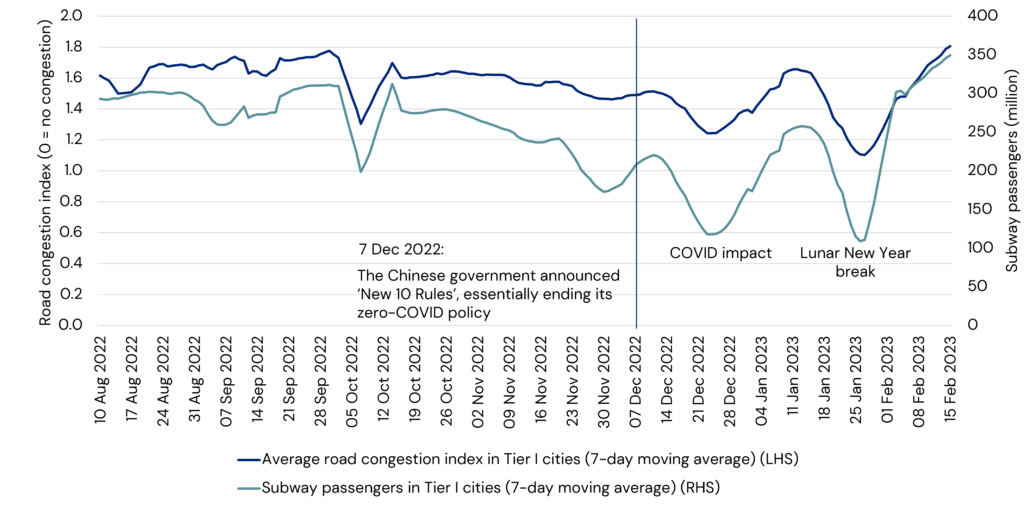
1 Source: Amap.com via WIND Economic Database (road congestion index), WIND Economic Database (subway passenger volume), as of 15 Feb 2023)
China: Unambiguously positive for growth
China’s reopening provides a clear boost to the Chinese economy, and high-frequency indicators suggest it may have already started to recover. The official manufacturing PMI and non-manufacturing PMI both returned in January 2023 to above 50, the dividing line between expansion and contraction, after hitting the lowest levels since March 2020 in December 2022.2
Meanwhile, among the 70 cities tracked, 36 experienced increases in for-sale residential prices on a quarterly basis in January 2023, compared with only 15 cities in December 2022.3
Unlike China’s V-shaped recovery from the initial COVID-19 outbreak in 2021, the rebound this time is likely to be gradual and mild. There are two factors supporting that expectation. First, despite the reopening and a shift in government policy towards promoting growth, it could take some time to repair the balance sheets of Chinese businesses and households, which are fragile after nearly three years under the zero-COVID regime. Second, the country’s for-sale residential sector, historically a main driver for the economy, remains weak despite signs of bottoming.
2 National Bureau of Statistics of China (NBS)
3 National Bureau of Statistics of China (NBS)
Asia-Pacific: Outbound travel likely to be key
Looking to the broader Asia-Pacific region, China’s reopening is an encouraging development for the hospitality industry. Since March 2022, hotel revenue per available room (RevPAR) had been gradually improving in countries which were advanced in their post-COVID reopening, particularly Australia and Singapore.4
However, Chinese visitors historically have been a significant source of hotel demand and visitor spending in major Asia-Pacific markets, and they were almost completely absent in 2022. As such, hotel performance in most tourism destinations of the region is still trailing the pre-pandemic level. As China unleashes pent-up demand for travel, a recovery in Asia-Pacific hotel and tourism-oriented retail sectors is likely.
4 The Singapore Tourism Board, The Hong Kong Tourism Board, as of Dec 2022
International visitor arrivals and the proportion from China5
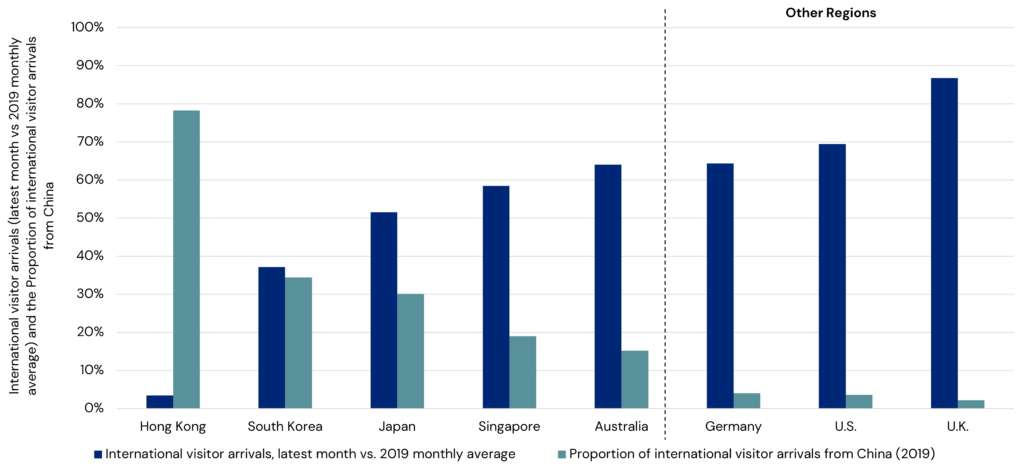
5 The latest data on international visitor arrivals to (1) the U.K. are as of September 2022, (2) Australia, Germany, and the U.S. are as of November 2022, and (3) Hong Kong, Japan, Singapore, and South Korea are as of December 2022. The data on the proportion of international visitor arrivals from China for all countries are as of 2019 except Germany which is as of 2018. Source: Statista and CEIC (Germany), as of 2018; the U.K. Office for National Statistics (the U.K.), as of September 2022; the Australian Bureau of Statistics, the U.S. Department of Commerce, as of November 2022; the Hong Kong Tourism Board, the Japan National Tourism Organization; the Singapore Tourism Board; the Korea Tourism Organization, as of December 2022.
Global: Incrementally inflationary or boost to supply chains?
The impact of China’s reopening on the global economy will depend on the interplay of two opposing factors. On the one hand, higher demand from stronger growth in the world’s second-largest economy could potentially increase global inflation, or at least keep it high for some time.
On the other hand, the smoother operation of global supply chains from a fully reopened China is potentially a counterbalancing disinflationary trend. Indeed, an end to the start-stop impact of lockdowns on production and transportation should reduce the risk of further supply chain shortages.
Our expectation of only a gradual recovery in the domestic economy means that the hit to global inflation may not be significant. Weaknesses in the Chinese housing market is likely to prevent too much upward pressure on global construction costs from materializing, even though China is the world’s largest steel exporter. But any boost to inflation, just as it is starting to come down in much of the world, would be unwelcome and could mean that global central banks might not be able to stop raising interest rates as soon as otherwise.
Looking ahead
- The reopening is expected to boost occupier and investor demand for commercial real estate in China. Improving real estate fundamentals and domestic investor sentiment, along with low domestic interest rates and the rapid growth of the domestic public REIT market, points to increasing capital market liquidity among domestic investors for Chinese commercial real estate assets in the near term. The logistics and multifamily rental sectors are expected to benefit from this trend the most due to their relatively sound fundamentals, their qualification for domestic public REIT structures and other supportive government policy measures.6
- In the Chinese culture, the Year of the Rabbit signifies prosperity, peace and longevity. While the world is still facing many challenges including elevated inflation, higher interest rates, the risk of recession and the Russia-Ukraine war, the reopening in China in the Year of the Rabbit brings clear positives to the Chinese economy and its real estate markets, though the risk of a renewed rise in global inflation should be watched carefully.
6 Among the major commercial real estate sectors, currently only industrial and multifamily rental assets are qualified underlying assets for ownership by domestic public REITs.
Want to continue reading?
We property strategists are accustomed to working with traditional real estate variables such as net absorption, rental growth and vacancy rates. But in the early days of the COVID-19 pandemic, there was no choice but to go on a crash course in previously unfamiliar epidemiological concepts like positivity rates, R-naught¹ and vaccine effectiveness, as these suddenly became drivers of short-term real estate conditions. Over the past year, real estate researchers have likewise had to quickly scale a learning curve in understanding energy markets. For the first time ever, we produced charts denominated in once esoteric units of measurement like therms, MMBTUs and MWhs.²
Gas, electricity and oil prices have long been linked to real estate outcomes—energy crises sparked 1970s inflation and have shaped real estate demand from Alberta to Texas and Scotland. But when supply is predictable and prices moderate, as in the years before the pandemic, those links can become dormant. They have awoken again in the past year. The recent dramatic but uneven volatility in energy prices has deeply influenced the economic and property market outlook—especially in Europe—and we expect it to continue to do so going forward.
Europe’s cold, dark winter turns brighter
One year on from Russia’s invasion of Ukraine in February 2022, European energy markets have proven adaptable, facing down a unique degree of energy disruption owing to the region’s dependence on pipeline links from Russia. After initially skyrocketing—European natural gas price at their peak were twelve-times higher relative to the ten-year, pre-conflict average—by mid-February 2023 prices it had fallen to a level only around two and a half times that long-term average.³ Government schemes to partially socialize the cost of higher energy, at the expected expense of massive government deficits and higher borrowing costs, now look a lot less extreme.
¹ R0 is the basic reproduction number, which describes the expected number of cases of an infectious disease directly generated by a single case, in a population where all individuals are susceptible to infection.
² 1 therm = 100,000 British thermal units (BTUs), a measure used in UK natural gas pricing. 1 MMBTU = 1,000,000 BTUs, which is used in US gas pricing. 1 MWh = 1,000,000 watts of electricity over one hour, used in European pricing of natural gas.
³ Refinitiv, Natural Gas TTF (Title Transfer Facility) historical front month futures as of 13 February 2023
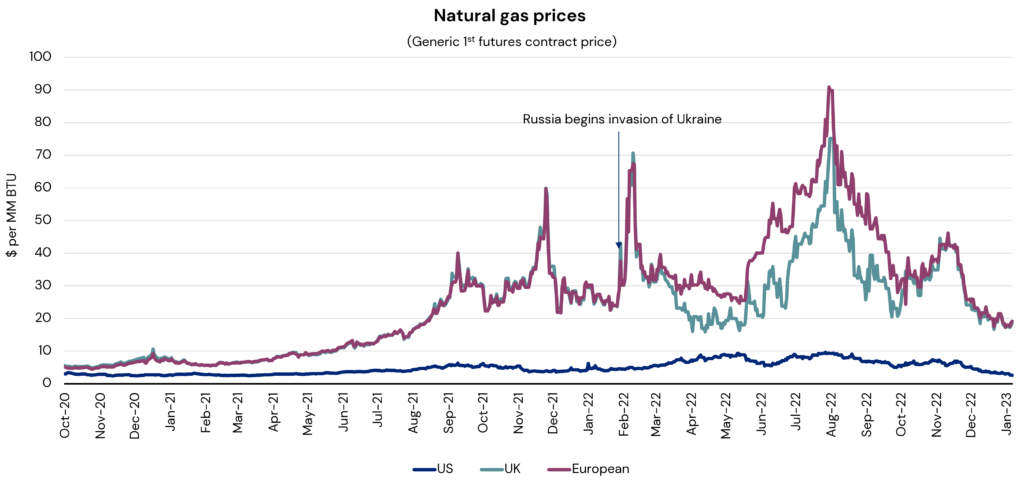
Source: New York Mercantile Exchange and Intercontinental Exchange data via Bloomberg. As of 1 February 2023⁴
Relatively warm weather, cutbacks in consumption and alternative sources of energy, such as renewables and the global liquified natural gas (LNG) market, have contributed to unusually full gas storage reserves. German wind, solar, biomass, hydro, and other renewables generated 47% of the country’s electricity in 2022, a five-percentage point rise in mix.⁵ This allowed European energy prices to fall and has caused headline inflation to ease substantially, even if European core inflation remains stubbornly high. This has brightened the region’s economic prospects as well; our call in the ISA Outlook 2023 (published in December 2022) that a European recession was “almost certainly underway” now appears premature.
Is Europe out of the woods? Far from it. The winter is not yet over, and a cold snap could quickly deplete gas storage reserves. Going into next winter, the Russian supply that was used to partly fill those tanks last autumn will likely be completely unavailable. Meanwhile, Chinese demand for LNG, which was down by 20% in 2022 owing to the country’s zero-COVID policy⁶, is likely to rebound as its economy reopens, leading to more competition for tanker deliveries. Europe’s energy reorientation will probably be at least a decade-long process, which will not be reduced in scope, scale or difficulty by one fortuitously warm winter—though new LNG import capacity and suppliers have accelerated the shift in the past year. We expect that energy prices will continue to have deep impacts on Europe’s economy and real estate markets.
⁴ TTF future prices have been used as a benchmark for European natural gas prices due to being the most liquid gas trading hub in Europe
⁵ German Environment Agency (UBA), press release from 12 December 2022
⁶ International Energy Agency (IEA), report from November 2022
Beyond Europe
While Europe’s historic reliance on Russian fossil fuels makes it uniquely exposed to energy risks, we see energy as a relevant, if variable, factor for global real estate. This is in part because energy markets operate at both global and regional scales. The Ukraine crisis caused an acute surge in European gas prices, but also a worldwide spike in the price of oil, which trades in a more globalized marketplace. It is worth noting that Canada and now the US are in aggregate net energy exporters, meaning increases in energy costs can be a net positive for economic growth in metro areas with concentrations of energy companies.
Energy and real estate
Going beyond the macro, the impact of energy costs on real estate varies greatly by building type. Data centers, cell towers, hotels, and cold storage are especially energy-hungry property types, and ones where operational business models mean landlords may be directly exposed to energy costs. Residential sectors vary widely, depending on the age and energy efficiency of the stock, the nature of building systems and leasing conventions. For example, the bulk of the older German residential inventory is heated by gas-fired boilers providing steam heat, and tenants pay “warm rents”—meaning the landlord is responsible paying for heat. Individually metered, modern multifamily product is more insulated—literally and figuratively—from energy prices.
Investments in commercial real estate sectors with net lease structures under which tenants pay energy bills directly, such as office and logistics, may appear shielded from energy volatility. But tenants in places where energy prices have surged have become painfully aware that these costs, historically a small portion of their total expense of occupancy, can suddenly become a significant burden. In our European portfolio, we have for the first time received requests from tenants to help lower their energy bills. Indeed, working with occupiers to improve efficiency and to generate on-site energy to reduce these bills has become an important way to retain them and maximize the affordability of the net rents they pay.
The limitations of electrical grids are also influencing property markets. The availability (or unavailability) of power is already shaping location decisions globally for energy-consumptive uses like data centers, and can be a constraining factor on building electrification, a key step in decarbonization. Weather events can intersect with the nuances of energy supply to cause blackouts, such as occurred in Texas in February 2021 and recently in parts of China, potentially putting a premium on buildings with backup sources of power.
These are just a few of the ways that energy risks have become closely intertwined with real estate investment outcomes. We expect to be following these issues more closely in the years ahead.
Looking ahead
- Real estate investors must begin to include energy factors in identifying target markets and sectors. For example, in Europe we have developed the LaSalle Energy Vulnerability Index (LEVI) which joins our European Cities Growth Index (ECGI) and other tools as an input to our market selection decisions. LEVI combines indicators such as the sources of energy by country, energy intensity, domestic energy consumption and import dependency, to assess countries’ relative susceptibility to energy shocks. LEVI is just an initial approach to assess energy risks. Because there is intuitively a strong correlation between climate transition risks and energy vulnerabilities, the approach we take in reflecting both sets of risks in our models may eventually converge into a unified approach.
- Expensive energy is a big additional incentive for installing on-site renewables such as solar and wind-generating capacity. Tenants are big beneficiaries of this because these initiatives tend to cut their gross occupancy costs. Landlords also capture some of this value by being able to charge a higher net rent, all else equal. This comes in addition to the premium we see the real estate capital markets placing on such building features, owing to their alignment with regulatory trends and the goal of decarbonization.
US private real estate returns weakened considerably in 3Q 2022 as higher interest rates continued to have a major impact on market pricing and appraised values. This trend is expected to continue in the remainder of 2022 and into the opening quarters of 2023. This is leading to a dramatic slowdown in returns from the record levels seen less than a year ago.
Returns in the third quarter showed negative appreciation, with total returns remaining positive for both the NPI and ODCE. The slowdown in returns was most significant for industrial, with apartments delivering the highest returns. Looking ahead, the dominant theme in sector performance is expected to be the under-performance of offices.
This note provides details on the third quarter performance of the NPI and ODCE indices, summarizes the outlook for future returns, and provides some information regarding insights from the first release of data related to the new NCREIF subtypes.
Highlights from the 3Q data releases include:
- The quarterly total NPI return declined 260 bps from 2Q to 0.6%. The 3Q return was a 0.93% income return (an all-time low), and the appreciation return went negative for the first time since 3Q 2020 at -0.37%.
- The trailing-year return declined more than 500 bps quarter-over-quarter to 16.08%, which is still high relative to history.
- Returns for all property types were down from the previous quarter, with industrial seeing the greatest decline. For the first time since 1Q 2016, industrial was not the highest-returning property type.
- The ODCE value-weighted quarterly gross total return of 0.52% was down 430 bps from the second quarter. Appreciation turned negative at an index level and the income return continued to fall to 0.81%, an all-time low. Mark to market on leverage was a positive as interest rates rose, but negative appreciation caused leverage to be an overall negative to returns.
Want to continue reading?
for wine and for real estate
The start of the grape harvest season calls to mind the similarities between winemaking and real estate. Real estate fund managers often borrow vineyard terminology to describe their actions. Seed capital is raised and invested, portfolios are pruned, proceeds are harvested, and funds are classified by their vintage year, meaning the year of fund formation.
Does the inception year for a fund matter in the same way a vintage year matters for wine? Our analysis of data from Preqin highlights that both the vintage year and risk style of a fund have been important determinants of performance over the last 30 year.

Does the inception year for a fund matter in the same way a vintage year matters for wine? Our analysis of data from Preqin highlights that both the vintage year and risk style of a fund have been important determinants of performance over the last 30 years (Page 5).
A wine vintage is shaped by external conditions like the weather. Stressful conditions like droughts can produce great wine. Likewise, macroeconomic conditions influence a fund’s risk and return characteristics. In the Mid-Year 2022 ISA, we noted how capital markets are experiencing a major regime shift. The macroeconomic environment has quickly moved from lower-for-longer to weaker growth (Page 33), high inflation (Page 14), and higher interest rates (Page 9), all of which affect real estate performance.
Vintage years characterized by major disruptions in macroeconomic conditions – like the dot-com crash or the global financial crisis – have been associated with modestly higher median returns compared to the prior period, but also a significantly higher dispersion of returns (Page 6). So, a stressful macro environment simultaneously creates higher volatility while it also slightly raises the odds of a stronger entry point for investing. Put differently, choosing a wine from a good vintage year is no guarantee that it will turn out to be a memorable bottle!
In wine-growing countries across the world, the summer has been dry and hot. Decades of historic data allow oenologists to draw inferences about the likely quality of the 2022 wine vintage. However, vintage year analysis for real estate funds is trickier. For one thing, the combination of macroeconomic conditions that the 2022 real estate fund vintage faces–weak growth, high inflation and rising interest rates–have not been seen in conjunction since the 1970s.
In addition, the repricing implied by public real estate markets (page 31) has not yet fully worked its way through private markets. On the one hand, capital that has been invested early in 2022 already might face valuation declines if the repricing continues. On the other hand, any private equity repricing in late 2022 offers an interesting entry point for funds with dry powder.
Even with plenty of data to review, it takes the passage of time to confirm the final quality of a wine vintage. We also expect that it will take several years for the true quality of the 2022 real estate fund vintage to be known. Nevertheless, the wine analogy (and our own research) shows that stress can still produce a strong vintage, for wine or for real estate.
Heightened geopolitical risk, persistent high inflation, and a possible recession will place European real estate under acute pressure in H2 2022. However, the asset class is expected to continue to provide longer-term stability for core investors via carefully curated portfolios, as well as offering new opportunity for investors seeking value-add returns – according to the mid-year 2022 edition of the Investment Strategy Annual (“ISA”), the report published by global real estate investment manager LaSalle Investment Management (“LaSalle”).
Europe is facing a macroeconomic environment rendered fragile by supply chain issues, a hot war on the region’s periphery and a squeeze on consumers’ disposable incomes. As a result, LaSalle expects real estate investors to adopt a much more cautious approach in the second half of 2022. However, while inflationary pressures have surged, and interest rates have increased earlier and more quickly than expected, real estate assets can act as a hedge against inflation in cases where landlords have pricing power. Fundamentally, this will manifest for investors with the best assets in the right locations, where supply-demand imbalances underpin rental growth.
Furthermore, in an uncertain environment, investors seeking higher returns can expect to benefit from dislocation and opportunities to repurpose assets. Off-market or value-add opportunities could potentially offset the effect of rising operating expenses, construction costs and interest rates, either through building-specific renovation or repositioning to achieve occupancy improvement or rental uplift.
Long-term resilience will be underpinned by careful stock selection. Although European real estate markets have been impacted by global headwinds, pockets of opportunity persist for investors across each sector.
Retail rebound postponed
In retail, the post-Covid recovery has been shaken by the impact of inflation on consumer discretionary spending power. Bricks-and-mortar retail warehouses have, however, remained resilient due to the non-discretionary nature of underlying demand for grocery anchors and their convenience offer. But fundamental challenges for European shopping centres and high-street retail is expected to persist, despite destination shopping continuing to remain an integral part of the retail experience in the long term. We remain optimistic on the outlook for outlet centres, which are set to benefit from increasing consumer frugality.
Office sector ‘trifurcation’
As with retail, the office sector is experiencing occupier and investor needs varying greatly by the quality of asset and micro location. Experientially rich buildings in prime locations that meet sustainability standards and benefit from high-quality amenities will continue to attract demand. In addition, with the pathway to Net Zero Carbon in mind, the age and quality of existing stock in European markets presents an opportunity to create the offices of the future, particularly through refurbishment. However, there is a growing range of older stock which is likely to be stranded and should be sold at – or at times even below – current valuation before liquidity dries up.
Logistics demand story remains intact
Logistics has not been immune to recent market shocks and the ongoing cost-of-living crisis. A slowdown in take-up by major occupiers marks a change from many years of continued expansion. However, LaSalle believes that the sector remains in a robust position to grow in the coming months. European logistics properties recorded the highest demand for new space ever in H1 2022, driven by continuous e-commerce expansion, as well as just-in-case inventories and the nearshoring of some manufacturing activity. As a result, vacancy rates are at historical lows, and we remain confident of future prospects for European logistics rental growth.
Living strategies’ prospects at risk of divergence
The living sectors remain underpinneD by strong demand drivers including robust household formation, growth in key cities, an ageing population, increasing mobility and a structural undersupply across Europe. However, potential home buyers may tilt toward renting, owing to the rising cost of debt. For the more niche living sub-sectors, such as student housing and senior housing, investors will need to be ahead of the curve to take advantage of attractive pricing.
Finding value across the yield spectrum
With the European landscape evolving quickly, assessing the prospect for various sectors requires consideration of assets’ pricing yield levels and income growth potential.
LaSalle’s framework finds that for low-yield sectors with excellent fundamentals, like logistics, prime low-carbon offices in key cities and unregulated residential, valuations will hinge on the potential for and relative magnitude of future rental growth and an upward shift in yields. In low-yielding sectors where inflation cannot be offset by rental growth, caution must be exercised until markets stabilise.
Although higher-yielding sectors with challenged fundamentals are intuitively those in which value may be identifiable, recent concerns around economic growth have made their impact felt. The nascent retail recovery, for instance, is at risk from inflationary pressure on real incomes, while capex-intensive strategies to renovate buildings are affected by rising construction costs. Meanwhile, sectors with relatively higher yields and stronger net operating income growth potential – namely alternative living sectors, such as student accommodation or senior living – continue to remain attractive.
Brian Klinksiek, Head of European Research and Global Portfolio Strategies at LaSalle, said: “The past six months have seen macroeconomic headwinds and geopolitical risk affect the global economic outlook. European investors should therefore exercise caution in the coming months until market valuations and asset pricing stabilise. But despite this, real estate will remain an anchor as other asset classes struggle, and investors look for predictability. Underpinned by the long-term resilience of the asset class, careful portfolio construction across the key sectors of European real estate can continue to deliver the benefits of diversification, stability and long-term income growth for investors.”
Jacques Gordon, Global Head of Research and Strategy at LaSalle, added: “Real estate generally provided shelter during the waves of volatility that swept through the securities markets in the first half of the year. In the second half, we foresee different dynamics unfolding. The big change has been the sharp rise in inflation in Western countries and a “regime shift” from highly accommodative to tightening monetary policies by several central banks. Many world events simultaneously contributed to this inflection point including: the re-opening of economies after COVID-19, Russia’s invasion of Ukraine, trade wars, and government stimulus spending. Although these pressures were building in 2021, there is no escaping the fact that the financial and commodity markets shifted sharply in the first half of 2022. Our guidance for investors to seek inflation protection in real estate is a focus-theme of our mid-year update.”
About LaSalle Investment Management
LaSalle Investment Management is one of the world’s leading real estate investment managers. On a global basis, we manage approximately $82 billion of assets in private equity, debt and public real estate investments as of Q2 2022. The firm sponsors a complete range of investment vehicles including open- and closed-end funds, separate accounts and indirect investments. Our diverse client base includes public and private pension funds, insurance companies, governments, corporations, endowments and private individuals from across the globe. For more information please visit www.lasalle.com and LinkedIn.
NOTE: This information discussed above is based on the market analysis and expectations of LaSalle and should not be relied upon by the reader as research or investment advice regarding LaSalle funds or any issuer or security in particular. The information presented herein is for illustrative and educational purposes and is not a recommendation, offer or solicitation to buy or sell any securities or to adopt any investment strategy in any jurisdiction where prohibited by law or where contrary to local law or regulation. Any such offer to invest, if made, will only be made to certain qualified investors by means of a private placement memorandum or applicable offering document and in accordance with applicable laws and regulations. Past performance is not indicative of future results, nor should any statements herein be construed as a prediction or guarantee of future results.
Company news


No results found
An unrelenting wave of macro news amidst record-breaking heat has carried through all of 2022 to the start of August. With persistent high inflation readings (p.13), energy price volatility and supply disruption (p. 20), interest rate hikes (p. 4), bear equity markets (p. 8), heightened recession risk (p. 3), and VC capital slowing (p. 7) – the post-COVID recovery cycle is at risk.
Recently published books that we’re reading – and recommending – this summer delve into energy geopolitics, climate change impacts, and the history of real estate and investments.

Yet August, with its summer festivals and family holidays for many, is a good month to put the frenetic pace of change into perspective. Many of the indices, prices, and events summarized in our macro indicators deck reveal just the tip of the iceberg, with a deeper, complex story hidden from view. Often only a longer form, like a book, can do justice to these stories.
Recently published books that we’re reading – and recommending – this summer delve into energy geopolitics, climate change impacts, and the history of real estate and investments. Helen Thompson’s Disorder: Hard Times in the 21st Century (Feb. 2022) traces how historic energy policy contributed to today’s geopolitical fractures, in Europe and beyond.In asimilar vein, Ian Bremmer’s Power of Crisis (May 2022) looks at how leaders are responding to three big crises facing the world: health emergencies, climate change, and the rise of artificial intelligence (AI). The UK, Central China, and Texas have sweltered through record temperatures over the last month and the continued backdrop of virulent COVID strains, like BA.5, continue to show how these crises are not mere abstractions but are a recurring part of modern life.
Concrete examples of climate impacts, like how reptiles are trying to cope with more frequent Caribbean storms, abound in Thor Hanson’s excellent book, Hurricane Lizards and Plastic Squid (Sept. 2021). Hansen delves into a new field of climate change biology. He describes the long sweep of natural time as one of “punctuated equilibrium.” This consists of “bursts of rapid activity (punctuations) followed by long periods of stability.” This pattern also aptly describes economic and real estate cycles, with current turmoil upsetting the post-GFC equilibrium.
Turning to real estate – and some quite recent history – The Cult of We (July 2021) by Eliot Brown and Maureen Farrell – lifts the curtain on the madcap history of WeWork’s founding by Adam Neumann. The writers focus on the hubris that led to the downfall of “We”, although the recent reset and rebound of many shared office concepts is beyond their scope. Alexandra Lange’s Meet Me by the Fountain focuses on the shopping mall – and how it “has changed and changed again” from futuristic, to ubiquitous, to pandemic-induced redevelopments (June 2022). In Land (Jan. 2021), Simon Winchester links a variety of tales on a theme of land as “the only thing on earth
that lasts.”
And, in a book tailored for investors, In Pursuit of the Perfect Portfolio (Aug. 2021), Lo and Foerster describe how the ideas of Markowitz, Bogle, Shiller, Siegel, and six other investment visionaries developed the frameworks that have taught us to build better portfolios.
We also invite you to read our Mid-Year ISA, released last month, laying out our global real estate investment recommendations at this inflection point, with a particular focus on inflation protection, strategies to weather shifting monetary policy, and the sustainability revolution in real estate. In addition, we have published a new white paper this month on the Demographics of Aging and its impact on real estate.
Market direction and economic outlooks have shifted since the start of 2022, with elevated inflation, slowing economic growth, and higher interest rates impacting the real estate market. According to LaSalle’s 2022 Mid-Year Investment Strategy Annual (“ISA”), the overall market shifts are causing real estate investors to re-visit earlier strategies as they understand and react to higher inflation, the Fed’s and the Bank of Canada’s rapid interest rate increases to combat it, and global geopolitical and economic upheaval.
LaSalle clients can view the full report at: www.lasalle.com/research-and-insights/isa-2020
In North America, the impacts of inflation and rising rates on real estate are nuanced, and require an understanding of each sector’s fundamentals, which the report explores. Coming into 2022, LaSalle Research & Strategy noted that the pandemic and its ensuing economic ripple effects had accelerated pre-pandemic trends, widening the gap between favored and non-favored property types. The mid-year report shows these trends are continuing as investors gravitate to favored property types with strong underlying fundamentals. Looking ahead, there is uncertainty in the market, but it appears as though the favored property types are well-positioned to withstand a potential economic slowdown.
Jacques Gordon, Global Head of Research and Strategy at LaSalle, said: “Real estate generally provided shelter during the waves of volatility that swept through the securities markets in the first half of the year. In the second half, we foresee different dynamics unfolding. The big change has been the sharp rise in inflation in Western countries and a “regime shift” from highly accommodative to tightening monetary policies by several central banks. Many world events simultaneously contributed to this inflection point including: the re-opening of economies after COVID-19, Russia’s invasion of Ukraine, trade wars, and government stimulus spending. Although these pressures were building in 2021, there is no escaping the fact that the financial and commodity markets shifted sharply in the first half of 2022. Our guidance for investors to seek inflation protection in real estate is a focus-theme of our mid-year update.”
Select 2022 Mid-Year ISA findings for North America include:
- In line with the full-year ISA’s prediction, favored property types including industrial, multifamily, medical office and single family rentals continue to have strong fundamentals and outperform on a relative basis. Industrial development and transactions continue as there remains a supply gap and businesses who lease these spaces continue to show they can continue to pay rents, even as they increase. The residential property types also have a strong outlook. As interest rates rise and inflation impacts housing starts, many would-be homebuyers may look to rent.
- The debt markets remain liquid, providing the capital needed to finance transactions. While the Mid-Year ISA expects a slowdown in transactions, debt funds, life insurance companies and banks continue to lend to strong, established sponsors. Meanwhile, CMBS issuance has slowed, and higher interest rates mean highly leveraged borrowers are less competitive bidders for property. For borrowers, leverage is less accretive than last year, but many are still using leverage with the belief that future income growth will make leverage accretive to returns over their hold period.
- The report also looks at capital flows as barometer of market health, and notes that NAV REITs continue to raise capital, as retail investors start to establish a portfolio allocation to real estate and diversify amid a volatile market environment. While many closed-end funds still have dry powder from previous capital raises, new institutional capital raises appear to have slowed slightly as established investors have reached their target allocations after playing catchup over the last several years.
- Transaction volume in the first quarter of the year was higher than the first quarter of the prior year. US transaction volume last quarter was $157.6 billion, 76 percent higher than a year ago. In Canada, USD $10.7 billion traded in last quarter, representing a 71 percent year-over-year increase. The report estimates that pricing has adjusted downward from a peak in the first quarter of 2022 by a range of 0-15 percent depending on market segment, giving back a portion of the gains from the last 12 months. Though second quarter data is not yet available, anecdotally it seems transactions have slowed amidst shifting pricing and broader uncertainty. However, a bid-ask gap has not developed as buyers and sellers have been willing to accept similar price declines.
Rich Kleinman, Americas Co-CIO and Head of US Research & Strategy at LaSalle, said, “While it remains to be seen how inflation and interest rates will evolve in the second half of the year, it is our view that many property types are well-positioned to support investor goals in the months ahead, and that real estate exposure should play a productive role in investors’ portfolios. Experience in recent downturns is also helping investors and lenders navigate the uncertainty, which should bode well for the industry as a whole.”
Chris Langstaff, Head of Research and Strategy for Canada at LaSalle, said, “Canada is historically a stable market, and it appears that while many of the same headwinds apply, fundamentals remain strong and transactions in many property types are moving forward.”
About LaSalle Investment Management
LaSalle Investment Management is one of the world’s leading real estate investment managers. On a global basis, we manage approximately $82 billion of assets in private equity, debt and public real estate investments as of Q2 2022. The firm sponsors a complete range of investment vehicles including open- and closed-end funds, separate accounts and indirect investments. Our diverse client base includes public and private pension funds, insurance companies, governments, corporations, endowments and private individuals from across the globe. For more information please visit www.lasalle.com and LinkedIn.
NOTE: This information discussed above is based on the market analysis and expectations of LaSalle and should not be relied upon by the reader as research or investment advice regarding LaSalle funds or any issuer or security in particular. The information presented herein is for illustrative and educational purposes and is not a recommendation, offer or solicitation to buy or sell any securities or to adopt any investment strategy in any jurisdiction where prohibited by law or where contrary to local law or regulation. Any such offer to invest, if made, will only be made to certain qualified investors by means of a private placement memorandum or applicable offering document and in accordance with applicable laws and regulations. Past performance is not indicative of future results, nor should any statements herein be construed as a prediction or guarantee of future results.
Company news


No results found
Stellar private real estate returns continue; but poised to decelerate
US private real estate returns remained very strong in the first quarter of 2022, which brought trailing-year returns to levels not seen in 40 years. Industrial and apartment sectors continued to lead, while office and retail continued to lag. The 1Q returns do not reflect the rapid changes in the US macro-economic environment that started in the first half of 2022. It is almost certain returns will slow dramatically in the coming quarters, but the timing and magnitude of the shift to lower returns is highly uncertain.
This note provides some details on the performance of the NPI and ODCE indices, along with views on the outlook for US private real estate returns informed by LaSalle’s market activity, valuations, and the PREA Consensus forecast.
Highlights from the 1Q data releases include:
- Quarterly total returns appear to have peaked at the end of 2021. The NPI total return of 5.3% in the first quarter was down from 6.1% in the fourth quarter, but still the third consecutive quarter with a quarterly return over 5%. The trailing-year return is up to 21.9%, the highest since the first quarter of 1980 (another time when inflation was elevated).
- The quarterly income return of 0.99% was below 1% for the first time ever, bringing the trailing-year income return to 4.18%. Appreciation returns of 4.34% brought the trailing-year appreciation to 17.2%, the highest in the history of the NPI (dating to 1978).
- Property type trends remained consistent with past quarters, with industrial leading by a wide margin, apartments also delivering strong performance, while office and retail lagged significantly. This continues to highlight the importance of sector selection in driving relative performance.
- The ODCE quarterly gross total return of 7.37% was down 60 bps from the record level in the fourth quarter. This was comprised of a 0.93%income return and a 6.44% appreciation return. The trailing-year gross ODCE return is up to 28.5%; 27.3% on a net basis, both all-time highs.
- 1Q returns are based on income earned in the first quarter and appraisals completed over the course of the quarter. These returns do not reflect the negative macro news that started to emerge in the first half of 2022.
The transition from acute to chronic stress
Three months after the Russian invasion of the Ukraine, the fighting and destruction continues. Our March macro deck focused on the ensuing volatility of equity markets, consumer prices and energy costs. In June, there is no sign of the conflict abating, volatility in the capital markets remains high, and energy costs continue to edge upward. As the situation in Ukraine transforms from an acute conflict into a chronic state of affairs, it joins a string of other global stress points that remain ongoing and without closure. Among them are: COVID-19, rising inflation, supply-chain blockages, climate change, and geo-political tensions that exist far beyond Eastern Europe.
The progression from acute to chronic has another positive aspect. The transition allows investors to underwrite assets with the new risks accounted for.

The trade links between the world and the conflict zone in Ukraine are relatively small in aggregate terms. However, when combined with COVID-related snags and new sanctions on Russian exports, these blockages become severe all across Europe and beyond. Critical commodities such as energy, grains, and specific materials with direct implications for real estate (such as sheet metal and sprinklers used in warehouse buildings) are all affected. This contributes to higher levels of inflation in Europe and around the world. The macro deck shows that medium- and long-term inflation expectations remain subdued (pages 7,8,10). But, this comforting view does not alleviate the stress on major economies and construction pipelines in the short term.
Chronic inflation risk will likely be mitigated by real estate’s ability to work as a partial inflation hedge, although this ability is uneven across markets and sectors. This is because real estate has performed best as an inflation hedge when landlords have pricing power to push market rents. Today, this pricing power is in place for many property types favoured by investors. Moreover, this inflation hedging performs best when rising utility costs can be passed through to tenants via “triple net” leases, rental indexation and shorter lease terms. Inflation also contributes to higher construction costs, which means higher replacement costs, extended construction periods and slowdown of development pipelines. In the past, this has supported resilient values for standing assets during periods of elevated inflation. There are no guarantees that this resilience will occur, but the pieces are in place for a strong inflation hedge effect again.
From an investor’s perspective, geo-political tensions would appear to represent a chronic malady of the post-globalization era. Examples of authoritarianism, geopolitical disputes, populism, and nationalism can be found across the world. Important measures to watch are: geopolitical risk (page 3), the health of democracy (page 13) and real estate transparency. According to EIU’s Democracy Index 2022, the scores have been falling in many countries, due to pandemic restrictions that meant many countries struggled to balance public health with personal freedom. On the bright side, JLL and LaSalle’s soon-to-be released Global Real Estate Transparency Index shows marked improvements in three categories: sustainability reporting, proptech adoption, and data tracking of alternative property types. Rising transparency may not counter all the negative effects of falling democracy; but data availability and strong property rights have historically underpinned the free movement of capital to real estate.
The progression from acute to chronic has another positive aspect. The transition allows investors to underwrite assets with the new risks accounted for. During the acute stage, investment decision-making can become paralyzed. In the chronic stage, investors can begin to make longer-term risk adjustments that anticipate the long-term trajectory of the situation.
A panel discussion at MIPIM 2022 with the Urban Land Institute and PwC
LaSalle’s Head of European Research and Global Portfolio Strategies Brian Klinksiek discusses emerging trends in real estate at MIPIM 2020: rising inflation, risk-off investor sentiment and the changing energy mix in light of the climate crisis.
The transition from pandemic to endemic
On March 11, 2020, the World Health Organization (WHO) declared COVID-19 a pandemic.
As the pandemic enters its third year, there is a growing consensus that COVID-19 variants are likely here to stay. The world will need to adapt to this endemic phase as new, milder variants are likely to continue to emerge. The decline in the number of reported new cases worldwide and the accelerated vaccination efforts have boosted public confidence. In February, Denmark became the first European Union member state to lift its COVID-19 measures. Other European countries and the United States have also eased restrictions. Last week, Ursula von der Leyen (the European Commission President) and Dr. Anthony Fauci (the US infectious disease expert) both declared that the acute phase of the pandemic phase may be over — at least for now.
As the pandemic enters its third year, there is a growing consensus that COVID-19 variants are likely here to stay. The world will need to adapt to this endemic phase as new, milder variants are likely to continue to emerge.

Similarly, many countries in the Asia Pacific region are also transitioning to living with COVID-19. The Asia Pacific region has been relatively successful in keeping the coronavirus at bay over the last two years. As a result, some countries in the region, like China, were able to restart their economies relatively quickly and limit the economic impact of the pandemic. However, the emergence of the highly contagious Omicron variant has pushed governments in the region to re-impose strict measures to give their healthcare system time to recalibrate and set the stage for living with COVID-19. While many countries in the Asia Pacific region are moving towards living with COVID-19, China has maintained a zero-COVID policy. Since March 2022, the Chinese government re-introduced mass PCR testing and lockdowns in “high risk” neighborhoods of several Chinese cities to curb the Omicron variant outbreak. In April 2022, the IMF and other economists gave China a modest downgrade on its growth outlook, although these revised estimates remain higher than any major European or North American economy. On April 28th, President Xi made a solid commitment to increase infrastructure spending to counter slowing growth. In addition, the People’s Bank of China’s has re-committed to easing monetary policies. These efforts are expected to offset some negative impacts from the zero-COVID policy. We expect the recovery of occupier markets in China to be delayed, but not detoured.
Australia, Singapore, and South Korea are among the leading countries in the Asia Pacific region that are making the transition to living with COVID-19, helped by their stabilizing infection rates, and rapid vaccination/booster rollout. As of the end of April 2022, Australia, Singapore, and South Korea have eased nearly all COVID-19 safety measures and re-opened their borders to fully-vaccinated foreign visitors without the need for quarantine. Japan is also moving toward living with COVID-19, albeit at a slower pace than Australia, Singapore, and South Korea, after its quasi-state of emergency was lifted on March 21, 2022.
The relaxation of public health measures and the transition to living with COVID-19 have been highly beneficial for real estate demand. In the Asia Pacific region, the relaxation of social distancing measures and the strong willingness to return to offices has supported the recovery of office demand, especially in countries leading the transition from pandemic to endemic. In this month’s deck we track work from home expectations around the world (see p.3). Office markets like the Sydney CBD and Seoul saw vacancy rate improvements since the height of the pandemic, while other office markets, such as the Singapore CBD, had a positive net effective rent growth. Although rents in the Tokyo Central office market continued to decline in the first quarter of 2022 due to the quasi-state of emergency, the average vacancy rate in the Tokyo Central office market remained the lowest among major office markets in the Asia Pacific region. Major office markets across Europe show a similar recovery, although North American office markets still lag and the recovery in the largest US office markets is tepid at best.
Looking ahead, the transition from the pandemic to the endemic stage is expected to continue to support the recovery in real estate demand. However, other macro forces are now taking center stage as Covid retreats. Russia’s invasion of Ukraine, rising inflation, and interest rate hikes could cast a shadow on the recovery. Therefore, as shown in this month’s deck, the pace of improving real estate fundamentals varies greatly in cities around the world. Investors will need to pay close attention to these cross currents when underwriting new investments and adjusting portfolios.
The great re-opening gains momentum
The pandemic gave us time to reconsider our lives, our work, our relationships with families, friends, neighbors, and co-workers. It also fundamentally changed how we interact with technology and with our surroundings – in both the natural and built environments. For real estate investors, the pandemic rocked the foundation of the asset class. Yet, as our Mid-Year Update reveals, real estate has generally survived intact, and many markets are thriving in novel ways. Finally, the pandemic raised awareness for the possibilities for creating societal benefits through investment in low-carbon assets and in healthy, diverse communities.
In the second chapter of the Mid-Year Update, we review the huge sectoral shifts we first reported in “The Future of…” series six months ago. Then, we revise and update this analysis with insights from the last several months of “The Great Re-opening” and add our forward-looking views for the rest of the year and beyond.
In the third chapter, we trace how “The Great Re-opening” continues to play out in each region. Overall, the re-emergence of leasing activity, and a sharp upturn in capital market transactions have brought a strong sense of optimism to real estate investors at the midway point in 2021. Values are reaching new highs in the favored sectors. Transaction activity in out-of-favor sectors is beginning to show solid support for values reasonably close to pre-pandemic levels, wherever asset-level and market occupancy have both held up. In fact, the biggest challenge for deploying capital is that so much other money is trying to find a home in real estate – in effect picking up the plot from the pre-pandemic years. The fourth chapter summarizes the asset-class perspective and looks at the question of how real estate performs in a rising inflation or rising interest rate environment, even though inflationary conditions are far from universal in the markets where we are most active. Finally, we highlight the importance of real-time data analytics to track the re-opening process around the world.
Last December, we foresaw surging demand for warehouse and residential space, a record amount of capital unleashed, and an acceleration of investor interest in alternative sectors once COVID was contained. All three of these predicted trends have kicked into high gear, especially in countries where vaccine deployment or “return to office” levels have been high.
Nevertheless, just as some people survived the pandemic, but continue to experience lingering symptoms, parts of the real estate universe will continue to suffer from long-COVID. For every property sector or specific location with robust demand, there is another sector facing serious headwinds and existential questions. The pandemic accelerated technology trends in virtually every aspect of our lives—remote working, virtual meetings, tele-health, distance learning, and the deepening of e-commerce. Finally, the pandemic accelerated the adoption of sustainability policies by investors and by occupiers of real estate, a move that has many implications for how LaSalle invests in and operates its real estate holdings going forward.
Download the report
Rich Kleinman, Americas Head of Research covers the future of demand for office space in a post-Covid world. He discusses multiple variables, including the need for desk space, as well as how dense such desk space needs to be, the timing required to make desired changes, and cyclical trends that would have been seen even without changes to demand due to Covid.
Head of Research and Strategy for Great China, Fred Tang introduces the professional managed rental apartment sector in China and highlights the historic and potential growth of the sector. Of note is the improving liquidity in the sector, making entry easier for institutional investors who wish to access it.
LaSalle’s Head of European Research and Global Portfolio Strategies Brian Klinksiek discusses the European rented residential market, highlighting the growth of the sector and differences between the sector across Europe.
Elysia Tse, LaSalle’s Asia Pacific Head of Research and Strategy discusses the future of the logistics sector, comparing investment strategies in various markets. She highlights the increasingly complex investment environment and offers recommendations for investors.
ARTICLE KEY FINDINGS:
- COVID-19 had a major impact on returns to real estate. However, the resilience of property returns to COVID-19 varied significantly by location, bu sector, and even across individual assets of the same property type in the same city.
- Resilient assets are those able to withstand the effects of not only acute disruptions in the market but also chronic long-term threats.
- Traditional risk management often relied on diversification and insurance to control risks, but some long-term threats may not be insurable and may be non-diversifiable. Much of the work to create resilient real estate portfolios must be at the asset level, creating properties that can withstand long-term changes through their design.
This month’s highlights:
- Eurozone inflation was confirmed at 0.9% in February, unchanged from the prior month. Core inflation was down from 1.4% to 1.1%.
- The ECB announced that it would ramp up its asset purchase programme under the Pandemic emergency purchase programme (PEPP) in upcoming quarters.
- Higher market confidence regarding the economic recovery has led to a shift away from government debt. UK bond yields have risen to an almost two-year high.
- Eurozone economic sentiment rose sharply this month, bringing Eurozone sentiment to 93.4 (up from 91.5 in January). UK consumer confidence rose sharply as well to the highest level since beginning of the pandemic.
- European residential investment remained strong at the start of this year.
- MSCI’s Monthly Index for February showed All Property returns continued to exhibit signs of recovery with month-on-month returns of 0.6%.
Download the report
Each year LaSalle’s research and strategy team estimates the size of the income-producing real estate universe throughout the world, by country, and by segment. 2020 was a turbulent year as a result of the COVID-19 pandemic and this is reflected in our latest estimates.
Download the report
Dan Mahoney, Americas Investment Strategist at LaSalle discusses anticipated urban apartment inflection points in 2021. He focuses on the dramatic decline in downtown apartment rents and when we expect to see them stabilize. He discusses historical trends and how we might use these past inflection points to anticipate what we might expect to happen in the future.
An unexpected way for a cycle to end
For the last three years, at LaSalle’s client seminars, we would try to envision the way that the current cycle might end. In the case of Australia, China and South Korea, this was a real stretch of the imagination, since the economic expansions in these countries were all longer than 25 years. In the US and Canada, as well as in much of Western Europe, an uninterrupted growth cycle lasted ten years, dating back to the Global Financial Crisis (GFC). A few European countries (Poland and Slovakia) survived the GFC without going into a recession at all, while other G-20 countries (including Japan, France, Italy and Spain) flirted with mild recessions several times over the last ten years. Nevertheless, our collective experiences through previous cycles in the prior 30 years conditioned us to be looking for the signs of the next downturn.
We came up with a series of fairy tale metaphors: The three bears who ended the Goldilocks slumber party and The Boy Who Cried Wolf. Grizzly Bears stood for geo-political crises. Polar Bears represented too-tight central bank policies. Honey Bears represented over-reliance on fiscal stimulus and unsustainable deficits. The shepherd boy in the “wolf” story reminded us that eventually a wolf shows up–you and your flock need to be prepared. Although these stories were amusing, the topic was serious. All expansions throughout human history eventually come to an end and investors need to be prepared. The economist Josef Schumpeter coined the phrase “creative destruction” to remind us that downturns also play a cleansing role that leaves an economy well-positioned for the next expansion. We firmly believe that this could happen with the COVID-19 crisis.
Now, in the year 2020, we have a live example of an unexpected and severe threat to human life, prosperity, and investment portfolios. When our offices shut and business travel halted, we all had a mass education in how pandemics work. Many of us have become daily consumers of COVID-19 case and mortality data. As real estate investment managers, our jobs have quickly pivoted. We must figure out the appropriate actions to take to defend the income-generating power of the properties we invest in. At the same time, we also have the fiduciary responsibility to look around the corner and to develop plans to go back on offense in the second half of 2020 or in 2021 on behalf of the clients whose assets we are entrusted with.
We have already begun this forward-looking task for the Mid-Year update to LaSalle’s ISA. This is not easy. It took noted economic historian Adam Tooze eight years to research and write Crashed, which documented “The First Crisis of a Global Age” – the 2008-2009 financial crisis. Now, just two years after Tooze’s book was published, we have the second crisis of the global age to contend with. Using the Tooze timeline, it could take until 2028 for academics to figure out exactly what COVID-19 means for the global economy. In the meantime, it is our intention to get started now, which is exactly what you will find in our mid-Year update.
We hope that readers will find our look into the future of retail, office and logistics properties to be helpful as we recalibrate what to expect from real estate portfolios in the years ahead. We welcome and encourage your responses and comments on our analysis.
Download the report
Rich Kleinman, Americas Head of Research discusses the potential impact of the Covid-19 pandemic and lockdowns may effect multiple sectors in the US economy over both the short- and long-term, where the long-term means an environment with an effective vaccine.
Elysia Tse, Head of Asia Pacific Research and Strategy discusses cross-border investment in the Asia Pacific real estate market and how increasing transparency in China and India is driving investment growth in both countries.
Simon Marx, Head of UK Research and Strategy covers our predictions for the future of retail in a post-Covid world. He covers open-air shopping, retail parks and the effect of online shopping with regard to physical retail spaces.
Apartment investors sort through a new web of rules and prepare to be surprised again in 2020.
Apartment rent control initiatives surged in 2019, propelled by a combination of falling affordability in the most productive—and expensive—cities and in part by greater polarization in the policy views of legislators and voters. The strength of recent momentum toward stricter rent control policies took many by surprise, especially after California voters had defeated a ballot measure in November 2018 that would have allowed cities there to broaden their rent regulations. The share of US apartments subject to some form of rent control has been trending lower since the 1980s, but three major 2019 laws sharply reversed that pattern.
In February 2019, Oregon enacted the country’s first statewide apartment rent growth regulations. In June, New York became the second jurisdiction to pass statewide rent regulation. California then enacted new state rent regulations in October. Increased regulation of rent growth has been proposed in half a dozen additional states, from Massachusetts to Washington. And this trend is not isolated to the US: Berlin’s state government enacted a five-year rent freeze in June, sending German listed residential company share prices tumbling.
The flurry of activity on rent regulation raises questions for US apartment investors: How concerned should they be about negative impacts to cash flows and values for assets in their portfolios? How do the new laws change the risk-return profile of future apartment investments? And how will the new laws affect local apartment market dynamics?
Download the report
In the 27th edition of the Investment Strategy Annual, we address the themes that will shape the real estate investment environment for at least the next three years and likely longer.
The pandemic has simultaneously accelerated and interrupted these trends. Some assets and strategies amplify the effects of COVID-19, while others are much more insulated. In the coming year, investors should prepare for the COVID endgame.
Mastering the simultaneous need for fast/intuitive and slow/careful thinking becomes an important skill to develop in the speeding-up world of real estate. We review techniques to help investors determine portfolio objectives. We present our outlook for the property types and countries that are the most attractive. We share our best investment ideas.
April 21, 2020 update
In our report on the impact of COVID-19 on North American real estate markets, we describe our approach to forecasting growth, outline several scenarios to consider, provide an update on capital markets signals, and predict expected relative impacts by tenant industry, property type, and geography.
Download the report
ECONOMIC IMPACT
- Coronavirus pandemic has hit Europe particularly hard. Expect recession in most countries during 2020, possibly with U-shaped recovery in Q4 2020/Q1 2021.
- Approach to containment initially varied considerably between countries but most are now adopting similar messaging. The same is true for policy responses.
- Coronavirus impact may trigger a number of macro risks. Despite additional liquidity measures being provided, solvency now a widespread issue.
- Ability for UK and EU to progress trade agreement talks severely diminished. PM Johnson’s willingness to walk away rather than extend the transition period suggests WTO relationship may ensue.
- Recessions that trigger a credit collapse tend to generate illiquidity, forced sales, investor bifurcation, and tenant insolvencies. Severity of each depends on policy responses and duration of pandemic.
CAPITAL MARKETS IMPACT
- Expect stock market volatility to continue until there is demonstrable containment and flattening of new cases curve.
- Much lower equity prices will leave many investors overweight to real estate. This may curtail investment into real estate in short-term, and could lead to withdrawals from open-ended real estate funds that remain open.
- Economic shocks result in government bond yields falling in safe-haven countries. Germany bonds are now implied to be remain negative until 2022 and not even breach +0.5% within ten year horizon.
- In the short term, real estate could see valuation yields rise. Prime assets will remain relatively resilient and recover first, but secondary assets with no alternative use will be out-of-favour until after fundamentals have recovered.
- Once the crisis has passed, price discovery will begin. Given the generous risk-premium of real estate over bonds, stabilised real estate will seem attractive. Lower interest rates will support pricing for real estate.
REAL ESTATE IMPACT
- Pandemic hitting Italy and Spain particularly hard, and Italy’s healthcare systems is overloaded. Both have large reliance on tourism. But whereas Spain was an economic hotspot, Italy was already beset with challenges.
- Sectors most at risk are Retail, Hotels and Leisure. Speed and magnitude of eventual recovery will depend largely on duration of pandemic.
- Other sectors such as Logistics, Self-Storage and Offices (excluding co-working), will prove more resilient in short term but are not immune.
- Real estate capital flows are slowing considerably. This exposes markets driven by cross-border capital, such as London. Liability-matching assets used as bond substitutes are still transacting.
- Focus on preserving value through asset management. Leveraged investors need to manage liquidity, although debt levels are more manageable than during GFC. Opportunities will emerge but will depend on duration of the pandemic.
Download the report
MACROECONOMIC ENVIRONMENT
- Premature to determine the precise impact until the containment of the outbreak worldwide
- As long as the outbreak lasts,
- tourism, retail sales and supply chain disruptions are expected
- fiscal and monetary policies to offset some negative economic impact
- If the outbreak is prolonged, disruptions could be severe
REAL ESTATE MARKETS
- Expect weaknesses in occupier demand as long as the outbreak lasts, but potential impact varies by market/sector
- Retail, hotels, and serviced apartments to be the most impacted
- Asia Pacific logistics likely to be the relative winner, particularly temperature-controlled warehouses
- Markets/sectors with strong fundamentals pre-outbreak more resilient, e.g. China logistics, Japan RE (ex. retail)
- Markets/sectors with challenges pre-outbreak more vulnerable, e.g. Australian retail, Shanghai office, HK RE
- If the outbreak is prolonged, no real estate sector/market is immune
- Liquidity, covenant, and flexibility on asset strategies are increasingly important as uncertainty remains
INVESTMENT MARKETS
- Some investors could take a wait-and-see view
- The COVID-19 outbreak presents risk, but also potential opportunities
- Good time to look for distress among property owners with liquidity constraint, if available
- Flight-to-safety could widen pricing differences between assets with secured cash flow and those without
Download the report
Office markets around the world are experiencing a rapid shift to a more flexible model that incorporates a broad group of important trends including: co-working, space as a service (SaaS), open play layouts, fewer fixed-desks and walled-in workspaces, higher allocations to amenity space, and risk-sharing between property owners and tenants.
Office owners have rarely been as innovative as many of their own tenants. Now, the time has come to adapt. Much has already been written about flexible office trends and co-working operators, but few of these reports describe the owner/investor’s perspective. That is our focus in a recently completed White Paper: The Rapid Growth of the Flexible Office.
In this paper, we describe how landlord and tenant relationships are changing and how property owners should respond. We analyze the economic trade-offs associated with co-working operators/risk-sharing versus traditional leases. We explore the implications for both cash flow and value changes, as well as how the capital markets are likely to react to flexible office arrangements. We conclude that the drivers of flexible offices are not a fad, but are likely to be a long-term trend, especially in industries with high labor costs and reliance on a younger workforce.
Download Full Report
The mid-year assessment of real estate investment markets contains insights and analysis from around the world.
Thus far in 2019, political headlines have dominated our investment committee discussions and research reports. Yet national economies, capital markets and property markets all continue to be relatively impervious to the geo-political noise. It’s as though businesses, consumers and investors are all wearing sound-canceling headphones.
As the second quarter closes, momentum has shifted downward. The triggers for “Slowbalisation” include aging societies, the rise of nationalism, and trade disruption. Yet, as our monthly macro decks have shown, the capital markets generally remain strong. Stock market indices have bounced back after taking losses when the U.S.-China trade wars escalated on May 10th. Debt is cheap and plentiful. Credit spreads are not gapping out anywhere. While we identify several problematic industries and potential ripple effects from trade interruptions, the general momentum in property markets is positive.
Political and structural uncertainty has kept interest rates low on sovereign debt. One fifth of all government bonds produce zero or negative interest rates. German bonds have hit a record low, negative yield in June. Investors remain starved for yield and real estate is one place they can still expect to earn positive dividends. At this stage of the property pricing cycle, we know that there are real estate sectors, like weaker shopping centers or disconnected office buildings, that already are, or soon will be, in serious financial trouble. Yet, price discovery can take several years as owners avoid selling and memorializing any losses. In the meantime, banks will still lend money to owners who contemplate property makeovers, not all of which will be entirely successful.
As the year has unfolded, the space between real estate’s winners and losers is getting wider, as we predicted it would. Investors are putting record-high valuations on logistics properties all over the world, while investors shy away from retail properties and older offices that lack strong urban or suburban networks. The office sector has been propped up by co-working absorption and momentum in life sciences, healthcare and technology; but the costs of leasing to many tech tenants is high. The amenities they demand are expensive. Rental residential markets are generally faring well in many cities, but they are beset by new policy initiatives that may hurt their values in the future.
We maintain our recommendation for investors to pursue both “low beta” and “positive alpha” strategies. The core strategies will withstand volatility in other asset classes best. A “positive alpha” strategy, takes carefully calibrated risks and gets rewarded for doing so. As volatility rises and global growth begins to slow, income stability plays an important part in an investment portfolio. The second goal (positive Alpha) seeks specific assets and sectors within real estate capable of contributing to out-performance relative to the steady erosion of core property indices in many countries.
Two documents are included in this update: The Mid-Year ISA Update Report, and the July 2019 Mid-Year Macro Deck, which includes a summary of our much-requested report “The Investable Universe”.
Download Full Report
London has long been one of the world’s most invested-in real estate markets; it’s a place where people want to live and work. This short video highlights many of the reasons it remains an attractive investment location and some of LaSalle’s flagship properties in the cities.
Canadian real estate provides domestic and foreign investors with attractive long-term returns, low volatility and high transparency. Canada also offers a diverse economy with a stable, sophisticated and well-regulated banking and lending environment, all of which are beneficial to real estate investing.
Private real estate in Canada has generated attractive absolute and relative returns over short, medium and long time horizons and it is expected to continue to do so over the long term.
This backdrop is favourable to both core and value-add investing strategies. LaSalle published a report on core real estate investing (Investing in Canadian Real Estate, January 2017) and in this paper we turn our attention to value-add investing. This report starts with an overview of the benefits of investing in Canadian real estate, followed by value-add strategies that are attractive in the current environment.
Download Full Report
Technology tools designed for commercial real estate — collectively referred to as CRE tech or proptech — have leapt from a niche sector dominated by a few dozen well-established companies into a hive of creative startups, led by experienced tech entrepreneurs and venture capital firms. The new entrants claim to offer investment managers products and services capable of increasing revenue, reducing expenses, and predicting the future.
Since 2017, global proptech companies raised $27 billion of capital, far more than raised in all previous years combined, fueled by exponential growth in digital data, low-cost sensors, and a growing interest by the venture capital industry.1 In the 2019 edition of the ISA, we shared a brief overview of LaSalle’s approach to predictive data analytics and examples of specific analytics tools we’ve developed. This year, we examine how these tools, and proptech companies, could change how we invest, as well as some of the limitations behind the hype.
Download Full Report
Increasing and changing urban density continues to shape real estate markets, as anticipated by LaSalle’s DTU+E framework of secular drivers. In this short white paper, we look beyond the simple story of more tenant demand in urban places and consider how its repercussions on land prices and rents will change metropolitan areas in the future – and our investments in them.
The interaction of more demand for urban places and limited space – which varies based on each market’s regulations, existing buildings, and natural barriers – has driven up rents and land values in city centers to varying degrees.
The developed world’s gateway cities in particular have become much less affordable, relative to prior decades, especially to first-time job seekers. In the city of San Francisco, the median home sales price increased 59% in just the last five years, to USD1.3 million. In Hong Kong, home prices have surged by 232% since 2008. Faced with being priced out of their location of choice, residents, corporate occupiers, and retailers are reacting in a variety of different ways.
Download Full Report
China’s logistics sector is anchored by the country’s large population and economic base, and its domestic long-term fundamental growth drivers, despite the rise of global trade protectionism.
China’s economy is expected to grow at a slower pace going forward. This reflects the expected trend of slower growth rates as a country’s economy matures, and is the most likely scenario, despite the threat of the U.S.-China trade war. Even if China’s GDP only grows at 5-6% per annum, it would still be one of the fastest growing large economies in the world. China is the largest economy in Asia Pacific and the second largest economy in the world. Based on LaSalle’s estimate, the incremental GDP value that China is projected to create from the end of 2018 to 2019 is equivalent to the overall GDP of Australia, if the Chinese economy grows by 6% in 2019; and twice of Sweden’s GDP if the Chinese economy grows by 5% in 2019. In other words, China will be adding the equivalent of one Australia or two Swedens from the end of 2018 to 2019, if the economy grows by 5- 6% in 2019.
Domestic consumption is the dominant driver of economic growth, and this trend is expected to continue in the medium and long term. LaSalle believes that the solid domestic fundamentals and structural changes that are underway in China provide a favorable risk-adjusted return profile to invest in and develop modern warehouse facilities. Key themes for modern warehouse investment opportunities in China include the following:
- Domestic long-term growth drivers;
- Supportive government policy;
- Limited modern warehouse facilities; and
- Market selection
Download Full Report
Despite many months of negotiation, debate, and fervent speculation, the uncertainty surrounding the UK’s future relationship with the EU has yet to be put to rest.
After failing to ratify the proposed Withdrawl Agreement ahead of the original deadline, the UK may still leave the EU with no guidance as to its future relationship.
This Briefing Note explores the options which may become available to investors keen to take advantage of any market dislocation brought about by this ongoing uncertainty.
Download Full Report
In the 26th edition of the Investment Strategy Annual, we address the five themes that will shape the real estate investment environment for at least the next three years and likely longer. Some assets and strategies amplify these trends and will deliver “high beta”, others are much more insulated from all the noise and should be considered “low beta”.
Mastering the simultaneous need for fast/intuitive and slow/careful thinking becomes an important skill to develop in the speeding-up world of real estate, in a slowing-down economy. We review techniques to help investors determine portfolio objectives. We present our outlook for the property types and countries that are the most attractive. We share our best investment ideas.
Our macro outlook for 2020 indicates that the global economy will be slowing, which means that rent growth, leasing and other drivers of real estate income could downshift to a lower gear. Yet, slow growth means that interest rates could also stay low and contribute to elevated asset valuations.



